
Home Lending
to Communities
of Color in
California
Updated with 2021 HMDA Data
MARCH 2023
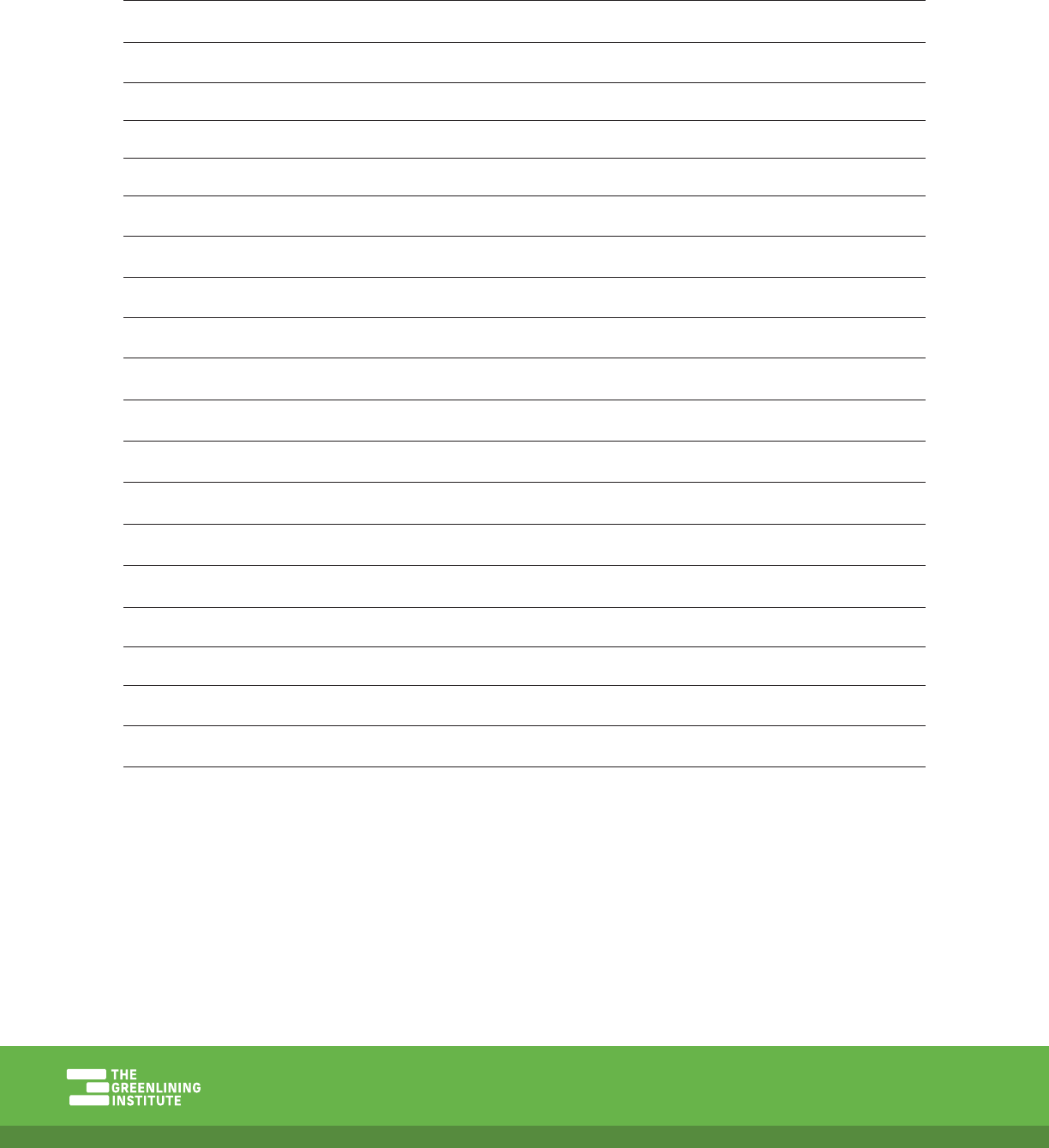
2Home Lending to Communities of Color in California | MARCH 2023
Table of Contents
Executive Summary 5
Introduction 8
Slow homeownership rates for communities of color 8
The racial wealth divide 9
Comparing conventional and government-subsidized loans 10
Changes in home lending and the need to protect consumers 11
Methodology 13
Findings 15
State of Home Lending in California 15
Sacramento-Roseville-Folsom MSA 18
San Francisco-San Mateo-Redwood City MSA 24
Oakland-Berkeley-Livermore MSA 30
Fresno MSA 36
Los Angeles-Long Beach-Glendale MSA 42
San Diego-Chula Vista-Carlsbad MSA 48
Policy Recommendations 54
For Legislators and Financial Regulators: 55
For Lenders 56
References 58
Endnotes 60

3Home Lending to Communities of Color in California | MARCH 2023
AUTHORS
Marwa Abubakr is an Economic Equity Fellow at the Greenlining Institute, where she supports the
organization’s research and advocacy eorts to close the racial and gender wealth gap. Being the product
of Afghan refugees, navigating life in a diaspora community, the politics of poverty and discrimination
have always been prevalent in her life. Marwa has passionately dedicated her career towards upliing
and empowering marginalized communities. She spent two years in AmeriCorps service working to
expand literacy development in underserved elementary schools in Oakland. Through her experience in
financial analytics at Morgan Stanley, Marwa was able to grasp how our financial systems stand to benefit
those with the most privilege, driving her dedication towards economic equity. She has since worked at
multiple nonprofit organizations in the Bay Area supporting research and data analytics. Marwa holds a
B.A. in Political Science from the University of California, Berkeley.
Rawan Elhalaby is the Associate Director, Economic Equity at The Greenlining Institute, where she leads
the organization’s research eorts around bank accountability and financial inclusion. As the daughter
of Palestinian, working-class refugees, Rawan is all too familiar with the obstacles that low-income
and immigrant families face in achieving self-suiciency in the United States. She has spent her career
fighting barriers to economic opportunity through direct service at the International Rescue Committee
in San Diego and through policy as a consultant to the Consumer Financial Protection Bureau, the County
of San Diego, the Western Regional Advocacy Project and the Dellums Institute for Social Justice. Rawan
holds a Master of Public Policy from UC Berkeley’s Goldman School of Public Policy and a B.A. in Political
Science from San Diego State University.
Rawan co-authored Greenlining’s recent report, A Fair Financial System, testified before the House
Financial Services Committee’s Subcommittee on Diversity and Inclusion on the lack of diversity in
banks, and has been quoted in a variety of publications ranging from American Banker to Politico.
Editorial:
Danielle Bell, Senior Program Manager of Media Relations at The Greenlining Institute
Tram Quang, Copyeditor
Design:
Zhanae Briggs, Communications Coordinator at The Greenlining Institute
Design Action Collective
ACKNOWLEDGEMENTS
Thank you to Rami Ibrahim, Economic Equity Coordinator at The Greenlining Institute, for his
contributions to transcribing the HMDA data and bolstering GLI’s California State CRA platform.
And thank you to Holden Weisman, Senior Director of Economic Equity at The Greenlining Institute,
for his feedback on our research and review.

4Home Lending to Communities of Color in California | MARCH 2023
THE GREENLINING INSTITUTE
The Greenlining Institute works towards a future where communities of color can build wealth, live
in healthy places filled with economic opportunity, and are ready to meet the challenges posed by
climate change. Greenlining is building an abundant future that brings investments and opportunities
into our communities – what we call Greenlining. Since 1993, we have successfully advocated and
negotiated initiatives directing more than $800 billion in corporate and public investments into
communities of color in California and across the nation.
ECONOMIC EQUITY
The Greenlining Institute’s Economic Equity program advocates for race-conscious policies that hold
financial institutions accountable, end discriminatory practices, and establish pathways to financial
security and prosperity. We are building a future where more people of color are homeowners,
business owners, and have access to wealth-building infrastructure such as high-speed internet for
generations to come.

5Home Lending to Communities of Color in California | MARCH 2023
Executive Summary
California is one of the most racially diverse states in the country, yet its homeownership and home
purchase loan origination rates do not reflect this diversity. Homeownership is one major pathway
to building family wealth, yet owning a home continues to be out of reach for most people of color in
California.
The Greenlining Institute assessed Home Mortgage Disclosure Act lending data from six metropolitan
areas of California: Sacramento, San Francisco, Oakland, Fresno, Los Angeles, and San Diego. This
report evaluates the lending overall in these regions, and the top 15 lenders in each region for 2021.
Although there are slight variations among the largest lenders for each region, the findings across the
regions were consistent.
Findings:
• Communities of color do not access home purchase loans at rates comparable to white
communities. Latino households access 21% of the state’s home purchase loans, despite
making up over 40% of the population, and Black households access 3% of home loans, while
making up over 5% of the population. White households are especially overrepresented in home
purchase originations relative to their share of the population, and Asian households are slightly
overrepresented.
• Women of color, 30% of the state’s population, receive just 8% of home purchase loans by the
top 15 lenders in California, consistent with 2020. Women of color are also more likely to access
a loan from a nonbank lender than from a mainstream bank. The disproportionate caretaking
burdens and responsibilities of women of color are compounded by the gender pay gap and racial
wealth gap—all of which are compounded by an inability to access home loans.
Photo credit: Kadyn Pierce via Unsplash
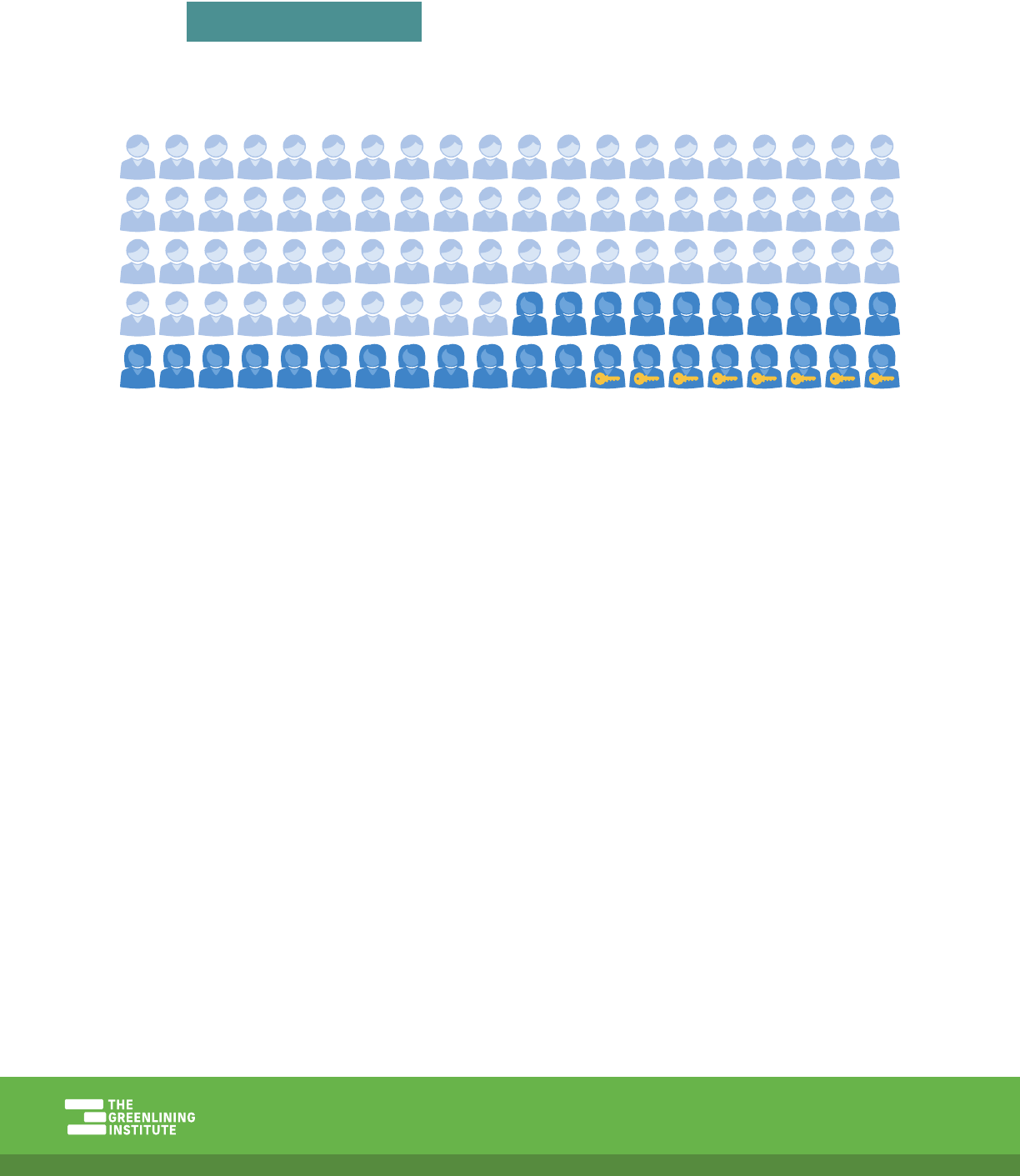
6Home Lending to Communities of Color in California | MARCH 2023
Only EIGHT PERCENT of the home loans made by the
major lenders in California are to women of color, but they
make up 30% of the state’s population.
• Asian ethnic communities do not access home loans at the same rate. While home lending to
all Asian households in California appears to exceed their share of the population—rising to 19.4%
in 2021 from 15.5% in 2020—there are disparities in access for dierent subgroups within the Asian
population, emphasizing the need to collect and disaggregate lending data.
• Nonbank lenders are more likely to make home loans to low-income borrowers than
traditional banks—with both conventional and government-subsidized loans.
• Low-income white borrowers are more likely than low-income borrowers of color to receive
a home loan in over half of the six regions proportional to their percentage of the population.
Low-income Black and Latino borrowers are more likely to receive home purchase loans from
nonbank lenders proportional to their percentage of the population.
• Nonbank lenders dominate several regional markets in California and play an increasing
role in home lending across the state. Ten of the top 15 home purchase lenders are largely
unregulated nonbanks that do not oer traditional banking services and operate largely online.
These nonbank lenders are also not subject to the Community Reinvestment Act, therefore their
lending is not regularly assessed to determine whether they meet the credit and borrowing needs
of the communities where they operate. Like last year, Black and Latino households were more
likely than other racial groups to access home purchase loans from nonbank lenders. In the Fresno
Metropolitan Area, all 15 of the top 15 lenders were nonbanks.
• Low-income and people of color borrowers are more highly represented in government-
subsidized loans than conventional loans, consistent with nationwide trends. Some lending
institutions in this study did not issue any government-subsidized loans in some areas in 2021,
and these loans represent a smaller part of the market than conventional loans. Black and Latino
borrowers are particularly likely to receive government-subsidized loans.
Figure 1: Home Purchase Loans by Race and Gender

7Home Lending to Communities of Color in California | MARCH 2023
Key Recommendations:
• The state should create a California Community Reinvestment Act. Unlike traditional banks,
nonbank lenders are not covered by the federal Community Reinvestment Act despite the
similarities in their products and services. Nonbank lenders should have the same mandate to
serve low-to-moderate-income communities as traditional bank lenders, and this mandate can
come from the state. A state CRA can expand beyond the many limitations of the current federal
law. State governments in Connecticut, Illinois, Massachusetts, and New York have already passed
state CRA legislation.
• The federal government should strengthen the Home Mortgage Disclosure Act. It should be
made stronger, more accessible, and with easier-to-access data that is disaggregated by dierent
racial and ethnic communities. At the state level, California regulators should help to lead this
discussion with respect to nonbank lenders licensed by the state.
• Lenders should provide more loan products and outreach tailored to low- to moderate income
families. Financial institutions should increase mortgage originations to communities of color
through alternative products to government-subsidized loans.
• Lenders should provide more support to nonprofit organizations led by people of color that
provide homeownership counseling. They must also improve the cultural competency of their
products and marketing, and make use of ethnic media outlets to reach communities of color.
The gap in homeownership rates between California and the national average continues to persist
in 2021, with California lagging 11 percentage points behind at a rate of 54.2%. Consistent with
last year’s findings, rates of Black and Latino homeownership are significantly lower in California
than the national averages. According to the latest available data from 2020, in California the Black
homeownership rate is 37% compared to 44% nationally. The Latino homeownership rate in California
stands at 46% and 48% nationally.
Home lenders, including both traditional banks and nonbank lenders, have an important role to play
in ensuring that all communities have access to aordable, safe home loans that increase family
wealth and reduce the racial wealth gap.
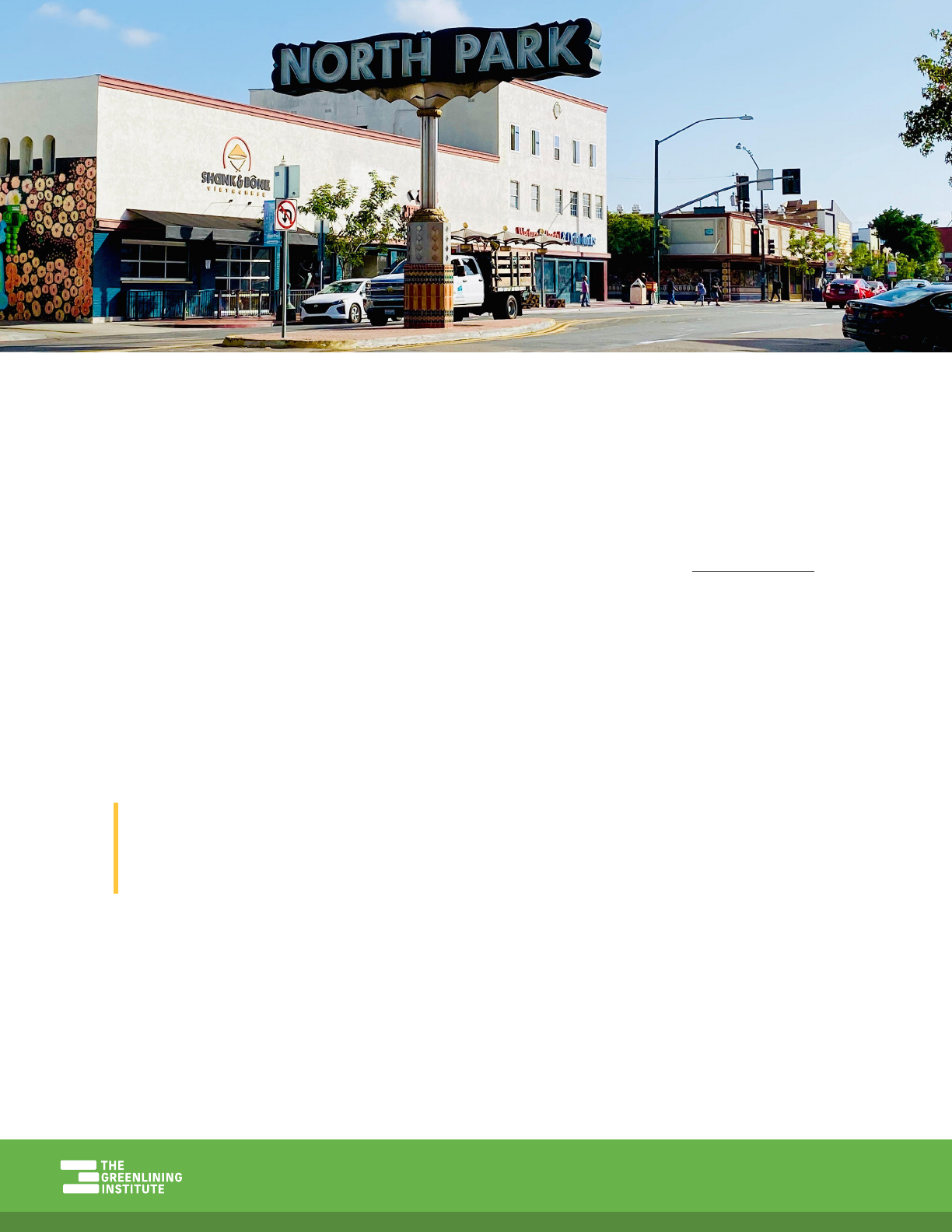
8Home Lending to Communities of Color in California | MARCH 2023
Introduction
The Greenlining Institute envisions a future where housing is a human right and contributes to healthy,
resilient communities for all. We believe that every Californian should be able to live in a home that
is aordable, safe, resilient to the impacts of climate change, and contributes to equitable wealth-
building rather than dragging people down further into debt. Under Greenlining’s housing platform,
we work to equitably increase access to capital, economic and homeownership opportunities for
people of color in California.
1
Homeownership continues to be the primary path for wealth-building for families in California
and throughout the U.S. Unfortunately, that path is far less open to Black, Latino, and many other
communities of color than it is for white potential home buyers. Ongoing impacts of the pandemic
and rising interest rates appear to be making the situation worse. However, increasing access to
homeownership is one of the most important ways to address the racial wealth gap and for families to
build wealth.
Slow homeownership rates for communities of color
Between 2019 and 2021, Black and Latino homeownership rates increased nationally.
2
With increases
of 2% and 2.5% percent respectively, the rates of increase exceed that of white homeowners.
Historically low interest rates were key contributors to the rise in Black and Latino homeownership. In
2021, interest rates were below 3% on average for a 30-year fixed rate mortgage, similar to 2020.
3
Since
then, interest rates have soared to record highs, posing a threat to the sustainability of increasing
Black and Latino homeownership.
Photo credit: Taylor Rooney via Unsplash
As of October 2021, 19% of all households report having lost all their
savings during the pandemic, but the number is higher among Black
and Latino households at 31% and over 25% respectively.

9Home Lending to Communities of Color in California | MARCH 2023
In addition, we saw a significant rise in home prices between 2020 and 2022 as well as the highest
level of non-housing inflation since the Great Recession. The Federal Reserve has found that important
contributors to rising inflation rates are increased consumption and decreased price sensitivity as a
result of gaining wealth.
4
In order to combat inflation, the Federal Reserve has raised interest rates in
an eort to discourage borrowing and spending, slowing the economy down.
Currently, inflation poses the greatest threat to low-income marginalized communities. Studies show
inflation stress impacts Black and Latino communities at higher rates than white communities, with
53.7% of Black individuals and 57.2% of Latino individuals reporting financial stresses as a result of
rising inflation compared to 43.6% of white individuals.
5
This increased financial burden has changed
the outlook for potential home buyers in 2023 and risks a further decline in access to homeownership
for communities of color.
Home appraisal bias is another significant disadvantage marginalized communities face when selling
their homes. The Federal National Mortgage Association analyzed nearly two million appraisals from
2019 to 2020 and found that on average Black borrowers’ homes received lower appraisal values
compared to automated models when seeking to refinance.
6
For example, in California, a Black
couple was oered $500,000 less for their home than when their home was staged to be owned by a
white family.
7
8
Additionally, during the pandemic, the wealth gap increased substantially, in part as a result of
unequal access to refinancing. The Federal Deposit Insurance Corporation (FDIC) found that in
2020, low-income borrowers were underrepresented in refinancing applications leading to a $5
billion disparity in refinancing savings between the market and the upper quintile of the income
distribution.
9
Their study further concluded that the pandemic “counteracted the stabilizing eect that
expansionary monetary policy is thought to have on inequality,” hindering the ability of marginalized
borrowers to take advantage of the opportunity to lower their mortgages and build wealth.
The racial wealth divide
The legacy of racism and injustice in the housing market is undeniable – that’s why Greenlining
advances anti-racist policies that promote housing as a human right. In the past two years, the racial
wealth divide has only been exacerbated through the unequal financial toll of the pandemic and its
economic impact. Black and Latino households have consistently been less likely to have liquid assets
or savings that can help them weather economic storms. As of October 2021, 19% of all households
report having lost all their savings during the pandemic, but the number is higher among Black and
Latino households at 31% and over 25% respectively.
10
As housing prices across California continue to rise and the housing market expands against the
backdrop of the economic fallout of the COVID-19 pandemic, communities of color continue to be
disproportionately excluded from homeownership, and people of color do not access mortgages
at equal rates to their white counterparts across the state and country. The national Black
homeownership rate has dropped to 44%, compared to an overall national rate of 65%.
11

10Home Lending to Communities of Color in California | MARCH 2023
Intergenerational wealth transfer plays the largest role in explaining the growing racial wealth divide.
White households are far more likely than similarly situated people of color to have family that can
provide relief from debt burdens, help them weather financial emergencies, and support family
members in asset accumulation, such as assisting with mortgage down payments.
12
Women of color
are disproportionately heads of their households and bear more responsibility for providing for
children and extended family, while overcoming a gender pay gap and racial wealth gap.
13
Comparing conventional and government-subsidized loans
Our analysis distinguishes between conventional and government-subsidized loans. Conventional
loans are issued by the financial institution directly without government backing, while government-
subsidized loans are guaranteed by the government. In this report, government-subsidized loans
include loans guaranteed by the Federal Housing Administration (FHA), Veteran Aairs (VA), Rural
Housing Service (RHS), or FSA (Farm Service Agency).
Government-subsidized loans are typically easier to qualify
for than conventional loans, because government backing
against default increases lenders’ comfort levels. Borrowers
of these loans tend to have lower income and lower credit
scores, and also tend to be people of color due to a history
of economic exclusion and exploitation.
14
Conventional
loans typically oer more options related to mortgage rates,
properties available to purchase, and refinancing than
government-subsidized loans.
15
A recent survey by the National Association of Realtors found
that 89% of home sellers would likely accept a buyer with
a conventional loan whereas only 30% would likely accept
an FHA or VA loan.
16
The higher prevalence of government-
subsidized loans in communities of color, or rather the
absence of conventional loans in communities of color, raises
concerns of ongoing mortgage redlining and discriminatory
loan steering. It may indicate that lenders are illegally steering
applicants of color who could qualify for conventional
loans into government-subsidized loans, which have more
restrictive uses and rigid structures.
17
DEFINITIONS
Nonbank: In this report, “nonbank”
refers to any lender that itself does not
oer traditional banking services such
as savings or checking accounts. These
lenders are oen independent mortgage
lenders and are not regulated by the
Community Reinvestment Act.
Bank: In this report, “bank” refers to any
lender that oers deposit-based services.
They are also referred to as mainstream
or traditional banks.
Fintech: In this report, “fintech” refers to
any lending delivered through online and
digital platforms.
Low-Income: Refers to borrowers who
report an income below 80% of the
region’s Area Median Income.
The national Black homeownership rate has dropped to 44%,
compared to an overall national rate of 65%.
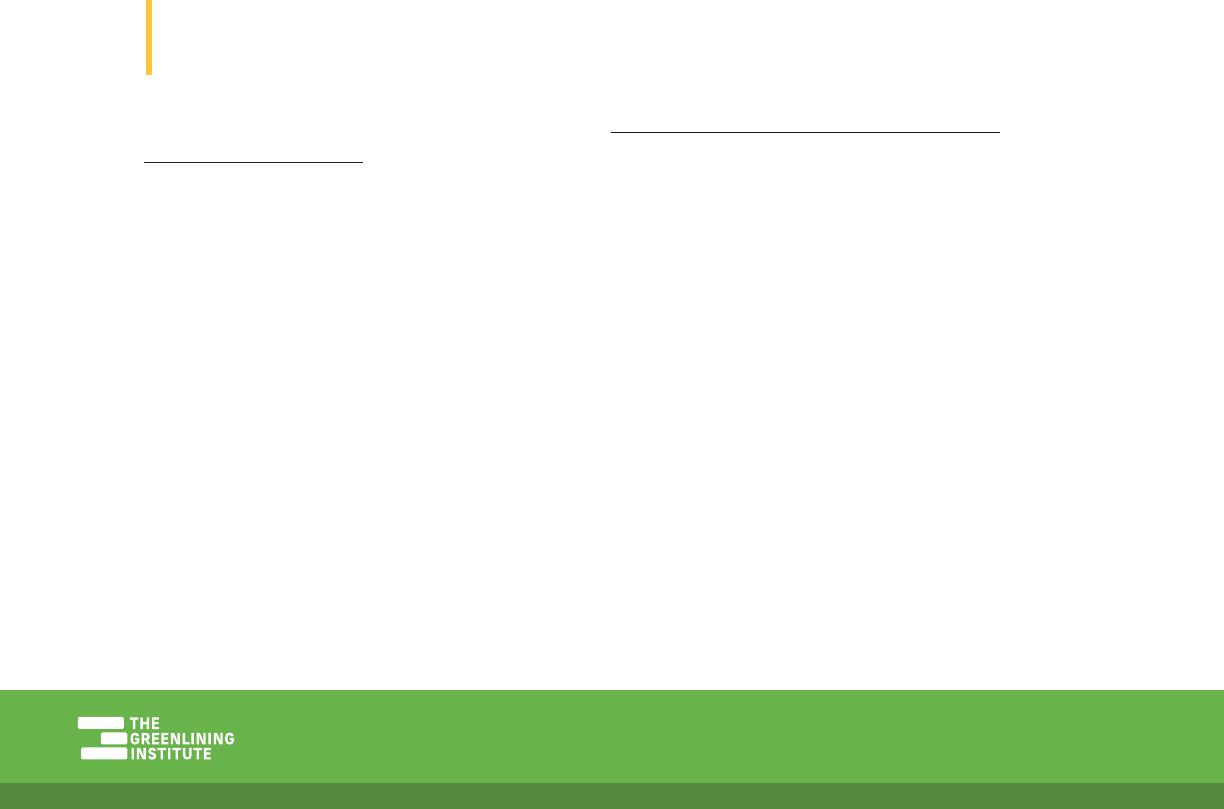
11Home Lending to Communities of Color in California | MARCH 2023
Changes in home lending and the need to protect consumers
Financial institutions continue to play a critical role in the homeownership gap between people of
color and white people. Factors involved include inaccessible products and services, lower branch
presence in communities of color, and an inability to meet the needs of communities that have long
been locked out of the traditional pathways to homeownership—pathways that include generational
wealth, financial literacy, established credit histories and higher incomes.
In addition to these financial barriers to access, people of color were more likely to be denied a
mortgage than their white counterparts, despite having similar debt-to-income ratios. Last year, The
Markup found that nationally, this disparity is driven by algorithms utilized by nonbank lenders that
disproportionately aect information input by people of color.
18
The U.S. financial system has changed significantly in the past few decades, with mergers and
acquisitions resulting in a smaller number of larger banks, each serving a greater number of people.
19
Additionally, the influence of nonbank lenders continues to grow. In 2020, 68% of all mortgages
originated in the United States were issued by nonbank lenders, marking their highest market share on
record.
20
Mergers between mainstream banks and nonbanks are predicted to increase as mainstream
banks seek to expand their markets, increase fee revenue to oset lower rates, and enhance their
digital capabilities.
21
These changes can be expected to impact the available options for financial
products and services as well as how accessible they are to dierent groups of consumers.
As noted in The Greenlining Institute’s 2021 report, A Fair Financial System: Regulating Fintech
and Nonbank Lenders, nonbank lenders are exempt from the requirements of the Community
Reinvestment Act, a federal law passed in 1977 to reverse redlining and meet the credit needs of
low-to-moderate income communities. CRA is critical for obligating banks to meet the needs of low-
to moderate income borrowers and, although race-blind, is an important tool for addressing the
widening racial wealth gap and increasing access to first-time homeownership.
Home lending is changing with the emergence of largely unregulated fintech
22
and the decreasing
presence of physical branches in many communities, particularly low-income communities and
communities of color. Nonbank lenders tend to be more eective than traditional banks at reaching
communities of color, low-income, and immigrant communities, all of which are highly vulnerable
to predatory lending. Because nonbanks are not subject to the CRA, they don’t have the same legal
obligation as traditional banks to meet the credit needs of low-to moderate income borrowers
responsibly.
23
In 2020, 68% of all mortgages originated in the United States were
issued by nonbank lenders
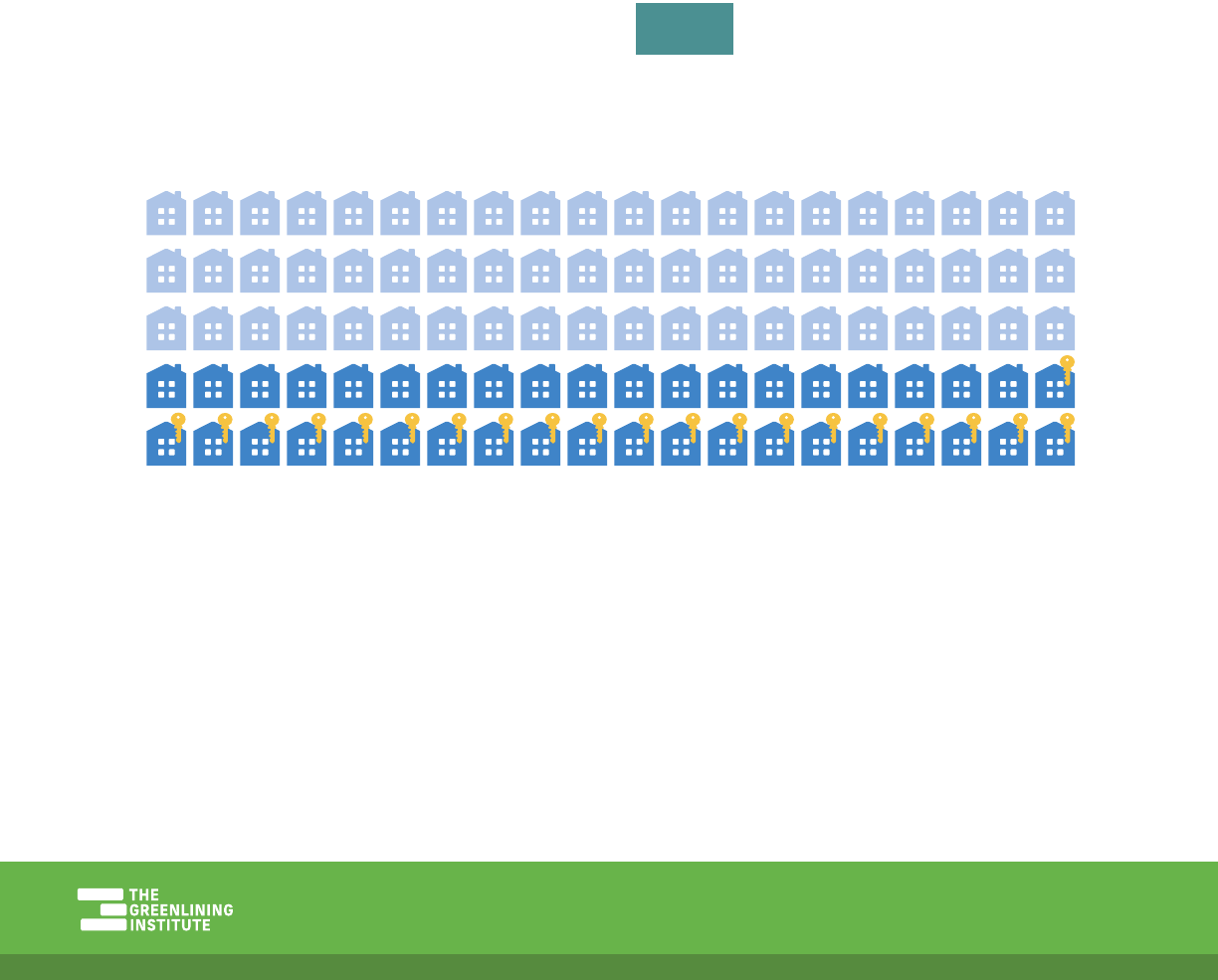
12Home Lending to Communities of Color in California | MARCH 2023
In this report, we use home mortgage data collected under the Home Mortgage Disclosure Act to
provide insight into lending patterns to communities of color in California and six major metropolitan
areas: Sacramento, San Francisco, Oakland, Fresno, Los Angeles and San Diego. HMDA requires
lenders to collect and report demographic information about borrowers, allowing advocates and
policymakers to watch for potential redlining and ensure fair lending.
The HMDA data show that people of color are significantly underrepresented in loans received
across California, and especially in urban areas such as Oakland and Los Angeles. As California’s
demographics continue to shi and communities face the ongoing impacts of rising cost of living,
our economic prosperity and resilience will increasingly depend on people of color having expanding
access to capital and opportunities to build wealth, especially homeownership, to reach their full
potential.
Latino households access 21% of the state’s
home purchase loans, despite making up over
40% of the population.
Figure 2: Home Purchase Loans by Race and Gender

13Home Lending to Communities of Color in California | MARCH 2023
Methodology
We reviewed the loans reported in the 2021 Home Mortgage Disclosure Act dataset. The study was
limited to home purchase loans for single family or manufactured homes.
This study only reflects loan origination of home purchase loans and does not address purchased
loans, which are a major source of income for many lenders and can outnumber loan originations for
some lenders.
Data was controlled for conventional and government-subsidized loan product types. Conventional
loan products include first and subordinate lien conventional loans. The Consumer Financial
Protection Bureau defines conventional loans as those not insured or guaranteed by the Federal
Housing Administration (FHA), Veteran Aairs (VA), Rural Housing Service (RHS) or FSA (Farm Service
Agency).
24
Government subsidized loan products in this report include first and subordinate (where
applicable) lien FHA, VA and FSA/RHS loans.
Loans were examined based on the income, gender and race/ethnicity of the primary borrower. In
our analysis, joint applicant borrowers were not addressed as a separate race or gender group, but
were counted toward the total loan number. This report identifies race and ethnicity in the following
manner: If the ethnicity was indicated as Hispanic, we identified the borrower as Hispanic (we use
the term Latino in this report) regardless of the race selected. If the ethnicity is non-Hispanic, the
borrower is then identified by the primary or first race they selected. Asian in this report refers to
Asian Americans, excluding Pacific Islander communities, which are classified separately. Multirace
responses are extremely rare (1% in California) in the dataset and as such are not addressed as a
separate racial group. Multirace responses were included in calculations of total people of color and
women of color.
Photo Credit: Stephen Leonardi via Unsplash

14Home Lending to Communities of Color in California | MARCH 2023
Unfortunately, approximately 20% of responses in
the dataset on average were identified as “Race Not
Available” and were not included in the calculations
of loans to households of color but were counted
toward the total loan number. As we noted last year,
this is a serious issue with HMDA data collection, and
lenders should take greater care to ensure that race is
collected for all borrowers.
This report identifies gender as utilized by the HMDA
dataset (female and male). Borrowers with “sex not
available” were not addressed as a separate category,
but were counted toward the total loan number.
The top 15 lenders for each region were identified by market share for the Metropolitan Statistical
Area.
This report uses population demographic data from 2021.
20% of responses in the dataset were
identified as “Race Not Available” and
were not included in the calculations of
loans to households of color, but were
counted toward the total loan number.
Given the missing data, in the tables
below the percent of loan originations
will not reflect all lending.This is a serious
issue with the HMDA dataset, and lenders
and regulators should take greater care to
ensure that demographic data is collected
for all borrowers.
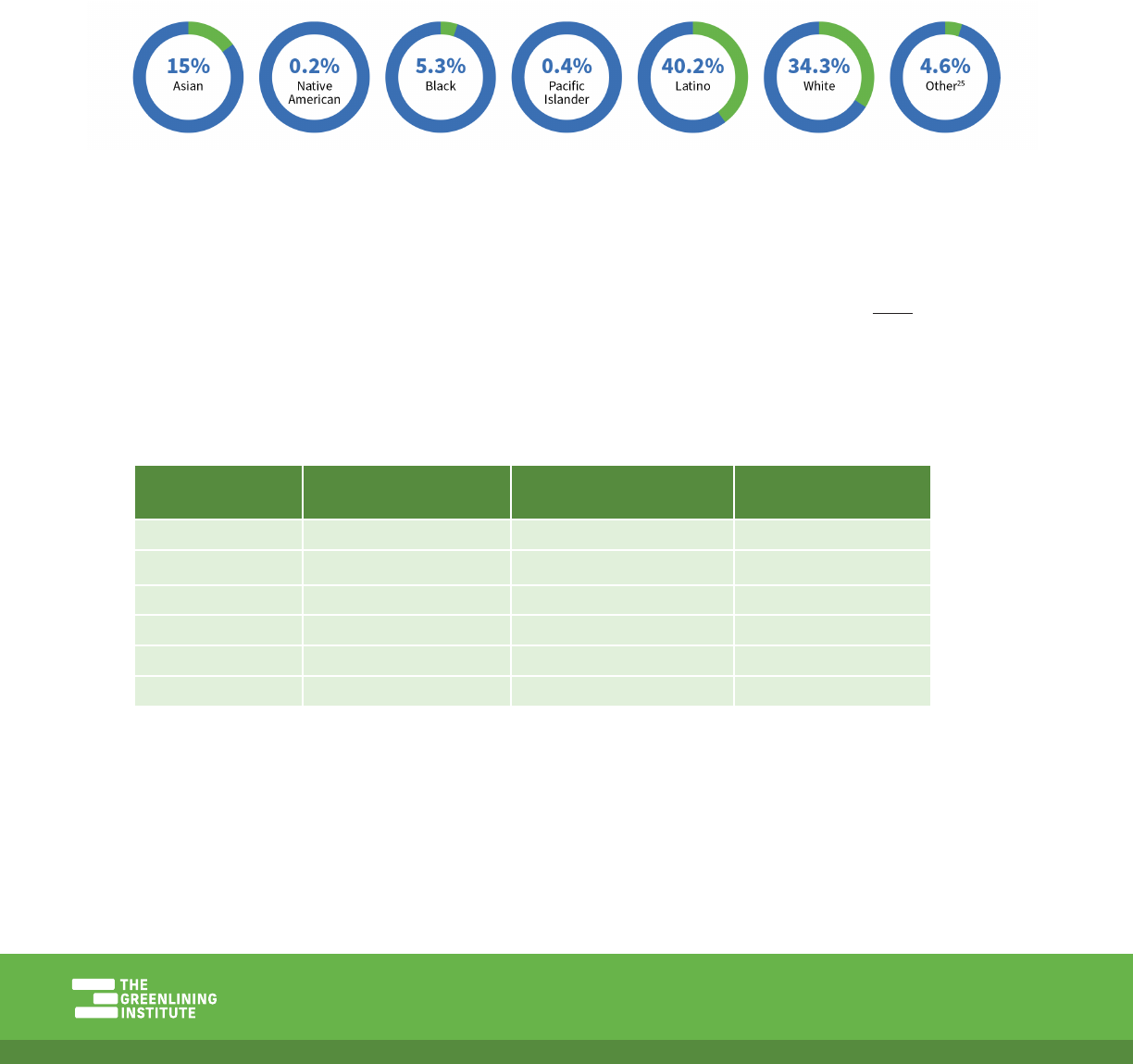
15Home Lending to Communities of Color in California | MARCH 2023
Findings
State of Home Lending in California
California lenders reported 469,212 home purchase originations in 2021.
California Demographics
Total Population: 39,237,836
++N
00++N
05++N
00++N
++N
++N
05++N
In California, Black and Latino households continue to be underrepresented in mortgage lending.
Home lending to Asian households slightly exceeded their share of the population and home lending
to white households exceeded their share of the population. Home lending rates across all groups
have not changed since Greenlining’s last statewide analysis of 2020 data, conducted in 2021.
Table 1 below illustrates the number of home purchase loan originations by race for all lenders in
California.
Table 1: Home Purchase Loans by Race for All Lenders
Race
Number of Loan
Originations
Percent of Loan
Originations Percent of Population
White 171,030 36.45% 34.30%
Asian 91,114 19.42% 15.00%
Native American 983 0.21% 0.20%
Black 15,231 3.25% 5.30%
Pacific Islander 1,073 0.23% 0.40%
Latino 97,571 20.79% 40.20%
15%
Asian
0.2%
Native
American
5.3%
Black
0.4%
Pacific
Islander
40.2%
Latino
34.3%
White
4.6%
Other
25
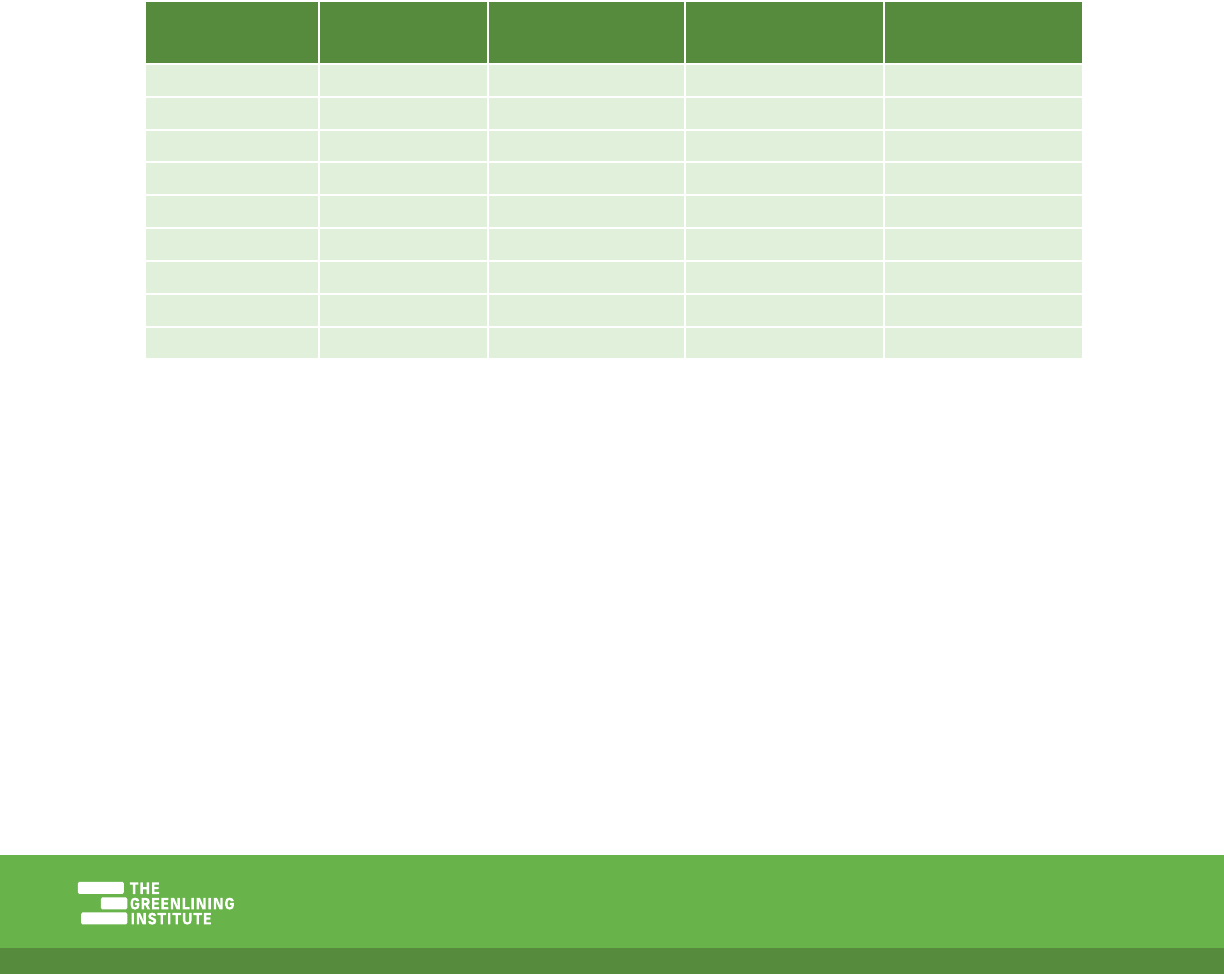
16Home Lending to Communities of Color in California | MARCH 2023
While home lending to Asian households appears to exceed their share of the population (and to
increase from 15.5% in 2020 to 19.4% in 2021), it is important to not treat the Asian population in
California as a monolith, and to disaggregate the Asian category in order to consider the dierences
in access for dierent groups. Nationally, LMI Asian American and Pacific Islanders (AAPI) are far
less likely to own a home compared to white people of the same income group—37% compared to
55%. Further, LMI Native Hawaiians and Other Pacific Islanders (NHOPI) are more than two times
less likely to own a home at 22%, and are nearly twice as likely to be denied home purchase loans
compared to white borrowers.
26
Data collected through the Home Mortgage Disclosure Act now
includes disaggregated Asian data, and we are including the data that was analyzed by Compliance
Tech in Table 2 and throughout the report for each MSA.
27
Although this data is incomplete for all Asian
borrowers, this gives us a better understanding of the state of home lending for Asian communities
in California and emphasizes the need for more targeted outreach by financial institutions, targeted
language services and supportive home counseling services to specific populations.
Table 2: Home Purchase Loans to Asian Borrowers for All Lenders
Asian Breakout
Number of Loan
Originations
Percent of Loan
Originations
Percent of Total
Loan Originations
Percent of Total
Population
Asian 18,106 19.87% 3.86% -
Asian Indian 19,142 21.01% 4.08% 2.24%
Chinese 22,888 25.12% 4.88% 3.77%
Filipino 9,285 10.19% 1.98% 3.21%
Japanese 1,227 1.35% 0.26% 0.65%
Korean 6,083 6.68% 1.30% 1.17%
Vietnamese 6,086 6.68% 1.30% 1.70%
Asian Other 5,294 5.81% 1.13% 1.72%
28
Multi-Asian 3,003 3.30% 0.64% 0.54%
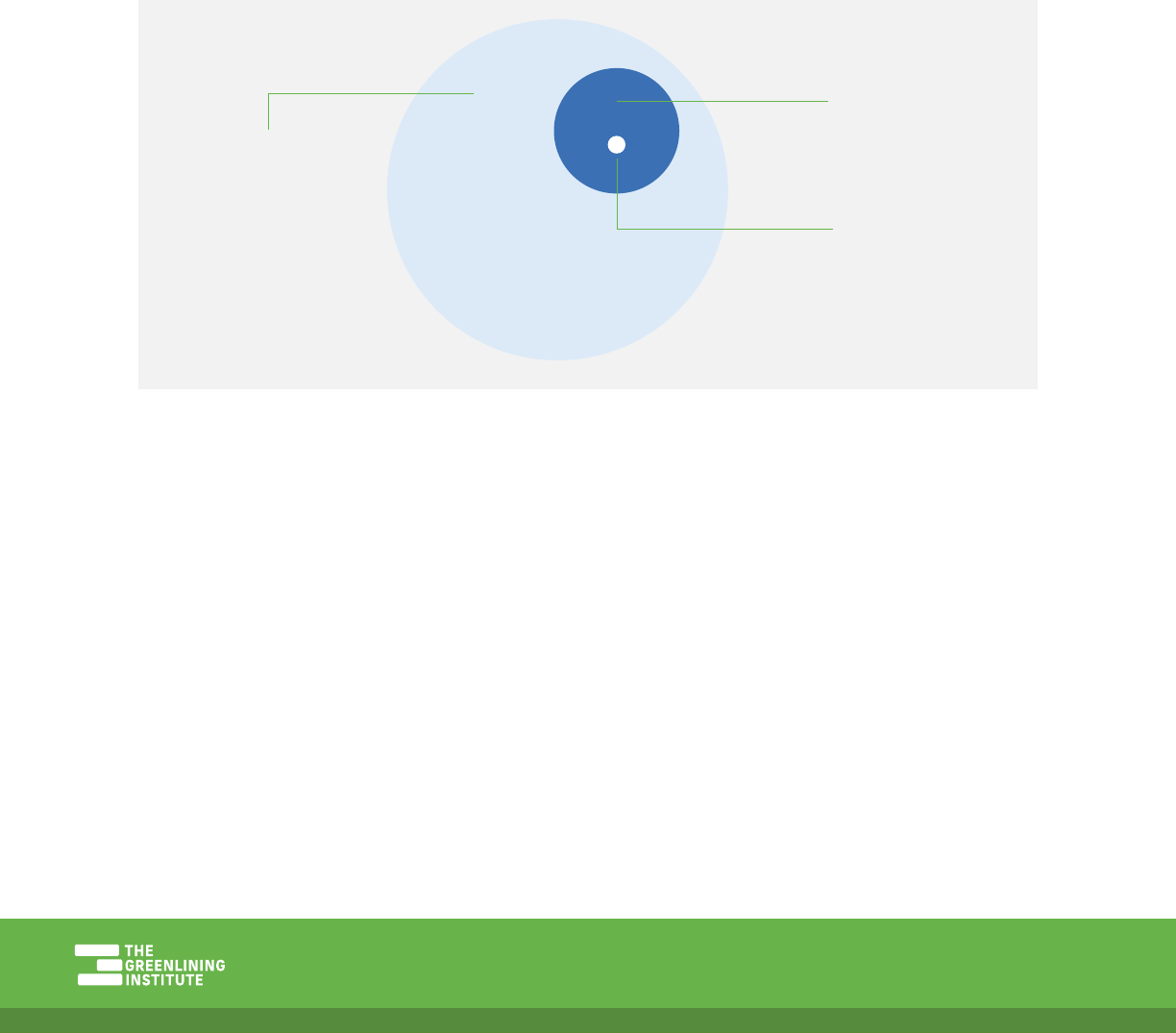
17Home Lending to Communities of Color in California | MARCH 2023
Top 15 Lenders in Six Metropolitan Areas of California:
For the regional analysis, we studied six metropolitan regions: Sacramento, San Francisco, Oakland,
Fresno, Los Angeles and San Diego. The analysis evaluated the top 15 lenders of each MSA by:
• Home purchase originations by race;
• Home purchase originations by race and gender, focusing on loans to women of color;
• Home purchase originations by borrower income, and;
• Home purchase originations by borrower income and race.
Table 2: Home Purchase Loans by Race and Gender
39,237,836
California Population
Women of Color
comprise
30%
of CA’s population
take out
8%
of home purchase loans
Eight percent of the home purchase loans made by the top 15 lenders are to women of color, who
comprise 30% of the state’s population.
29
This rate is consistent with last year.
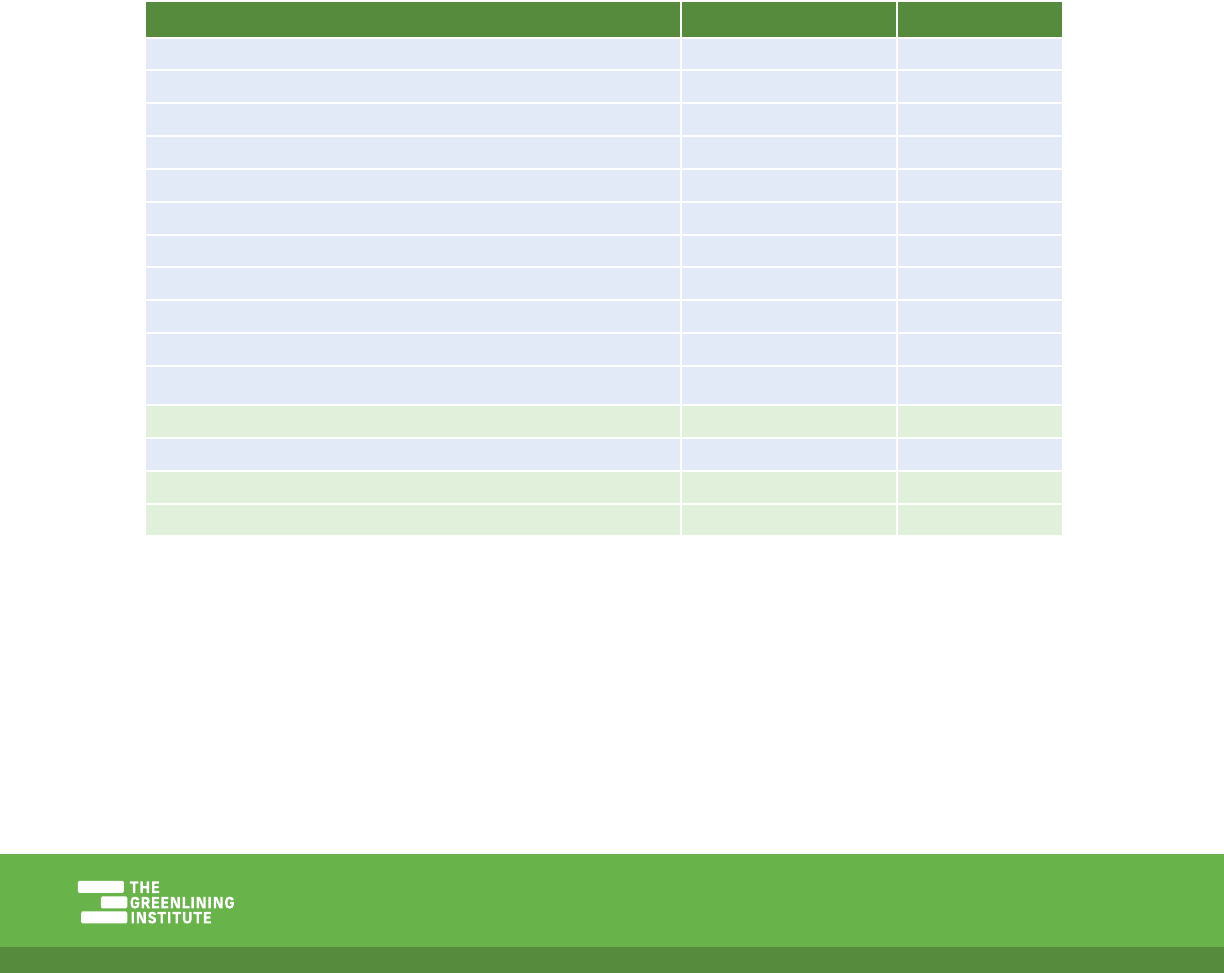
18Home Lending to Communities of Color in California | MARCH 2023
Sacramento-Roseville-Folsom
MSA
Total Population: 2,411,428, 6.15% of California’s population
Sacramento MSA Demographics
Overview of Lending in Sacramento-Roseville-Folsom MSA
Lender Type of Lender % of Market
United Wholesale Mortgage Non-Bank 15.25%
Rocket Mortgage Non-Bank 6.24%
American Pacific Mortgage Corporation Non-Bank 4.61%
Guild Mortgage Company Non-Bank 4.14%
Loandepot.com Non-Bank 3.85%
Finance of America Mortgage Non-Bank 3.84%
Home Point Financial Corporation Non-Bank 2.50%
Movement Mortgage Non-Bank 2.48%
Caliber Home Loans Non-Bank 2.26%
Fairway Independent Mortgage Corporation Non-Bank 2.25%
Lennar Mortgage Non-Bank 2.20%
Wells Fargo Bank, National Association Bank 2.13%
Summit Funding Non-Bank 2.03%
U.S. Bank, National Association Bank 1.48%
Flagstar Bank Bank 1.36%
*Nonbank lenders are highlighted.
In the Sacramento region, Black, Latino and Pacific Islander communities receive fewer loans relative
to their share of the population than other racial groups in the region. Latino households receive just
14% of home purchase loans, while making up 23% of the population.
++N
00++N
07++N
01++N
++N
++N
07++N
14.3%
Asian
0.2%
Native
American
6.8%
Black
0.8%
Pacific
Islander
22.7%
Latino
48.4%
White
6.8%
Other
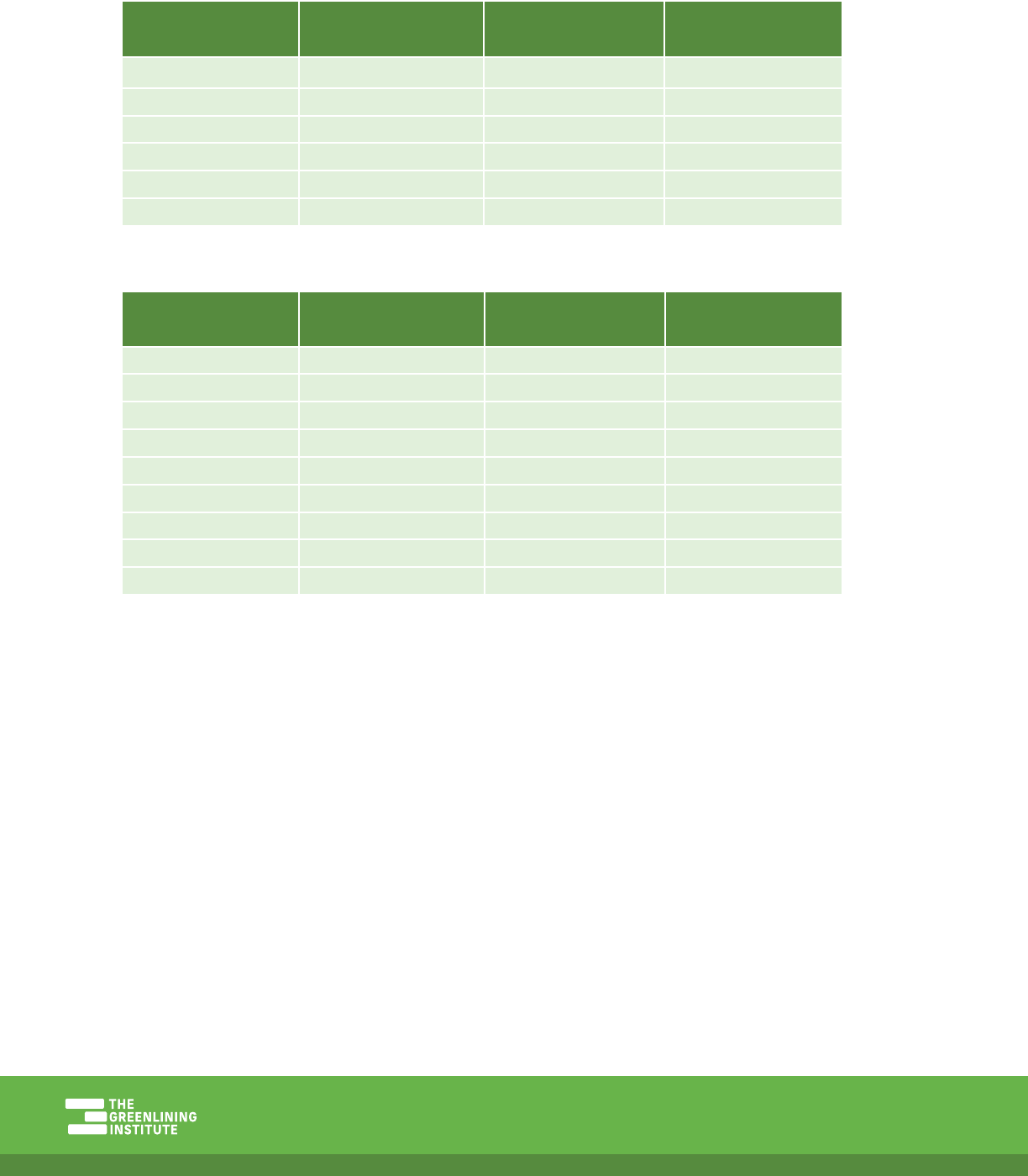
19Home Lending to Communities of Color in California | MARCH 2023
Table 3: Home Purchase Loans by Race for All Lenders
Race
Number of Loan
Originations
Percent of Loan
Originations Percent of Population
White 17,249 42.88% 48.40%
Asian 6,960 17.30% 14.30%
Native American 124 0.31% 0.20%
Black 1,687 4.19% 6.80%
Pacific Islander 190 0.47% 0.80%
Latino 5,472 13.60% 22.70%
Table 4: Home Purchase Loans to Asian Borrowers for All Lenders
Race
Number of Loan
Originations
Percent of Loan
Originations
Percent of Total Loan
Originations
Asian 1,287 18.49% 3.20%
Asian Indian 1,569 22.54% 3.90%
Chinese 1,270 18.25% 3.16%
Filipino 994 14.28% 2.47%
Japanese 93 1.34% 0.23%
Korean 196 2.82% 0.49%
Vietnamese 602 8.65% 1.50%
Asian Other 635 9.12% 1.58%
Multi-Asian 314 4.51% 0.78%
Top 15 Lenders in Sacramento-Roseville-Folsom MSA
The top 15 lenders in the Sacramento region account for 57% of the market. Similar to last year,
nonbank lenders make up 12 of the top 15 lenders. The top lender, United Wholesale Mortgage,
accounts for 15% of all loan originations.
Table 5 below illustrates the number of home purchase loan originations by race for each of the top
15 lenders in the Sacramento MSA in 2021. A majority of loans across both loan product types for each
institution are issued to White borrowers.
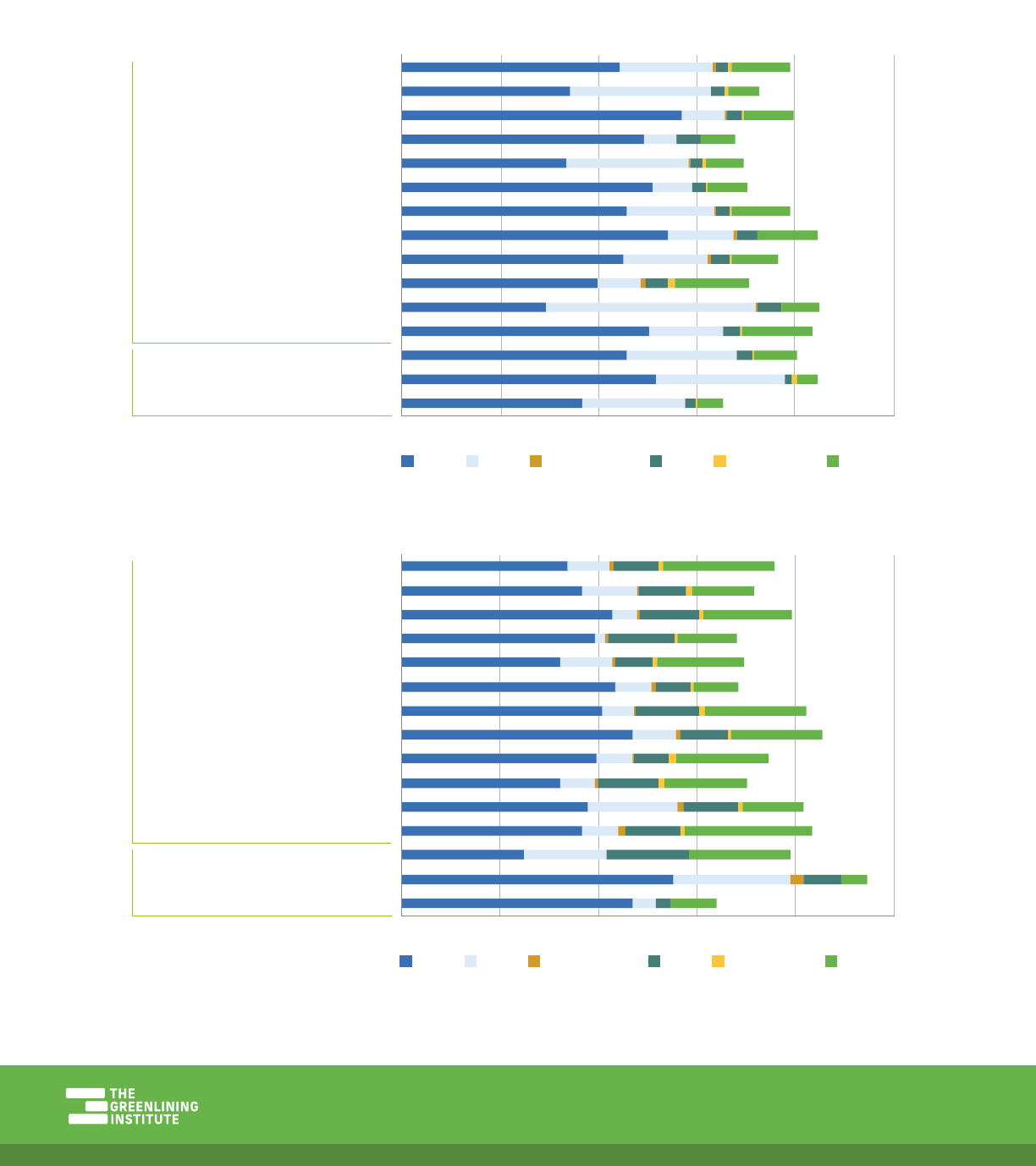
20Home Lending to Communities of Color in California | MARCH 2023
Table 5: Home Purchase Loans by Race
White Asian Native American Black Pacific Islander Latino
UNITED WHOLESALE MORTGAGE
ROCKET MORTGAGE
AMERICAN PACIFIC MORTGAGE
GUILD MORTGAGE COMPANY
LOANDEPOT.COM
FINANCE OF AMERICA MORTGAGE
HOME POINT FINANCIAL
MOVEMENT MORTGAGE
CALIBER HOME LOANS
FAIRWAY INDEPENDENT MORTGAGE
LENNAR MORTGAGE
SUMMIT FUNDING
WELLS FARGO BANK
U.S. BANK
FLAGSTAR BANK
0% 20% 40% 60% 80% 100%
Nonbank
Bank
White Asian Native American Black Pacific Islander Latino
UNITED WHOLESALE MORTGAGE
ROCKET MORTGAGE
AMERICAN PACIFIC MORTGAGE
GUILD MORTGAGE COMPANY
LOANDEPOT.COM
FINANCE OF AMERICA MORTGAGE
HOME POINT FINANCIAL
MOVEMENT MORTGAGE
CALIBER HOME LOANS
FAIRWAY INDEPENDENT MORTGAGE
LENNAR MORTGAGE
SUMMIT FUNDING
WELLS FARGO BANK
U.S. BANK
FLAGSTAR BANK
0% 20% 40% 60% 80% 100%
Nonbank
Bank
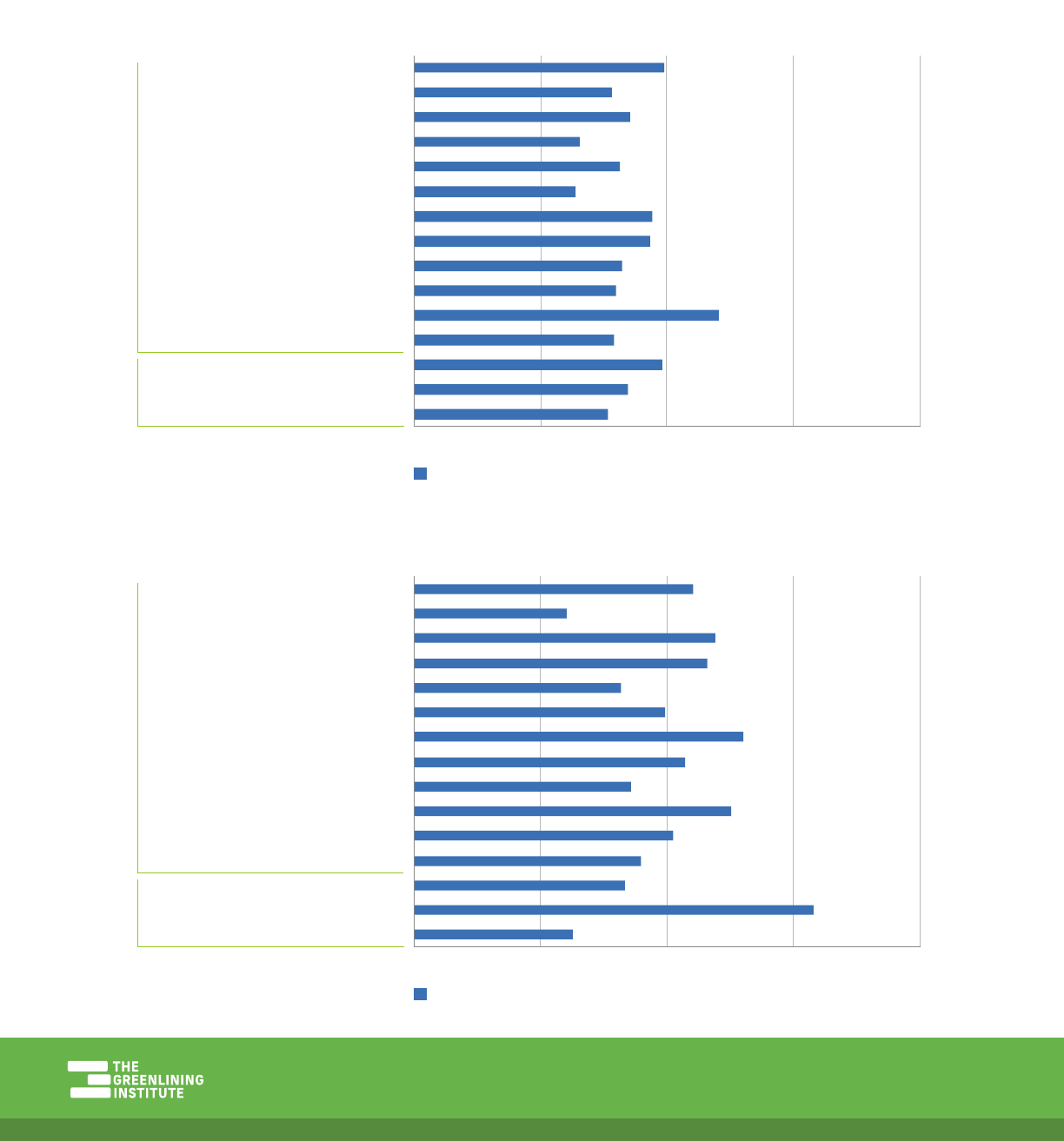
21Home Lending to Communities of Color in California | MARCH 2023
Table 6 illustrates the number of home purchase loan originations for women-identified people of
color (non-White) for each of the top 15 lenders in the Sacramento MSA in 2021.
Table 6: Home Purchase Loans to Women of Color
UNITED WHOLESALE MORTGAGE
ROCKET MORTGAGE
AMERICAN PACIFIC MORTGAGE
GUILD MORTGAGE COMPANY
LOANDEPOT.COM
FINANCE OF AMERICA MORTGAGE
HOME POINT FINANCIAL
MOVEMENT MORTGAGE
CALIBER HOME LOANS
FAIRWAY INDEPENDENT MORTGAGE
LENNAR MORTGAGE
SUMMIT FUNDING
WELLS FARGO BANK
U.S. BANK
FLAGSTAR BANK
0% 5% 10% 15% 20%
Nonbank
Bank
WoC (non-White)
UNITED WHOLESALE MORTGAGE
ROCKET MORTGAGE
AMERICAN PACIFIC MORTGAGE
GUILD MORTGAGE COMPANY
LOANDEPOT.COM
FINANCE OF AMERICA MORTGAGE
HOME POINT FINANCIAL
MOVEMENT MORTGAGE
CALIBER HOME LOANS
FAIRWAY INDEPENDENT MORTGAGE
LENNAR MORTGAGE
SUMMIT FUNDING
WELLS FARGO BANK
U.S. BANK
FLAGSTAR BANK
0% 5% 10% 15% 20%
Nonbank
Bank
WoC (non-White)

22Home Lending to Communities of Color in California | MARCH 2023
Table 7 below illustrates the number of home purchase loan originations to low-income borrowers,
defined as borrowers who report an income below 80% of the region’s Area Median Income, for each
of the top 15 lenders in the Sacramento MSA in 2021. On average, a higher percentage of low-income
borrowers are served by nonbanks than mainstream banks.
Table 7: Home Purchase Loans to Low-Income Borrowers
UNITED WHOLESALE MORTGAGE
ROCKET MORTGAGE
AMERICAN PACIFIC MORTGAGE
GUILD MORTGAGE COMPANY
LOANDEPOT.COM
FINANCE OF AMERICA MORTGAGE
HOME POINT FINANCIAL
MOVEMENT MORTGAGE
CALIBER HOME LOANS
FAIRWAY INDEPENDENT MORTGAGE
LENNAR MORTGAGE
SUMMIT FUNDING
WELLS FARGO BANK
U.S. BANK
FLAGSTAR BANK
0% 10% 20% 30% 40%
Nonbank
Bank
Borrowers < 80% of AMI
UNITED WHOLESALE MORTGAGE
ROCKET MORTGAGE
AMERICAN PACIFIC MORTGAGE
GUILD MORTGAGE COMPANY
LOANDEPOT.COM
FINANCE OF AMERICA MORTGAGE
HOME POINT FINANCIAL
MOVEMENT MORTGAGE
CALIBER HOME LOANS
FAIRWAY INDEPENDENT MORTGAGE
LENNAR MORTGAGE
SUMMIT FUNDING
WELLS FARGO BANK
U.S. BANK
FLAGSTAR BANK
0% 10% 20% 30% 40%
Nonbank
Bank
Borrowers < 80% of AMI
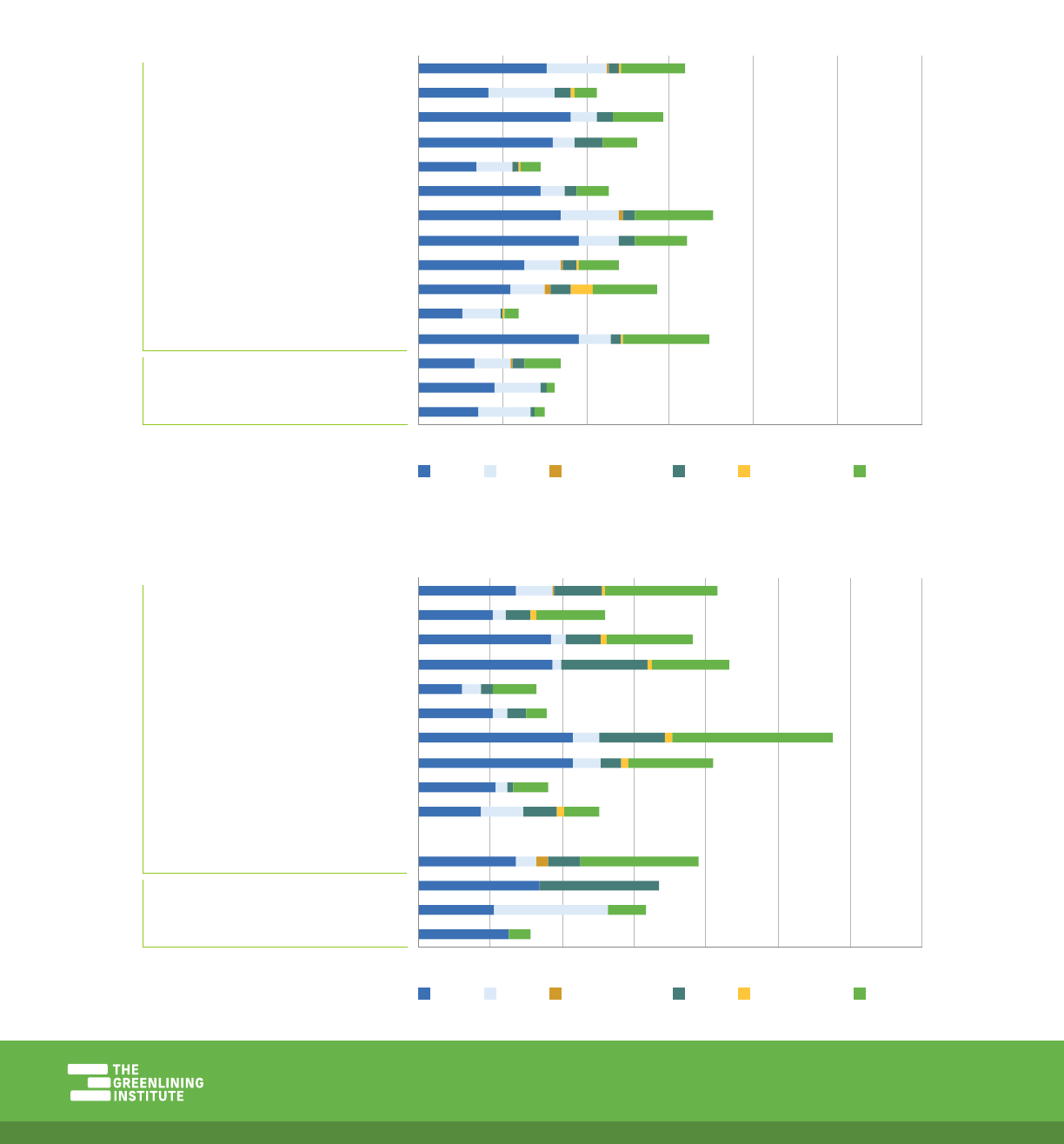
23Home Lending to Communities of Color in California | MARCH 2023
Table 8 below illustrates the number of home purchase loan originations to low-income borrowers by
race for each of the top 15 lenders in the Sacramento MSA in 2021.
Table 8: Home Purchase Loans to Low-Income Borrowers by Race
UNITED WHOLESALE MORTGAGE
ROCKET MORTGAGE
AMERICAN PACIFIC MORTGAGE
GUILD MORTGAGE COMPANY
LOANDEPOT.COM
FINANCE OF AMERICA MORTGAGE
HOME POINT FINANCIAL
MOVEMENT MORTGAGE
CALIBER HOME LOANS
FAIRWAY INDEPENDENT MORTGAGE
LENNAR MORTGAGE
SUMMIT FUNDING
WELLS FARGO BANK
U.S. BANK
FLAGSTAR BANK
0% 10%5% 15%
20%
25% 30%
Nonbank
Bank
White Asian Native American Black Pacific Islander Latino
UNITED WHOLESALE MORTGAGE
ROCKET MORTGAGE
AMERICAN PACIFIC MORTGAGE
GUILD MORTGAGE COMPANY
LOANDEPOT.COM
FINANCE OF AMERICA MORTGAGE
HOME POINT FINANCIAL
MOVEMENT MORTGAGE
CALIBER HOME LOANS
FAIRWAY INDEPENDENT MORTGAGE
LENNAR MORTGAGE
SUMMIT FUNDING
WELLS FARGO BANK
U.S. BANK
FLAGSTAR BANK
Nonbank
Bank
White Asian Native American Black Pacific Islander Latino
0% 10%5% 15%
20%
25% 30%
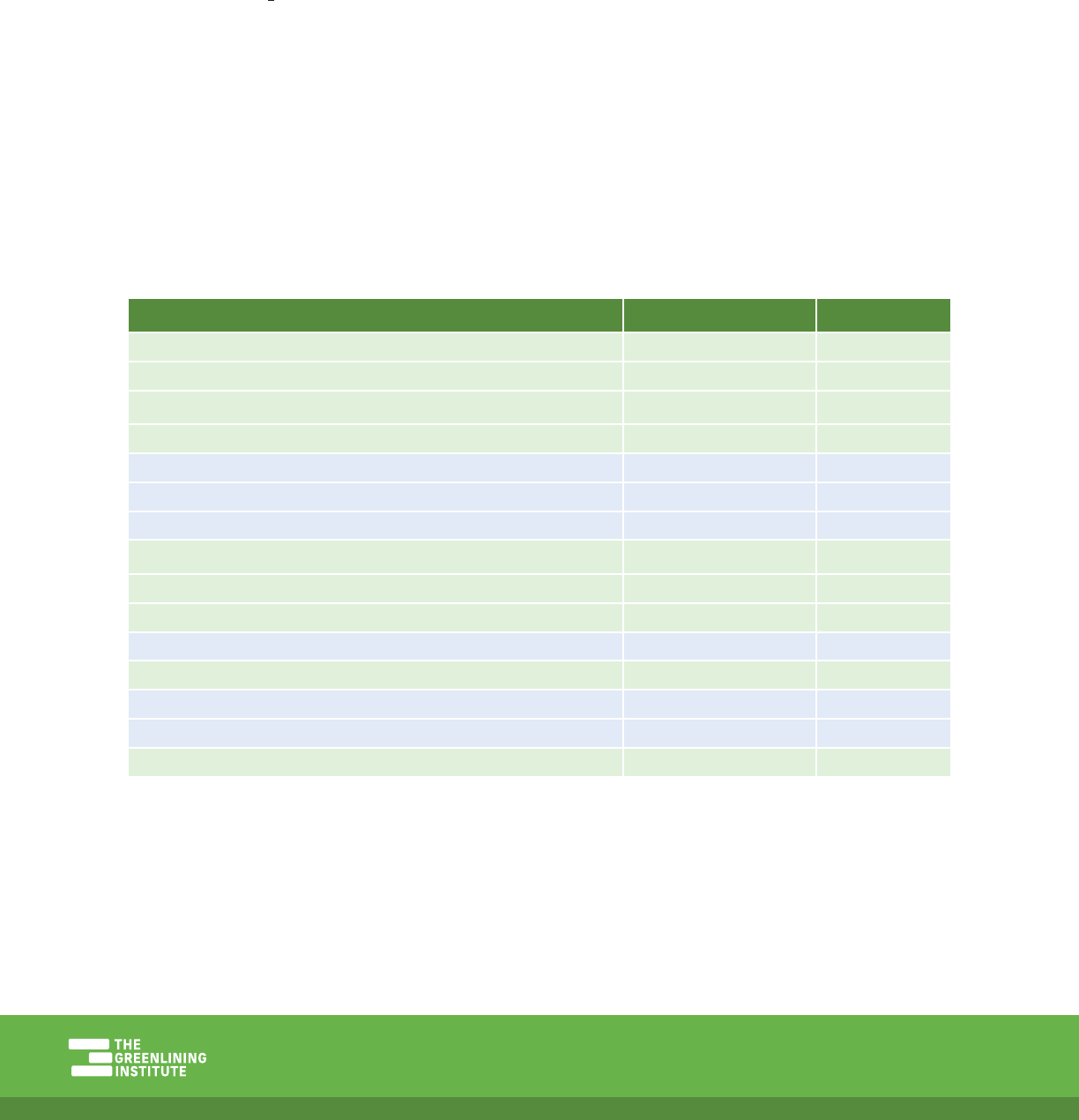
24Home Lending to Communities of Color in California | MARCH 2023
San Francisco-San Mateo-
Redwood City MSA
Total Population: 1,553,089, 3.96% of California’s population
San Francisco-San Mateo-Redwood City MSA Demographics
Overview of Lending in San Francisco-San Mateo-Redwood
City MSA
Lender Type of Lender % of Market
Wells Fargo Bank Bank 15.65%
First Republic Bank Bank 11.06%
Bank of America Bank 6.40%
JPMorgan Chase Bank Bank 4.90%
Rocket Mortgage Non-Bank 3.49%
Guaranteed Rate Non-Bank 3.47%
United Wholesale Mortgage Non-Bank 3.31%
Citibank Bank 3.25%
U.S. Bank Bank 3.19%
PNC Bank Bank 2.98%
Loandepot.com Non-Bank 2.03%
Flagstar Bank Bank 1.98%
Amwest Funding Non-Bank 1.90%
Guaranteed Rate Ainity Non-Bank 1.90%
MUFG Union Bank Bank 1.89%
*Nonbank lenders are highlighted.
In the San Francisco region, Black and Latino communities receive far fewer loans relative to their
share of the population than other racial groups in the region. Black households receive below 1% of
home purchase loans, while making up 4% of the population. Latino households receive just 5% of
home purchase loans, while making up 20% of the population.
++N
00++N
04++N
01++N
++N
++N
06++N
33.1%
Asian
0.1%
Native
American
3.7%
Black
0.8%
Pacific
Islander
19.6%
Latino
36.4%
White
6.3%
Other
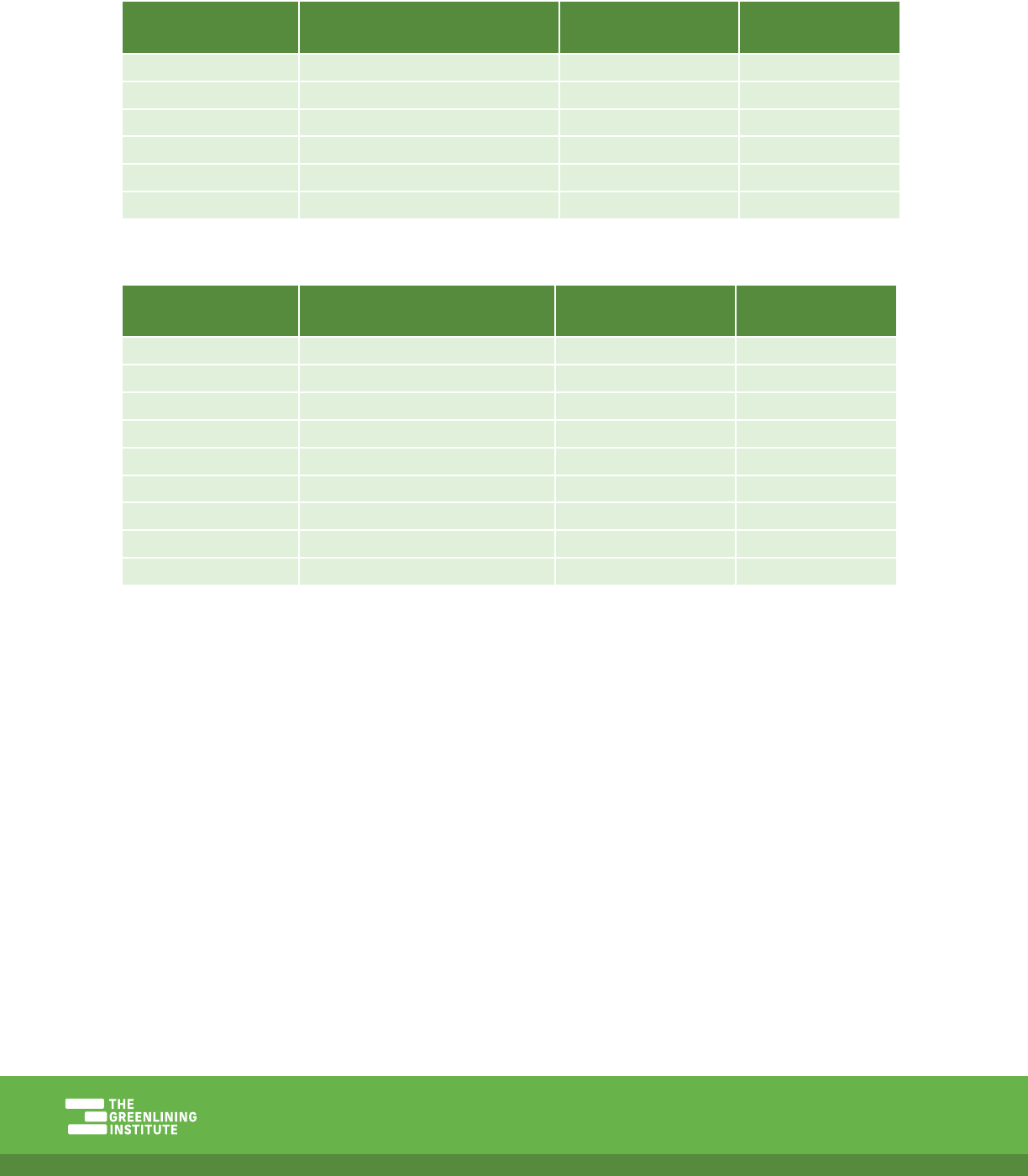
25Home Lending to Communities of Color in California | MARCH 2023
Table 9: Home Purchase Loans by Race for All Lenders
Race Number of Loan Originations
Percent of Loan
Originations
Percent of
Population
White 5,269 34.71% 36.40%
Asian 6,142 40.46% 33.10%
Native American 8 0.05% 0.10%
Black 111 0.73% 3.70%
Pacific Islander 21 0.14% 0.80%
Latino 700 4.61% 19.60%
Table 10: Home Purchase Loans to Asian Borrowers for All Lenders
Race Number of Loan Originations
Percent of Loan
Originations
Percent of Total
Loan Originations
Asian 1,262 20.55% 8.31%
Asian Indian 873 14.21% 5.75%
Chinese 2,857 46.52% 18.82%
Filipino 237 3.86% 1.56%
Japanese 77 1.25% 0.51%
Korean 239 3.89% 1.57%
Vietnamese 151 2.46% 0.99%
Asian Other 259 4.22% 1.71%
Multi-Asian 187 3.04% 1.23%
Top 15 Lenders in San Francisco-San Mateo-
Redwood City MSA
Traditional bank lenders make up nine of the top 15 lenders in the San Francisco region, a departure
from the dominance of nonbank lenders in other California regions. This remains consistent with last
year’s findings.
The top 15 lenders in the San Francisco region account for over 67% of the market. The top lender,
Wells Fargo Bank, accounts for 16% of all home purchase loan originations.
Table 11 below illustrates the number of home purchase loan originations by race for each of the top
15 lenders in the San Francisco MSA in 2021. Asian and white borrowers make up the majority of both
conventional and government-subsidized home purchase loan originations.
In the San Francisco MSA, eight institutions did not issue any government-subsidized loans in 2021,
reflected in the table below.
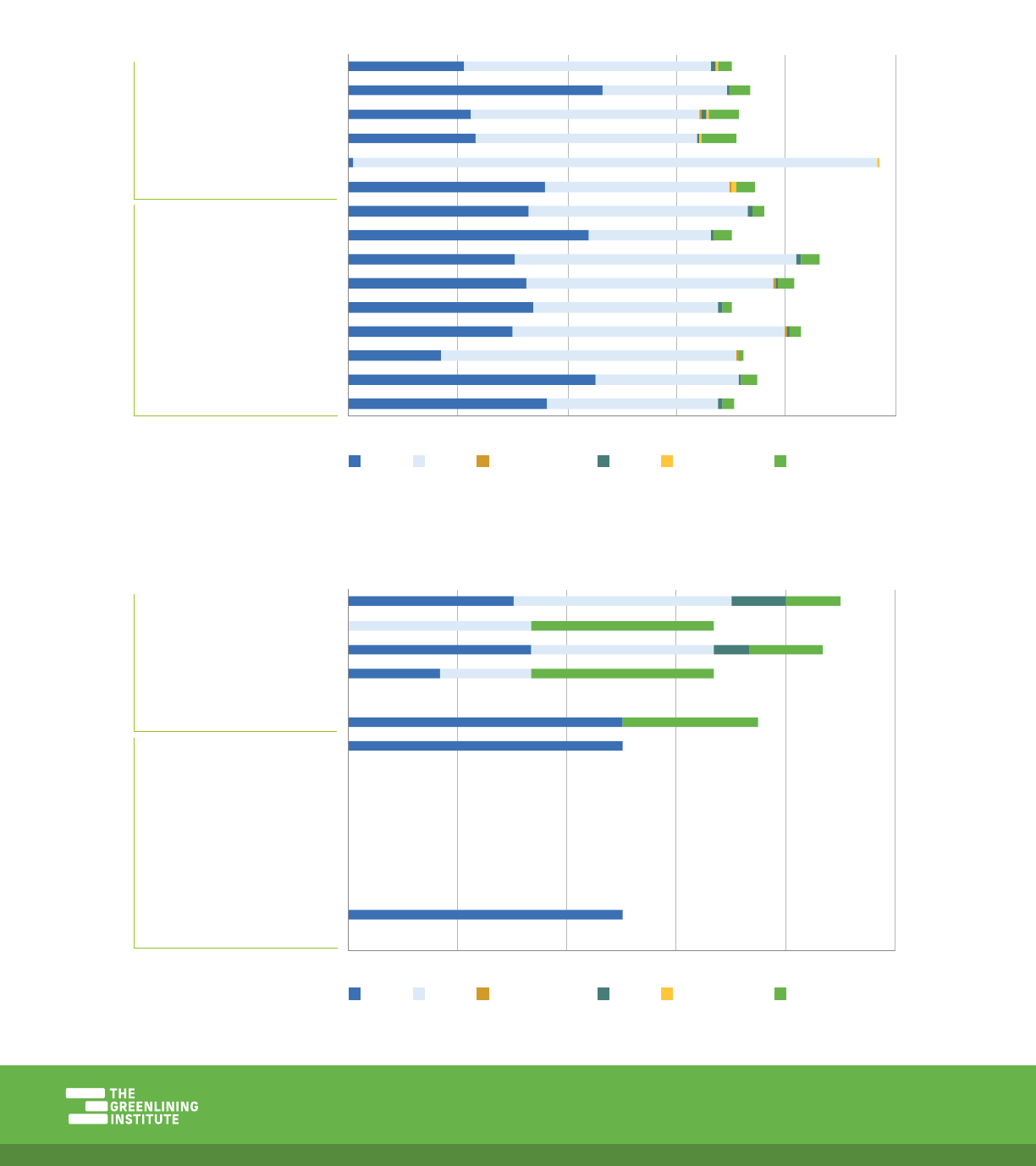
26Home Lending to Communities of Color in California | MARCH 2023
Table 11: Home Purchase Loans by Race
White Asian Native American Black Pacific Islander Latino
0% 40% 100%20% 60% 80%
Nonbank
Bank
ROCKET MORTGAGE
GUARANTEED RATE
UNITED WHOLESALE MORTGAGE
LOANDEPOT.COM
AMWEST FUNDING
GUARANTEED RATE AFFINITY
WELLS FARGO BANK
FIRST REPUBLIC BANK
BANK OF AMERICA
JPMORGAN CHASE BANK
CITIBANK
U.S. BANK
PNC BANK
FLAGSTAR BANK
MUFG UNION BANK
White Asian Native American Black Pacific Islander Latino
0% 40% 100%20% 60% 80%
Nonbank
Bank
ROCKET MORTGAGE
GUARANTEED RATE
UNITED WHOLESALE MORTGAGE
LOANDEPOT.COM
AMWEST FUNDING
GUARANTEED RATE AFFINITY
WELLS FARGO BANK
FIRST REPUBLIC BANK
BANK OF AMERICA
JPMORGAN CHASE BANK
CITIBANK
U.S. BANK
PNC BANK
FLAGSTAR BANK
MUFG UNION BANK

27Home Lending to Communities of Color in California | MARCH 2023
Table 12 illustrates the number of home purchase loan originations for women-identified people of
color (non-White) for each of the top 15 lenders in the San Francisco MSA in 2021.
Of the top 15 institutions in the San Francisco MSA, only two made government-subsidized loans to
women of color.
Table 12: Home Purchase Loans to Women of Color
WoC (non-White)
0% 20% 40%10% 30% 50%
Nonbank
Bank
ROCKET MORTGAGE
GUARANTEED RATE
UNITED WHOLESALE MORTGAGE
LOANDEPOT.COM
AMWEST FUNDING
GUARANTEED RATE AFFINITY
WELLS FARGO BANK
FIRST REPUBLIC BANK
BANK OF AMERICA
JPMORGAN CHASE BANK
CITIBANK
U.S. BANK
PNC BANK
FLAGSTAR BANK
MUFG UNION BANK
Nonbank
Bank
ROCKET MORTGAGE
GUARANTEED RATE
UNITED WHOLESALE MORTGAGE
LOANDEPOT.COM
AMWEST FUNDING
GUARANTEED RATE AFFINITY
WELLS FARGO BANK
FIRST REPUBLIC BANK
BANK OF AMERICA
JPMORGAN CHASE BANK
CITIBANK
U.S. BANK
PNC BANK
FLAGSTAR BANK
MUFG UNION BANK
WoC (non-White)
0% 20% 40%10% 30% 50%
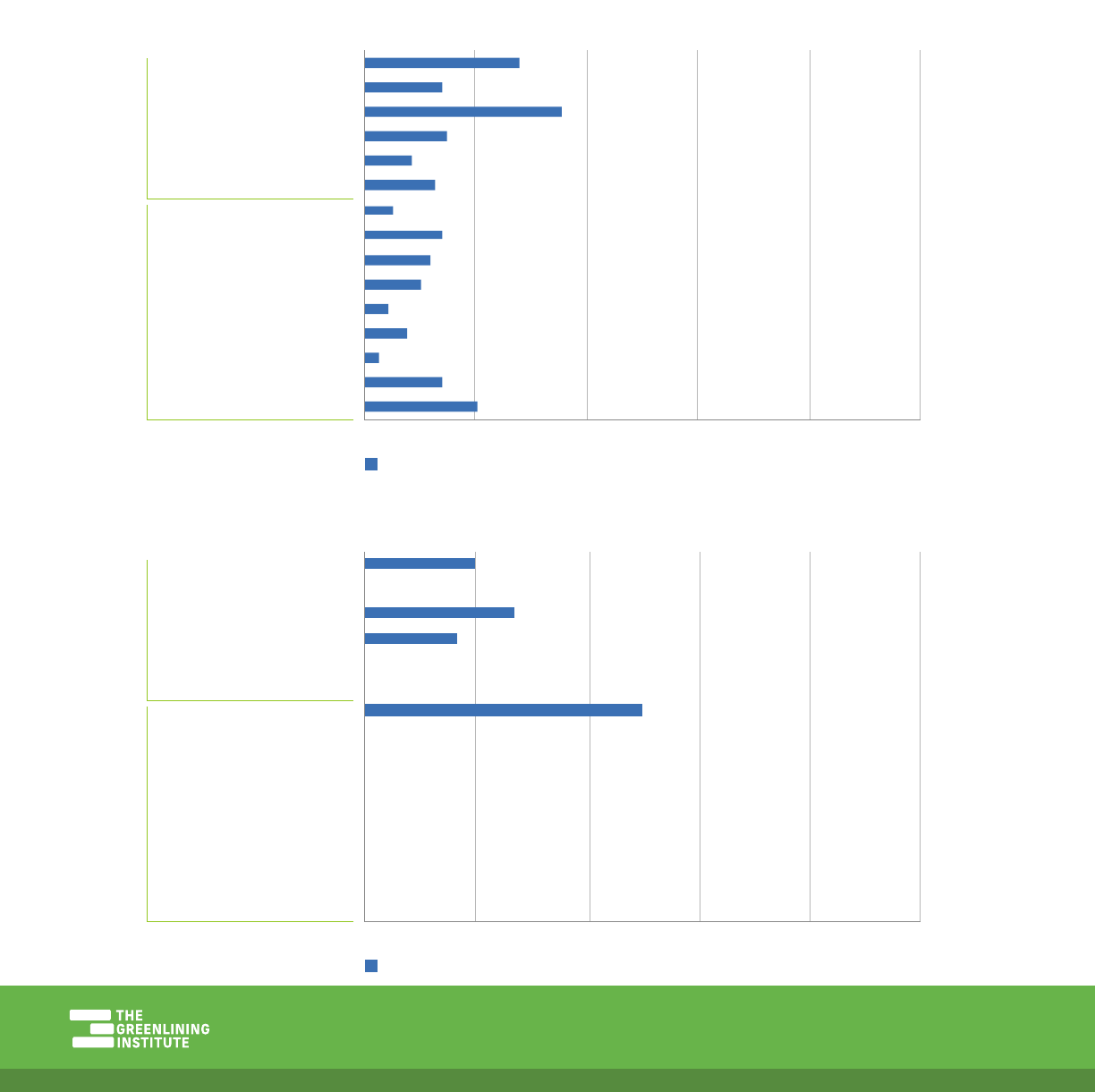
28Home Lending to Communities of Color in California | MARCH 2023
Table 13 below illustrates the number of home purchase loan originations to low-income borrowers,
defined as borrowers who report an income below 80% of the region’s Area Median Income, for each
of the top 15 lenders in the San Francisco MSA in 2021. The data reveals dierences in lending to low-
income households between bank and nonbank lenders, with nonbank lenders lending to low-income
borrowers at a higher rate, if at all.
On average, less than 5% of loans made by banks were to low-income borrowers and 11 institutions
did not make any government-subsidized loans to low-income borrowers.
Table 13: Home Purchase Loans by Borrower Income
Borrowers < 80% of AMI
ROCKET MORTGAGE
GUARANTEED RATE
UNITED WHOLESALE MORTGAGE
LOANDEPOT.COM
AMWEST FUNDING
GUARANTEED RATE AFFINITY
WELLS FARGO BANK
FIRST REPUBLIC BANK
BANK OF AMERICA
JPMORGAN CHASE BANK
CITIBANK
U.S. BANK
PNC BANK
FLAGSTAR BANK
MUFG UNION BANK
0% 10% 20% 30% 40% 50%
Nonbank
Bank
Borrowers < 80% of AMI
ROCKET MORTGAGE
GUARANTEED RATE
UNITED WHOLESALE MORTGAGE
LOANDEPOT.COM
AMWEST FUNDING
GUARANTEED RATE AFFINITY
WELLS FARGO BANK
FIRST REPUBLIC BANK
BANK OF AMERICA
JPMORGAN CHASE BANK
CITIBANK
U.S. BANK
PNC BANK
FLAGSTAR BANK
MUFG UNION BANK
0% 10% 20% 30% 40% 50%
Nonbank
Bank
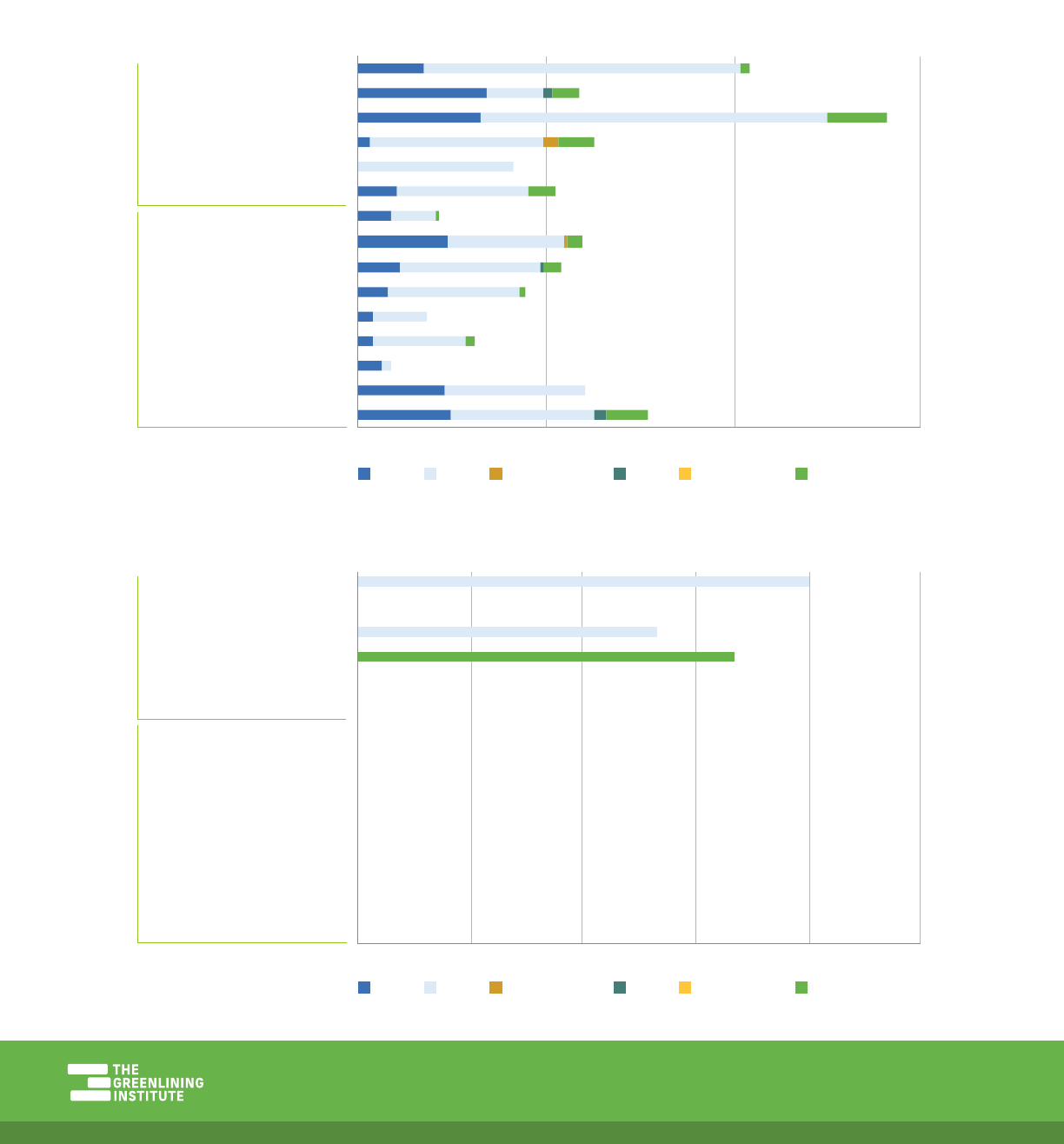
29Home Lending to Communities of Color in California | MARCH 2023
Table 14 below illustrates the number of home purchase loan originations to low-income borrowers by
race for each of the top 15 lenders in the San Francisco MSA in 2021.
Table 14: Home Purchase Loans by Borrower Income and Race
White Asian Native American Black Pacific Islander Latino
0% 5% 10% 15%
ROCKET MORTGAGE
GUARANTEED RATE
UNITED WHOLESALE MORTGAGE
LOANDEPOT.COM
AMWEST FUNDING
GUARANTEED RATE AFFINITY
WELLS FARGO BANK
FIRST REPUBLIC BANK
BANK OF AMERICA
JPMORGAN CHASE BANK
CITIBANK
U.S. BANK
PNC BANK
FLAGSTAR BANK
MUFG UNION BANK
Nonbank
Bank
0% 5% 10% 15% 20% 25%
ROCKET MORTGAGE
GUARANTEED RATE
UNITED WHOLESALE MORTGAGE
LOANDEPOT.COM
AMWEST FUNDING
GUARANTEED RATE AFFINITY
WELLS FARGO BANK
FIRST REPUBLIC BANK
BANK OF AMERICA
JPMORGAN CHASE BANK
CITIBANK
U.S. BANK
PNC BANK
FLAGSTAR BANK
MUFG UNION BANK
Nonbank
Bank
White Asian Native American Black Pacific Islander Latino
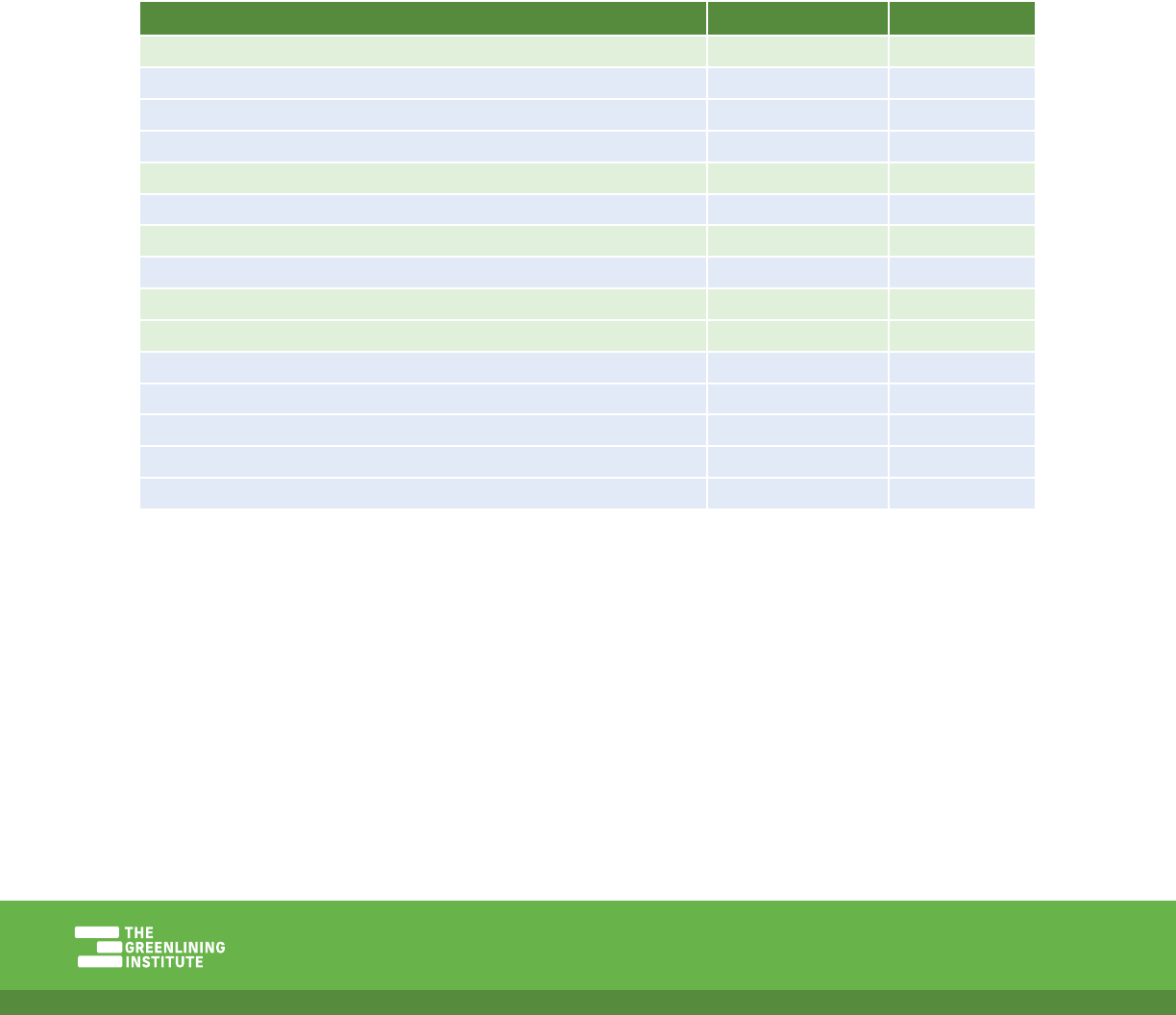
30Home Lending to Communities of Color in California | MARCH 2023
Oakland-Berkeley-Livermore MSA
Total Population: 2,809,969, 7.16% of California’s population
Oakland-Berkeley-Livermore Demographics
Overview of Lending in Oakland-Berkeley-Livermore MSA
Lender Type of Lender % of Market
Wells Fargo Bank Bank 7.47%
Rocket Mortgage Non-Bank 6.98%
United Wholesale Mortgage Non-Bank 6.87%
American Pacific Mortgage Non-Bank 4.90%
U.S. Bank Bank 3.96%
Loandepot.com Non-Bank 3.91%
Bank of America Bank 3.82%
Guaranteed Rate Non-Bank 3.41%
First Republic Bank Bank 2.64%
JPMorgan Chase Bank Bank 2.54%
Caliber Home Loans Non-Bank 2.20%
Commerce Home Mortgage Non-Bank 1.84%
Lendus Non-Bank 1.81%
Crosscountry Mortgage Non-Bank 1.76%
Home Point Financial Non-Bank 1.66%
*Nonbank lenders are highlighted.
In the Oakland region, Black and Latino communities receive far fewer loans relative to their share
of the population than other racial groups in the region. Black households make up 9% of the
population, but receive less than 4% of the home purchase loans; Latino households make up 24%
of the population, but receive only 10% of the loans. Home lending to Asian households significantly
exceeds their share of the region’s population by 12 percentage points.
++N
00++N
09++N
01++N
++N
++N
06++N
26.5%
Asian
0.2%
Native
American
9.1%
Black
0.6%
Pacific
Islander
24.2%
Latino
33.0%
White
6.3%
Other
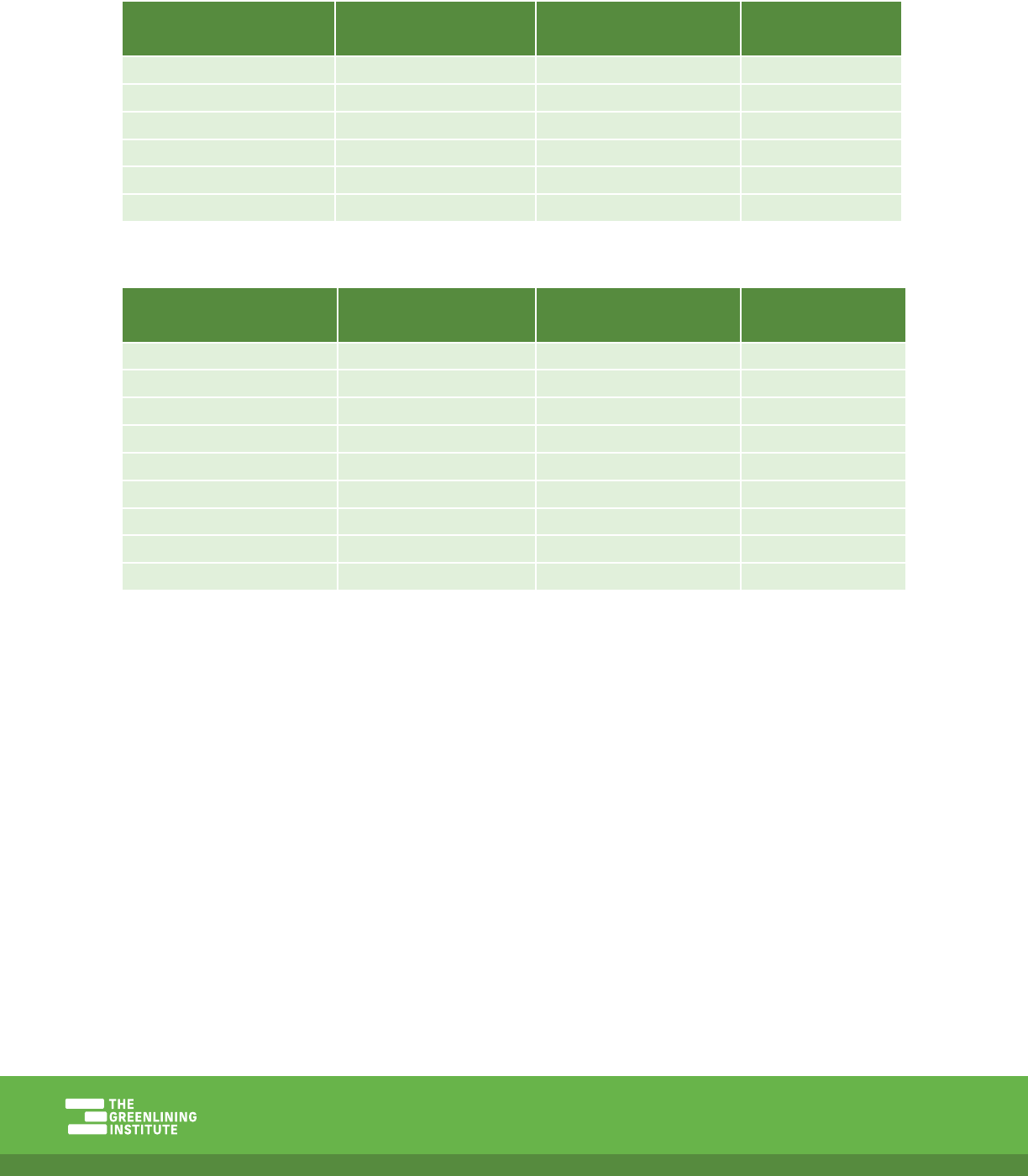
31Home Lending to Communities of Color in California | MARCH 2023
Table 15: Home Purchase Loans by Race for All Lenders
Race
Number of Loan
Originations
Percent of Loan
Originations
Percent of
Population
White 9,981 26.87% 33.00%
Asian 14,488 39.00% 26.50%
Native American 41 0.11% 0.20%
Black 1,454 3.91% 9.10%
Pacific Islander 103 0.28% 0.60%
Latino 3,863 10.40% 24.20%
Table 16: Home Purchase Loans to Asian Borrowers for All Lenders
Race
Number of Loan
Originations
Percent of Loan
Originations
Percent of Total
Loan Originations
Asian 2,422 16.72% 6.52%
Asian Indian 4,934 34.06% 13.28%
Chinese 3,774 26.05% 10.16%
Filipino 1,160 8.01% 3.12%
Japanese 108 0.75% 0.29%
Korean 412 2.84% 1.11%
Vietnamese 429 2.96% 1.15%
Asian Other 709 4.89% 1.91%
Multi-Asian 540 3.73% 1.45%
Top 15 Lenders in Oakland-Berkeley-Livermore MSA
The top 15 lenders in the Oakland region account for over 56% of the market. The top lender, Wells
Fargo Bank, accounts for 7% of all home purchase loan originations.
Table 17 below illustrates the number of home purchase loan originations by race for each of the top
15 lenders in the Oakland MSA in 2021. Black and Latino borrowers are significantly underrepresented
across all lenders for conventional loans proportional to their share of the population.
First Republic Bank did not make any government-subsidized home purchase loans in 2021.

32Home Lending to Communities of Color in California | MARCH 2023
Table 17: Home Purchase Loans by Race
White Asian Native American Black Pacific Islander Latino
ROCKET MORTGAGE
UNITED WHOLESALE MORTGAGE
AMERICAN PACIFIC MORTGAGE
LOANDEPOT.COM
GUARANTEED RATE
CALIBER HOME LOANS
COMMERCE HOME MORTGAGE
LENDUS
CROSSCOUNTRY MORTGAGE
HOME POINT FINANCIAL
WELLS FARGO BANK
U.S. BANK
BANK OF AMERICA
FIRST REPUBLIC BANK
JPMORGAN CHASE BANK
0% 20% 40% 60% 80% 100%
Nonbank
Bank
ROCKET MORTGAGE
UNITED WHOLESALE MORTGAGE
AMERICAN PACIFIC MORTGAGE
LOANDEPOT.COM
GUARANTEED RATE
CALIBER HOME LOANS
COMMERCE HOME MORTGAGE
LENDUS
CROSSCOUNTRY MORTGAGE
HOME POINT FINANCIAL
WELLS FARGO BANK
U.S. BANK
BANK OF AMERICA
FIRST REPUBLIC BANK
JPMORGAN CHASE BANK
0% 20% 40% 60% 80% 100%
White Asian Native American Black Pacific Islander Latino
Nonbank
Bank
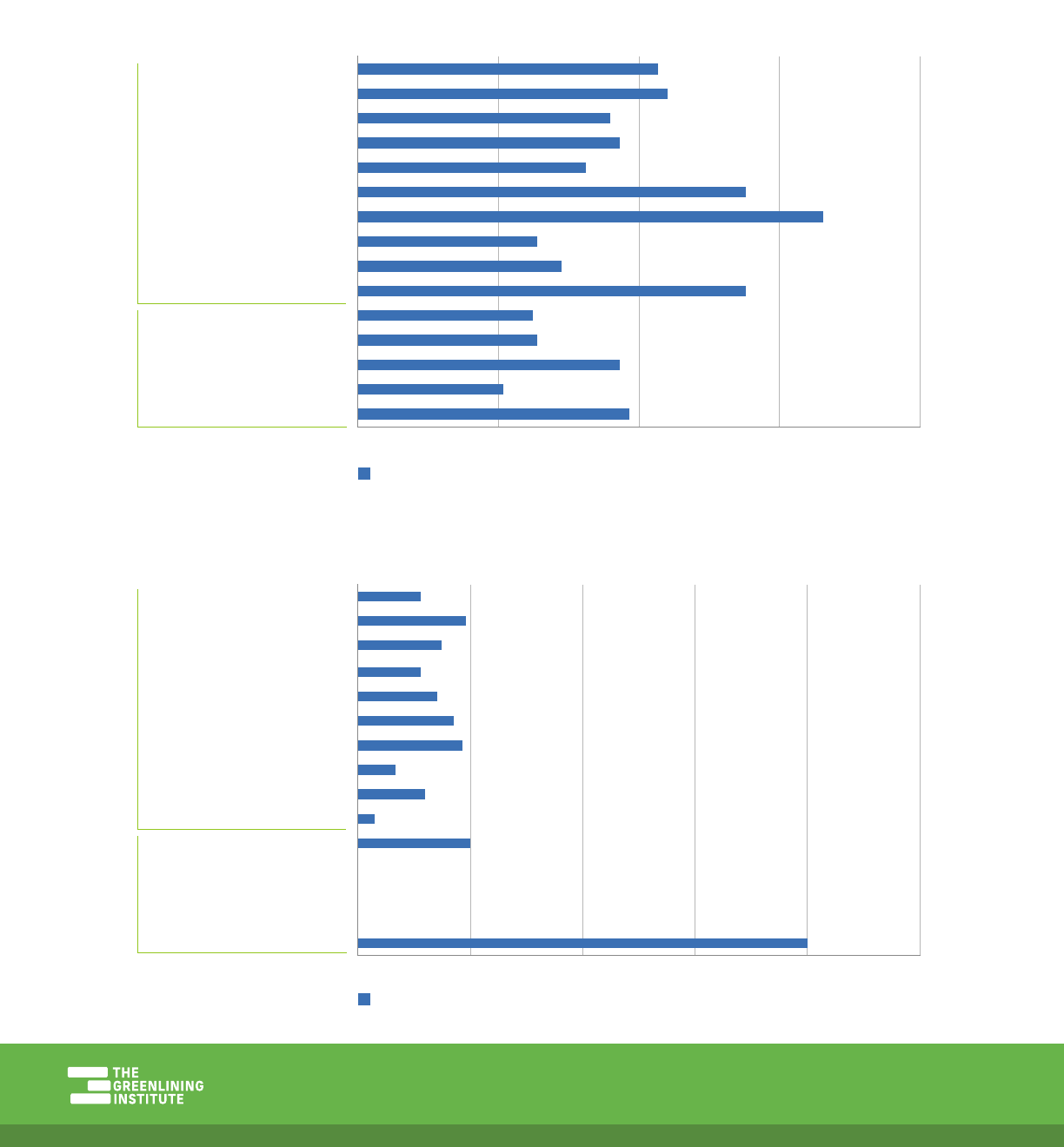
33Home Lending to Communities of Color in California | MARCH 2023
Table 18 illustrates the number of home purchase loan originations for women-identified people of
color (non-White) for each of the top 15 lenders in the Oakland MSA in 2021.
Table 18: Home Purchase Loans to Women of Color
WoC (non-White)
ROCKET MORTGAGE
UNITED WHOLESALE MORTGAGE
AMERICAN PACIFIC MORTGAGE
LOANDEPOT.COM
GUARANTEED RATE
CALIBER HOME LOANS
COMMERCE HOME MORTGAGE
LENDUS
CROSSCOUNTRY MORTGAGE
HOME POINT FINANCIAL
WELLS FARGO BANK
U.S. BANK
BANK OF AMERICA
FIRST REPUBLIC BANK
JPMORGAN CHASE BANK
0% 5% 10% 15% 20%
Nonbank
Bank
0% 20% 40% 60% 80% 100%
WoC (non-White)
ROCKET MORTGAGE
UNITED WHOLESALE MORTGAGE
AMERICAN PACIFIC MORTGAGE
LOANDEPOT.COM
GUARANTEED RATE
CALIBER HOME LOANS
COMMERCE HOME MORTGAGE
LENDUS
CROSSCOUNTRY MORTGAGE
HOME POINT FINANCIAL
WELLS FARGO BANK
U.S. BANK
BANK OF AMERICA
FIRST REPUBLIC BANK
JPMORGAN CHASE BANK
Nonbank
Bank
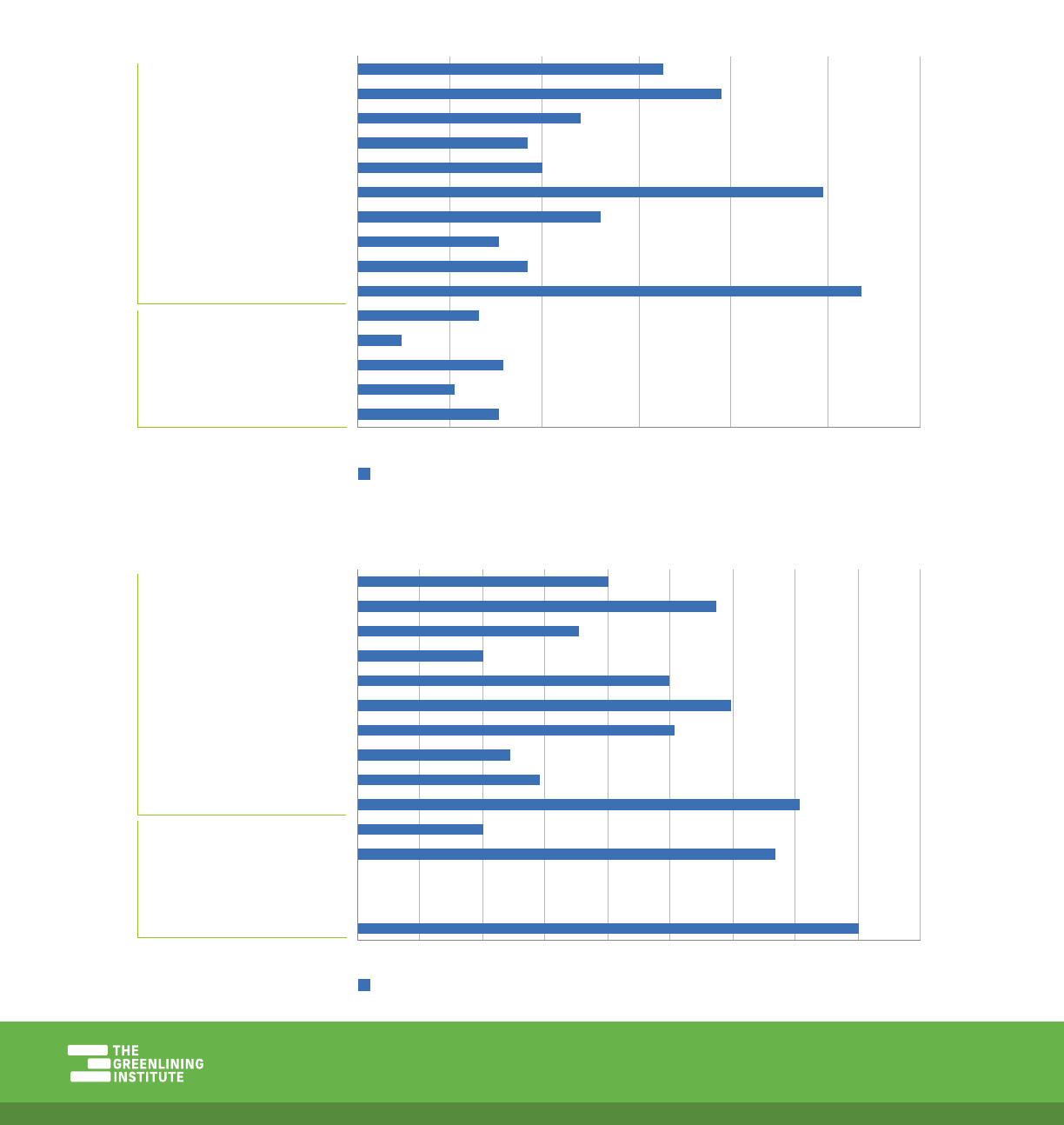
34Home Lending to Communities of Color in California | MARCH 2023
Table 19 below illustrates the number of home purchase loan originations to low-income borrowers,
defined as borrowers who report an income below 80% of the region’s Area Median Income (AMI), for
each of the top 15 lenders in the Oakland MSA in 2021.
Table 19: Home Purchase Loans to Low-Income Borrowers
0% 10%5% 15% 20% 25% 30%
Borrowers < 80% of AMI
ROCKET MORTGAGE
UNITED WHOLESALE MORTGAGE
AMERICAN PACIFIC MORTGAGE
LOANDEPOT.COM
GUARANTEED RATE
CALIBER HOME LOANS
COMMERCE HOME MORTGAGE
LENDUS
CROSSCOUNTRY MORTGAGE
HOME POINT FINANCIAL
WELLS FARGO BANK
U.S. BANK
BANK OF AMERICA
FIRST REPUBLIC BANK
JPMORGAN CHASE BANK
Nonbank
Bank
0% 10% 20% 35% 45%5% 15% 25% 30% 40%
Borrowers < 80% of AMI
ROCKET MORTGAGE
UNITED WHOLESALE MORTGAGE
AMERICAN PACIFIC MORTGAGE
LOANDEPOT.COM
GUARANTEED RATE
CALIBER HOME LOANS
COMMERCE HOME MORTGAGE
LENDUS
CROSSCOUNTRY MORTGAGE
HOME POINT FINANCIAL
WELLS FARGO BANK
U.S. BANK
BANK OF AMERICA
FIRST REPUBLIC BANK
JPMORGAN CHASE BANK
Nonbank
Bank
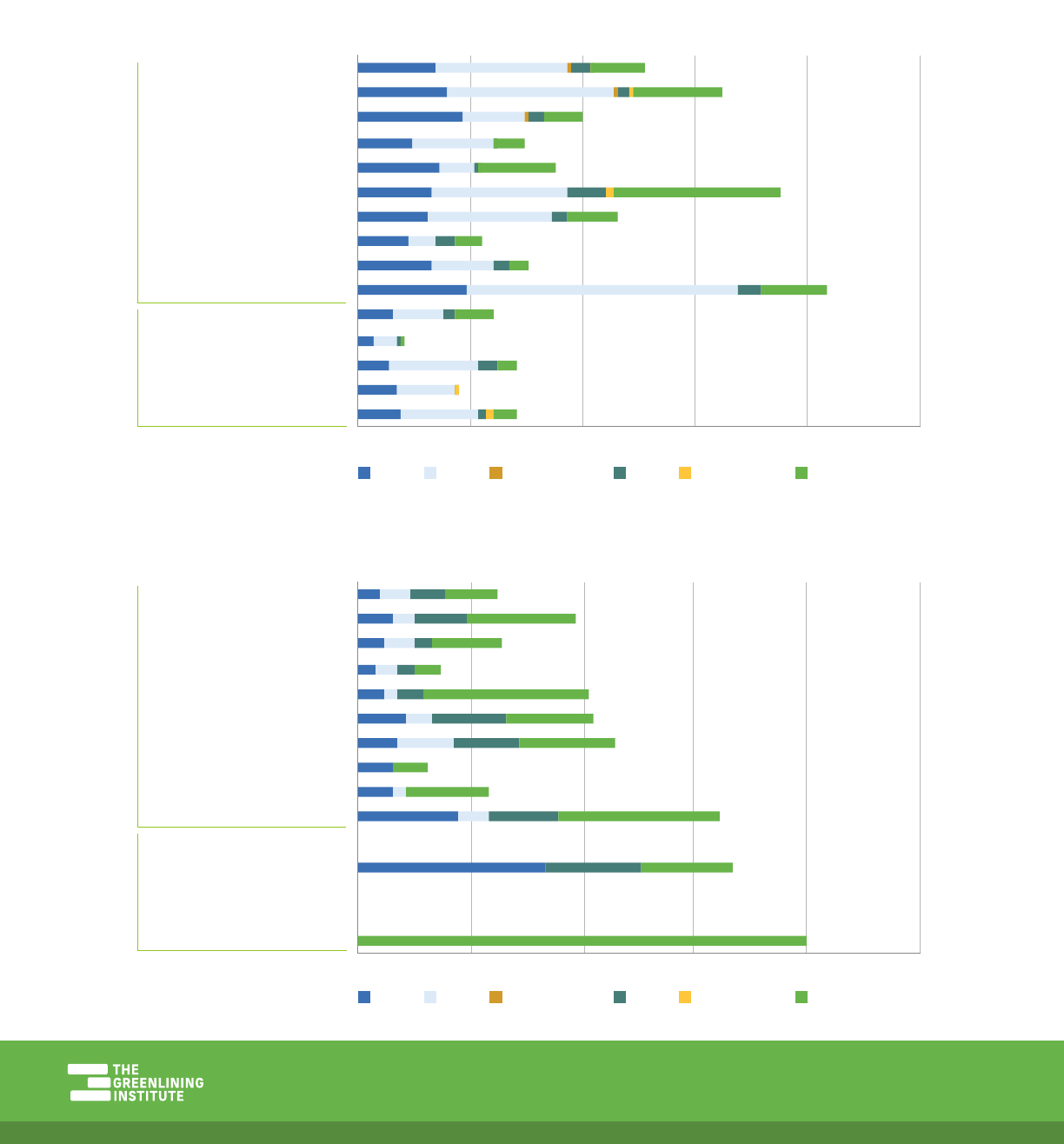
35Home Lending to Communities of Color in California | MARCH 2023
Table 20 below illustrates the number of home purchase loan originations to low-income borrowers by
race for each of the top 15 lenders in the Oakland MSA in 2021.
Table 20 Home Purchase Loans to Low-Income Borrowers by Race
White Asian Native American Black Pacific Islander Latino
0% 10% 20%5% 15% 25%
Nonbank
Bank
ROCKET MORTGAGE
UNITED WHOLESALE MORTGAGE
AMERICAN PACIFIC MORTGAGE
LOANDEPOT.COM
GUARANTEED RATE
CALIBER HOME LOANS
COMMERCE HOME MORTGAGE
LENDUS
CROSSCOUNTRY MORTGAGE
HOME POINT FINANCIAL
WELLS FARGO BANK
U.S. BANK
BANK OF AMERICA
FIRST REPUBLIC BANK
JPMORGAN CHASE BANK
0% 10% 20% 30% 40% 50%
White Asian Native American Black Pacific Islander Latino
Nonbank
Bank
ROCKET MORTGAGE
UNITED WHOLESALE MORTGAGE
AMERICAN PACIFIC MORTGAGE
LOANDEPOT.COM
GUARANTEED RATE
CALIBER HOME LOANS
COMMERCE HOME MORTGAGE
LENDUS
CROSSCOUNTRY MORTGAGE
HOME POINT FINANCIAL
WELLS FARGO BANK
U.S. BANK
BANK OF AMERICA
FIRST REPUBLIC BANK
JPMORGAN CHASE BANK
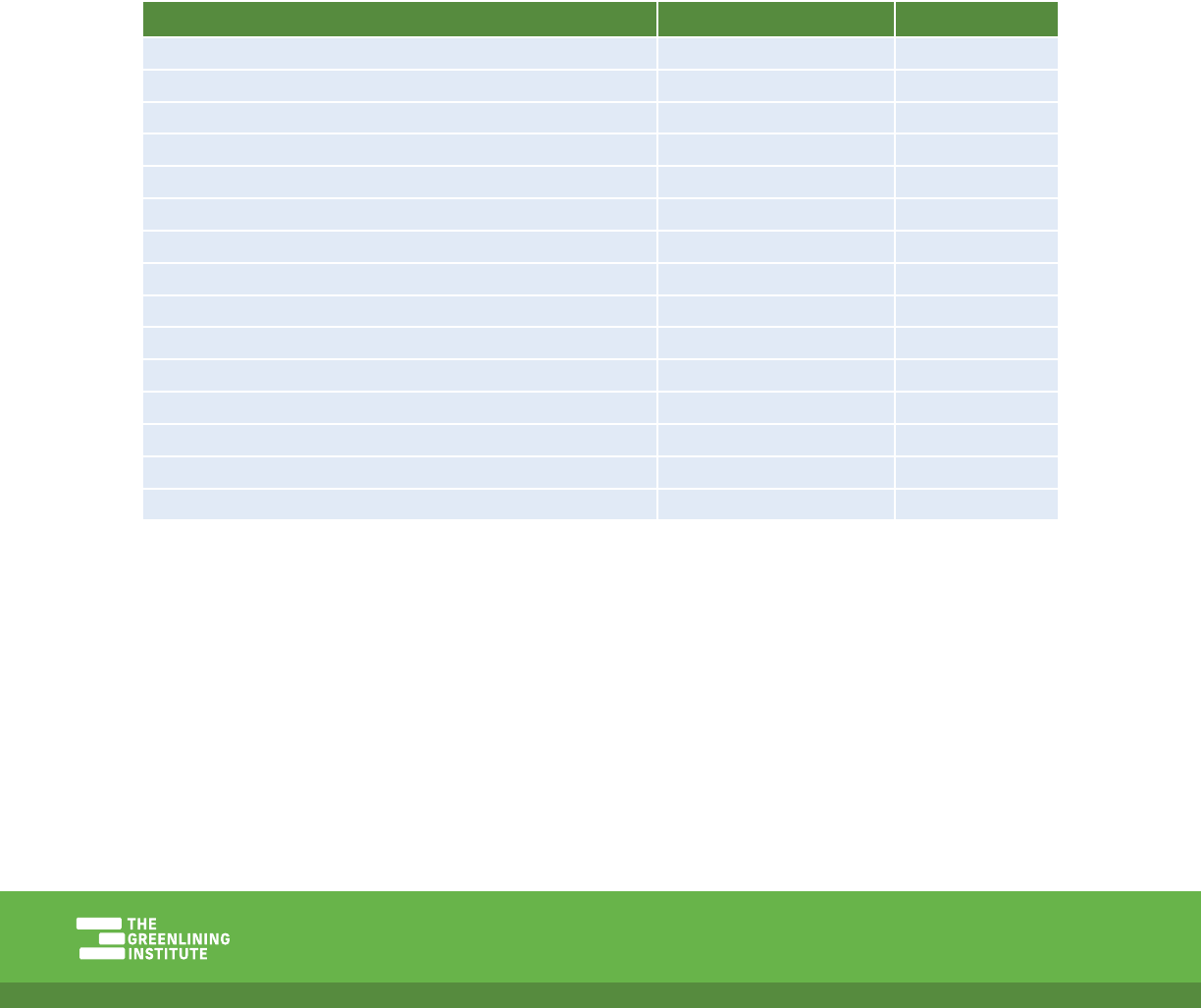
36Home Lending to Communities of Color in California | MARCH 2023
Fresno MSA
Total Population: 1,013,581, 2.58% of California’s population
Fresno Demographics
Overview of Lending in Fresno MSA
Lender Type of Lender % of Market
United Wholesale Mortgage Non-Bank 13.09%
Alameda Mortgage Non-Bank 8.90%
Home Point Financial Non-Bank 6.11%
Homebridge Financial Services Non-Bank 3.82%
Rocket Mortgage Non-Bank 3.68%
Country Club Mortgage Non-Bank 3.52%
Sierra Pacific Mortgage Company Non-Bank 3.51%
American Pacific Mortgage Non-Bank 2.52%
Lennar Mortgage Non-Bank 2.43%
Inspire Home Loans Non-Bank 2.15%
Kings Mortgage Services Non-Bank 2.00%
Finance of America Mortgage Non-Bank 1.79%
Bay Equity Non-Bank 1.56%
Amerifirst Financial Non-Bank 1.42%
Cardinal Financial Company Non-Bank 1.41%
*Nonbank lenders are highlighted.
In the Fresno region, Asian households are overrepresented in loan originations, while Latino
households are significantly underrepresented. Latino households make up 55% of the region’s
population but only 36% of home purchase loans.
++N
01++N
04++N
00++N
++N
++N
04++N
10.6%
Asian
0.4%
Native
American
4.1%
Black
0.2%
Pacific
Islander
54.7%
Latino
26.3%
White
3.7%
Other
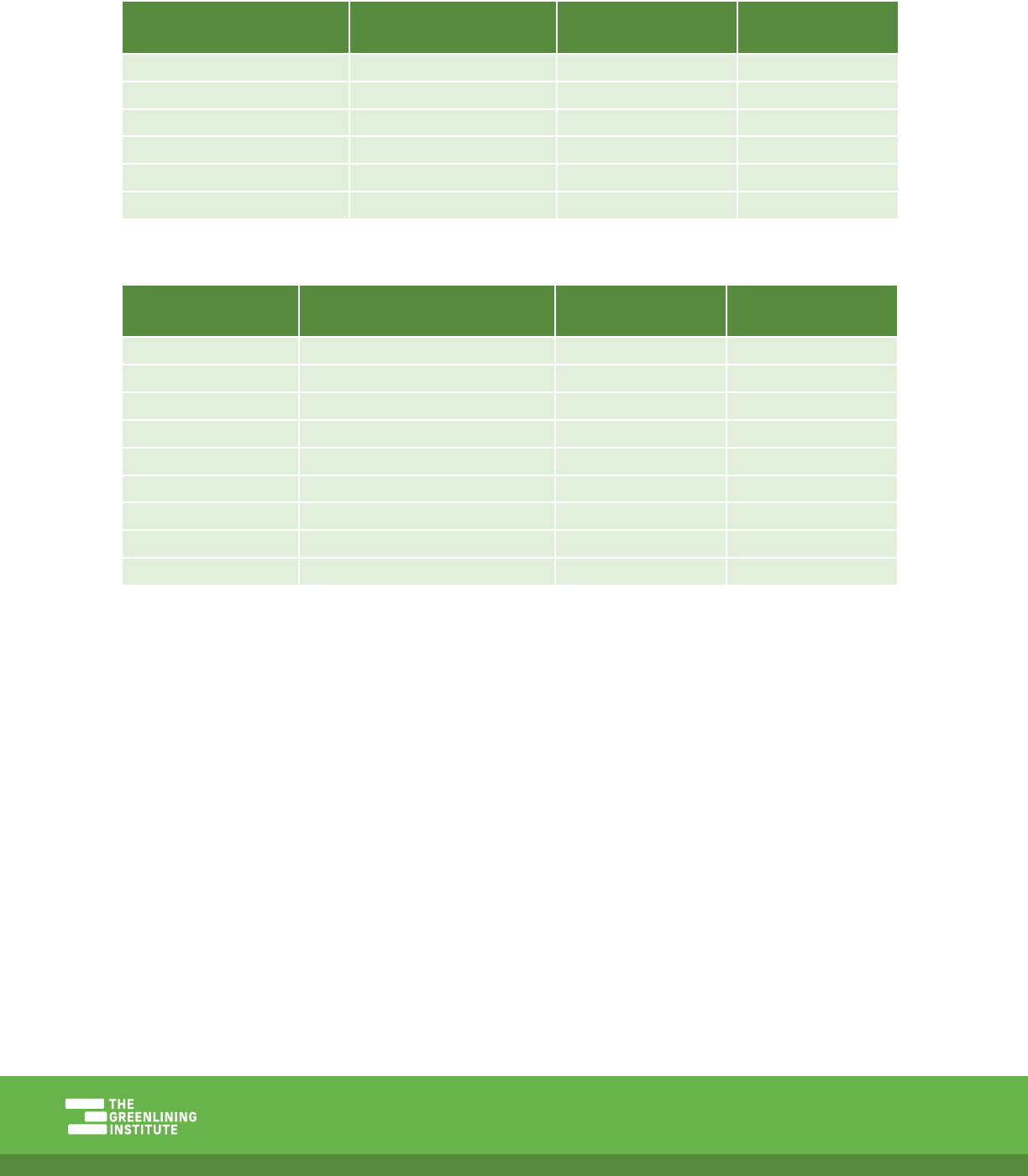
37Home Lending to Communities of Color in California | MARCH 2023
Table 21: Home Purchase Loans by Race for All Lenders
Race
Number of Loan
Originations
Percent of Loan
Originations
Percent of
Population
White 3,458 28.50% 26.30%
Asian 1,744 14.37% 10.60%
Native American 34 0.28% 0.40%
Black 305 2.51% 4.10%
Pacific Islander 14 0.12% 0.20%
Latino 4,397 36.24% 54.70%
Table 22: Home Purchase Loans to Asian Borrowers for All Lenders
Race
Number of Loan
Originations
Percent of Loan
Originations
Percent of Total Loan
Originations
Asian 427 24.48% 3.52%
Asian Indian 587 33.66% 4.84%
Chinese 139 7.97% 1.15%
Filipino 111 6.36% 0.91%
Japanese 20 1.15% 0.16%
Korean 20 1.15% 0.16%
Vietnamese 86 4.93% 0.71%
Asian Other 302 17.32% 2.49%
Multi-Asian 52 2.98% 0.43%
Top 15 Lenders in Fresno MSA
The top 15 lenders in the Fresno region account for 58% of the market. Nonbank lenders entirely
dominate and make up all 15 of the top lenders, an increase from 14 last year. In contrast to the
more urban California regions in this report, Fresno and the surrounding San Joaquin Valley have
experienced a significant decrease in bank branches, a rising trend in rural communities that may
account for the increased dominance of nonbank lenders in rural markets.
Table 23 below illustrates the number of home purchase loan originations by race for each of the top
15 lenders in the Fresno MSA in 2021. More than half (nine out of 15) of the nonbank lenders in this
sample issued their largest share of government-subsidized loans to Latino borrowers.
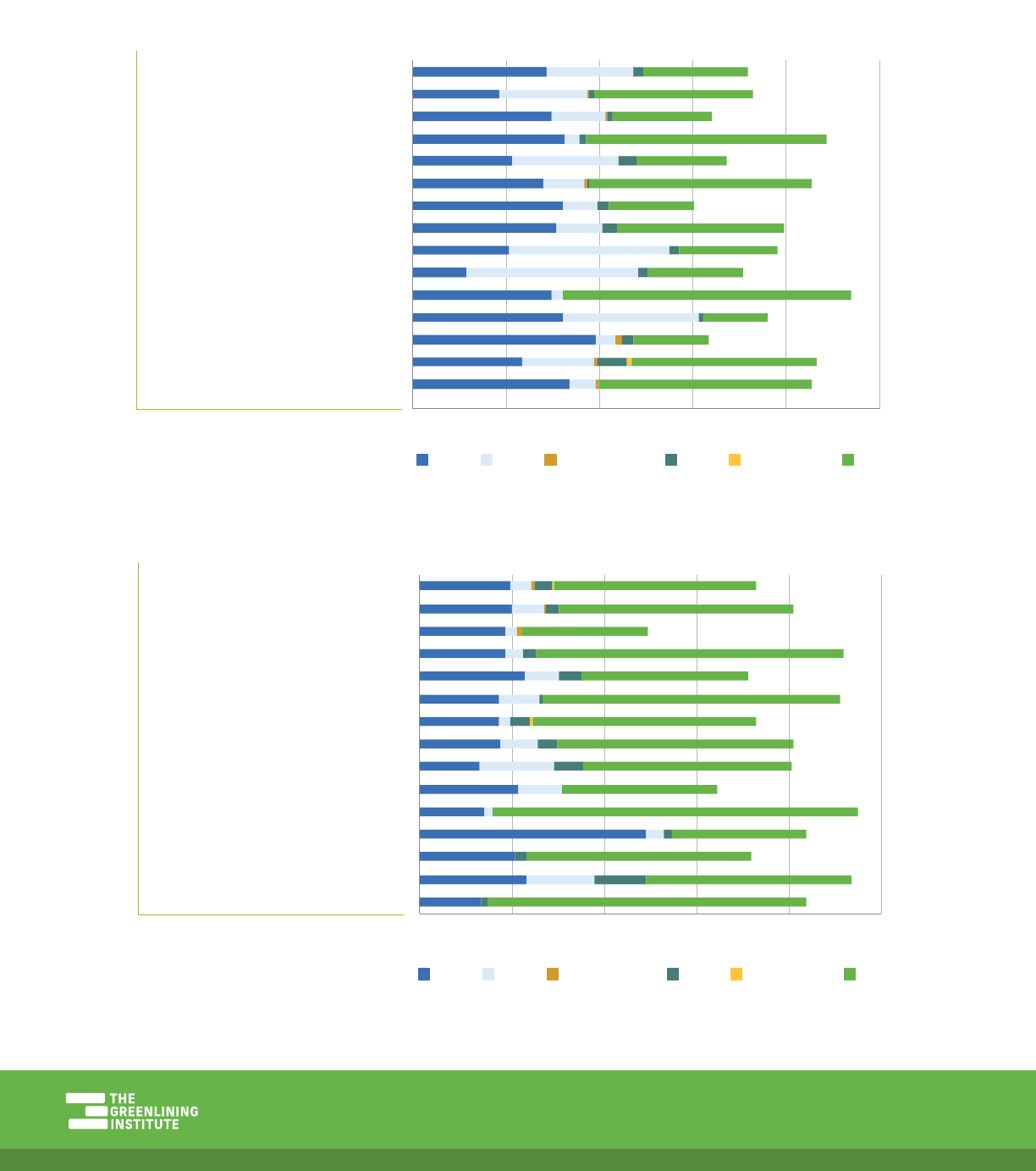
38Home Lending to Communities of Color in California | MARCH 2023
Table 23: Home Purchase Loans by Race
White Asian Native American Black Pacific Islander Latino
UNITED WHOLESALE MORTGAGE
ALAMEDA MORTGAGE
HOME POINT FINANCIAL
HOMEBRIDGE FINANCIAL SERVICES
ROCKET MORTGAGE
COUNTRY CLUB MORTGAGE
SIERRA PACIFIC MORTGAGE COMPANY
AMERICAN PACIFIC MORTGAGE
LENNAR MORTGAGE
INSPIRE HOME LOANS
KINGS MORTGAGE SERVICES
FINANCE OF AMERICA MORTGAGE
BAY EQUITY
AMERIFIRST FINANCIAL
CARDINAL FINANCIAL COMPANY
Nonbank
0% 20% 40% 60% 80% 100%
White Asian Native American Black Pacific Islander Latino
UNITED WHOLESALE MORTGAGE
ALAMEDA MORTGAGE
HOME POINT FINANCIAL
HOMEBRIDGE FINANCIAL SERVICES
ROCKET MORTGAGE
COUNTRY CLUB MORTGAGE
SIERRA PACIFIC MORTGAGE COMPANY
AMERICAN PACIFIC MORTGAGE
LENNAR MORTGAGE
INSPIRE HOME LOANS
KINGS MORTGAGE SERVICES
FINANCE OF AMERICA MORTGAGE
BAY EQUITY
AMERIFIRST FINANCIAL
CARDINAL FINANCIAL COMPANY
Nonbank
0% 20% 40% 60% 80%
100%
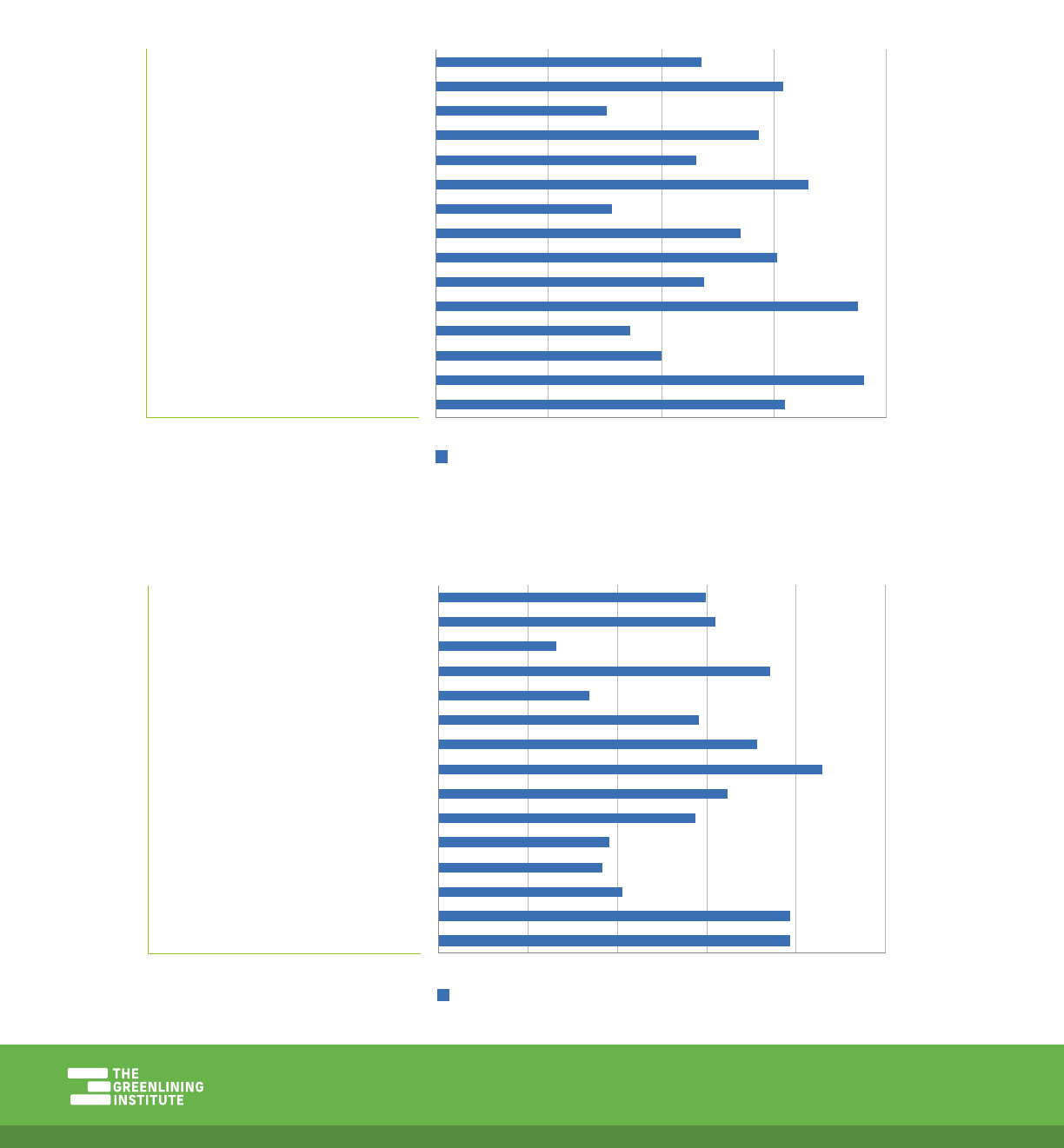
39Home Lending to Communities of Color in California | MARCH 2023
Table 24 illustrates the number of home purchase loan originations for women-identified people of
color (non-White) for each of the top 15 lenders in the Fresno MSA in 2021.
Table 24: Home Purchase Loans to Women of Color
Nonbank
UNITED WHOLESALE MORTGAGE
ROCKET MORTGAGE
LOANDEPOT.COM
FINANCE OF AMERICA MORTGAGE
AMWEST FUNDING
BROKER SOLUTIONS
HOME POINT FINANCIAL
GUARANTEED RATE
HOMEBRIDGE FINANCIAL SERVICES
JPMORGAN CHASE BANK
WELLS FARGO BANK
FIRST REPUBLIC BANK
BANK OF AMERICA
U.S. BANK
CITIBANK
0% 5% 10% 15% 20%
WoC (non-White)
Nonbank
UNITED WHOLESALE MORTGAGE
ROCKET MORTGAGE
LOANDEPOT.COM
FINANCE OF AMERICA MORTGAGE
AMWEST FUNDING
BROKER SOLUTIONS
HOME POINT FINANCIAL
GUARANTEED RATE
HOMEBRIDGE FINANCIAL SERVICES
JPMORGAN CHASE BANK
WELLS FARGO BANK
FIRST REPUBLIC BANK
BANK OF AMERICA
U.S. BANK
CITIBANK
0% 5% 10% 15% 20% 25%
WoC (non-White)
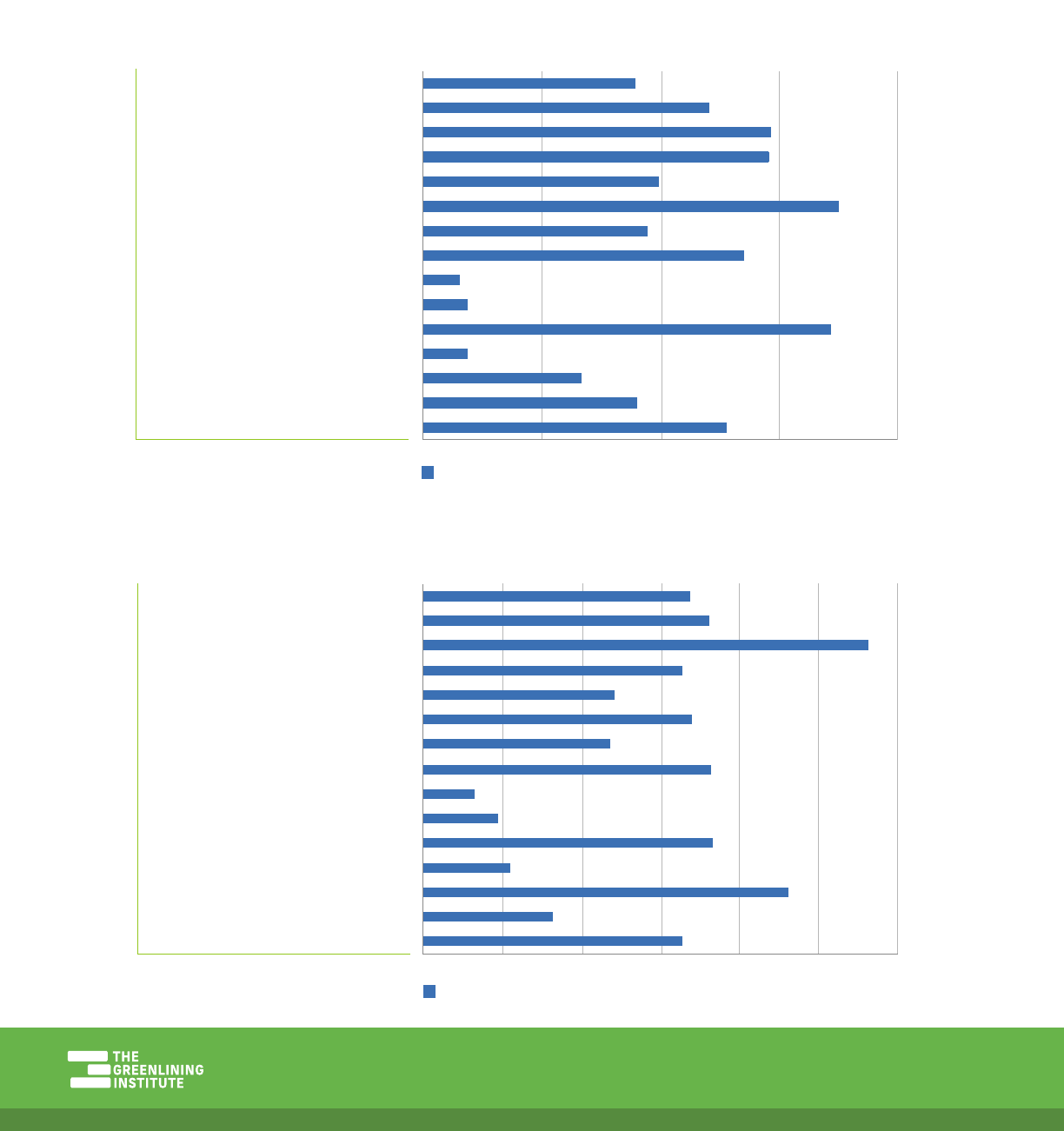
40Home Lending to Communities of Color in California | MARCH 2023
Table 25 below illustrates the number of home purchase loan originations to low-income borrowers,
defined as borrowers who report an income below 80% of the region’s Area Median Income, for each
of the top 15 lenders in the Fresno MSA in 2021. Notably, nine out of 15 nonbank lenders in this sample
issued more than 15% of their government-subsidized loans to low-income borrowers.
Table 25: Home Purchase Loans to Low-Income Borrowers
Nonbank
UNITED WHOLESALE MORTGAGE
ALAMEDA MORTGAGE
HOME POINT FINANCIAL
HOMEBRIDGE FINANCIAL SERVICES
ROCKET MORTGAGE
COUNTRY CLUB MORTGAGE
SIERRA PACIFIC MORTGAGE COMPANY
AMERICAN PACIFIC MORTGAGE
LENNAR MORTGAGE
INSPIRE HOME LOANS
KINGS MORTGAGE SERVICES
FINANCE OF AMERICA MORTGAGE
BAY EQUITY
AMERIFIRST FINANCIAL
CARDINAL FINANCIAL COMPANY
0% 5% 10% 15% 20%
Borrowers < 80% of AMI
Nonbank
UNITED WHOLESALE MORTGAGE
ALAMEDA MORTGAGE
HOME POINT FINANCIAL
HOMEBRIDGE FINANCIAL SERVICES
ROCKET MORTGAGE
COUNTRY CLUB MORTGAGE
SIERRA PACIFIC MORTGAGE COMPANY
AMERICAN PACIFIC MORTGAGE
LENNAR MORTGAGE
INSPIRE HOME LOANS
KINGS MORTGAGE SERVICES
FINANCE OF AMERICA MORTGAGE
BAY EQUITY
AMERIFIRST FINANCIAL
CARDINAL FINANCIAL COMPANY
0% 5% 10% 15% 20% 25% 30%
Borrowers < 80% of AMI
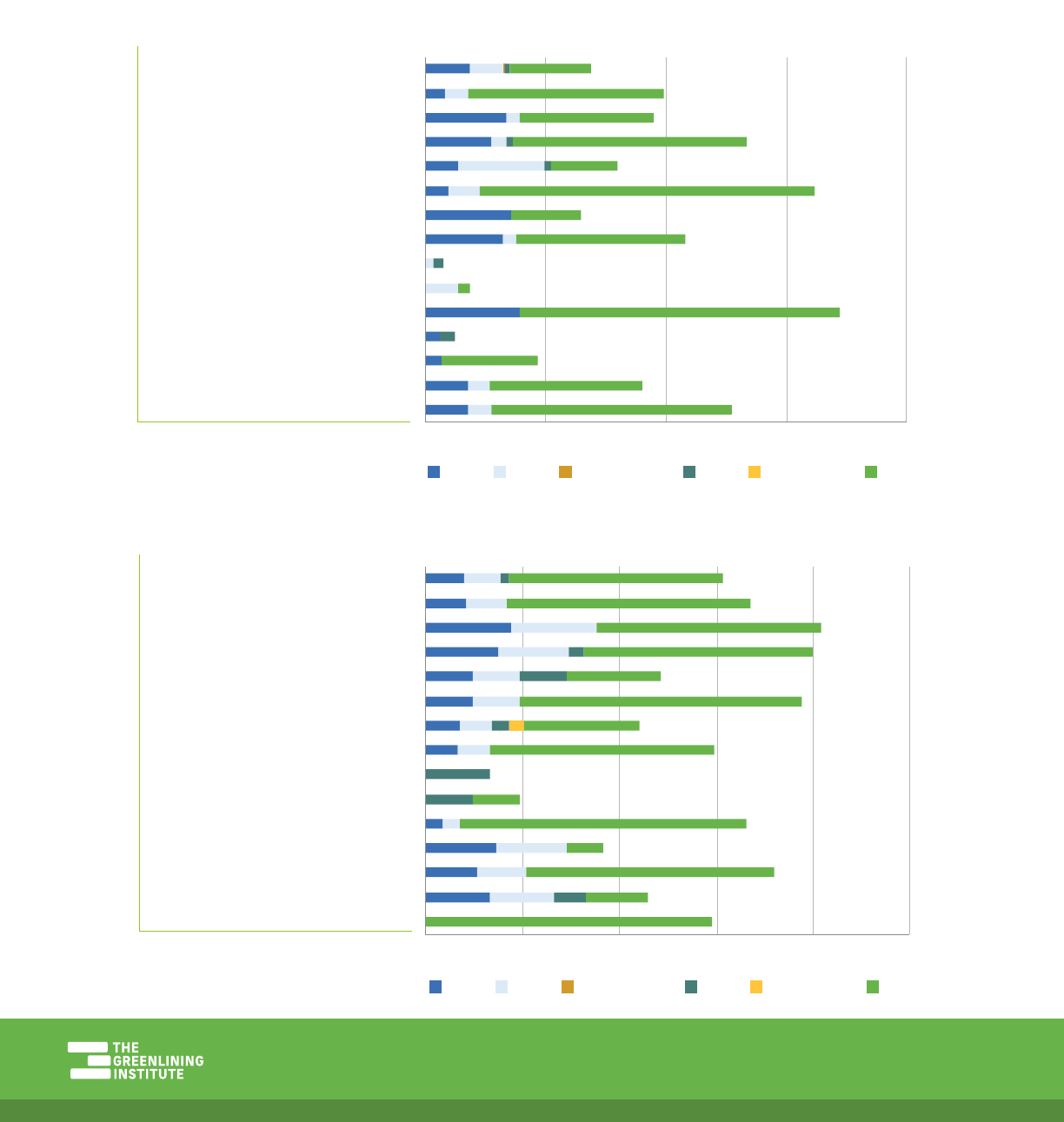
41Home Lending to Communities of Color in California | MARCH 2023
Table 26 below illustrates the number of home purchase loan originations to low-income borrowers
by race for each of the top 15 lenders in the Fresno MSA in 2021. Latino borrowers make up the highest
percentage of low-income borrowers across both conventional and government-subsidized loans.
Their share is nearly doubled for government-subsidized loans.
Table 26 Home Purchase Loans to Low-Income Borrowers by Race
White Asian Native American Black Pacific Islander Latino
UNITED WHOLESALE MORTGAGE
ROCKET MORTGAGE
LOANDEPOT.COM
FINANCE OF AMERICA MORTGAGE
AMWEST FUNDING
BROKER SOLUTIONS
HOME POINT FINANCIAL
GUARANTEED RATE
HOMEBRIDGE FINANCIAL SERVICES
JPMORGAN CHASE BANK
WELLS FARGO BANK
FIRST REPUBLIC BANK
BANK OF AMERICA
U.S. BANK
CITIBANK
Nonbank
0% 5% 10% 15% 20%
White Asian Native American Black Pacific Islander Latino
UNITED WHOLESALE MORTGAGE
ROCKET MORTGAGE
LOANDEPOT.COM
FINANCE OF AMERICA MORTGAGE
AMWEST FUNDING
BROKER SOLUTIONS
HOME POINT FINANCIAL
GUARANTEED RATE
HOMEBRIDGE FINANCIAL SERVICES
JPMORGAN CHASE BANK
WELLS FARGO BANK
FIRST REPUBLIC BANK
BANK OF AMERICA
U.S. BANK
CITIBANK
Nonbank
0% 5% 10% 15% 20% 25%
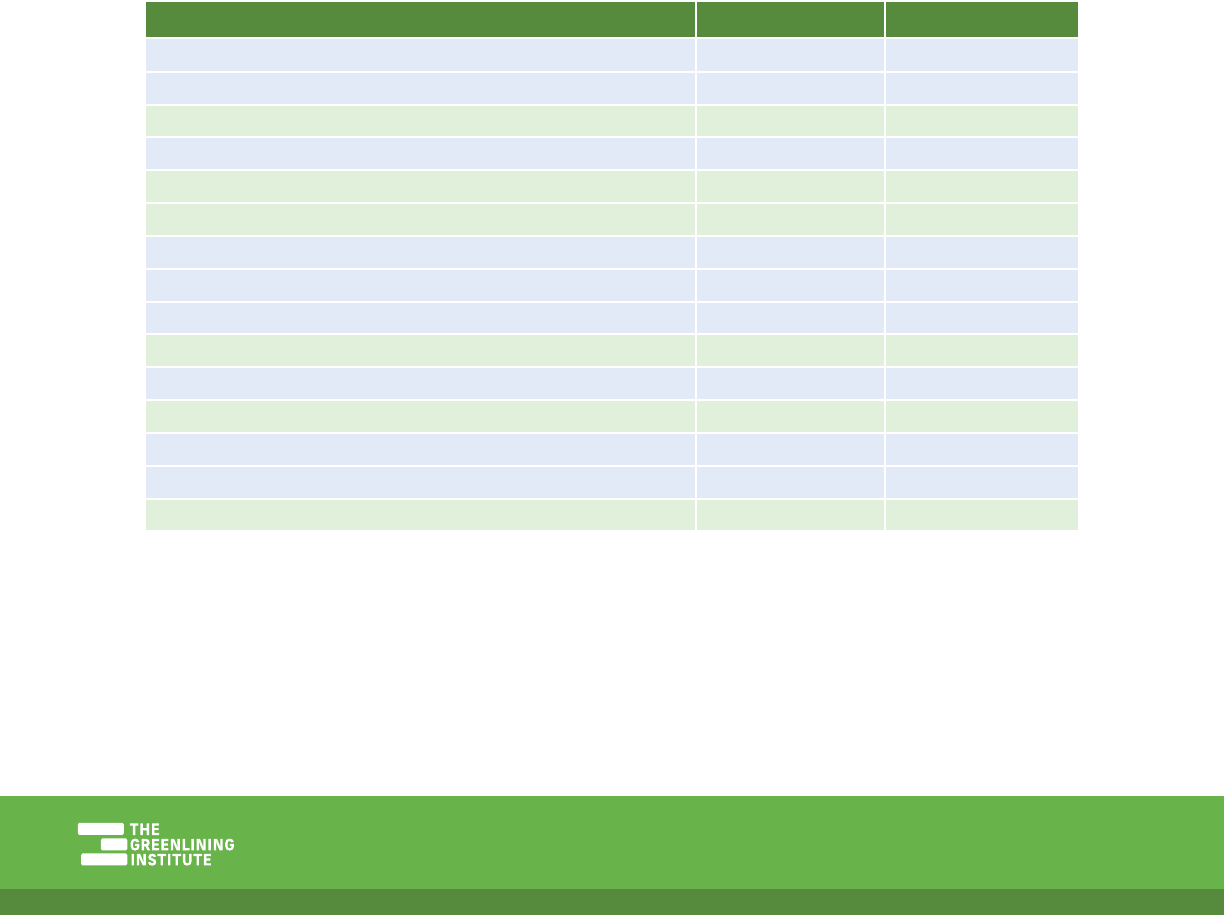
42Home Lending to Communities of Color in California | MARCH 2023
Los Angeles-Long Beach-
Glendale MSA
Total Population: 9,829,544, 25.05% of California’s population
Los Angeles-Long Beach-Glendale Demographics
Overview of Lending in Los Angeles-Long Beach-Glendale
MSA
Lender Type of Lender % of Market
United Wholesale Mortgage Non-Bank 11.17%
Rocket Mortgage Non-Bank 6.28%
JPMorgan Chase Bank Bank 4.01%
Loandepot.com Non-Bank 3.58%
Wells Fargo Bank, Bank 3.39%
First Republic Bank Bank 2.58%
Finance of America Mortgage Non-Bank 2.44%
Amwest Funding Non-Bank 2.35%
Broker Solutions Non-Bank 2.17%
Bank of America Bank 2.05%
Home Point Financial Non-Bank 2.02%
U.S. Bank Bank 1.65%
Guaranteed Rate Non-Bank 1.51%
Homebridge Financial Services Non-Bank 1.48%
Citibank Bank 1.43%
*Nonbank lenders are highlighted.
In the Los Angeles region, Latino households again make up almost half of the population, but only
20% of home purchase loans. Black households are also underrepresented in the region’s home
purchase loans, while white households are significantly overrepresented, by 11 percentage points.
++N
00++N
07++N
00++N
++N
++N
04++N
14.6%
Asian
0.1%
Native
American
7.3%
Black
0.2%
Pacific
Islander
49.1%
Latino
24.6%
White
4.0%
Other
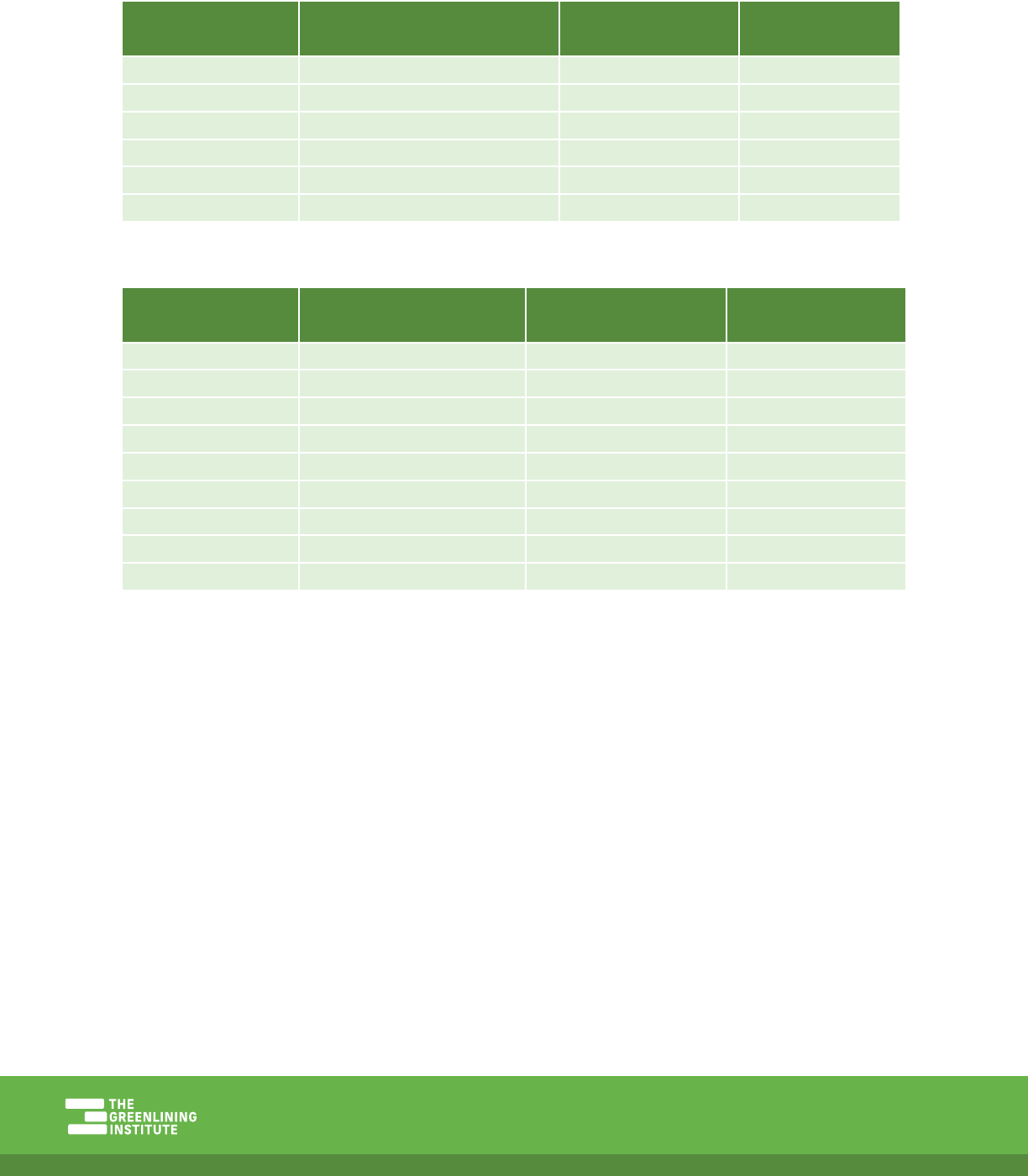
43Home Lending to Communities of Color in California | MARCH 2023
Table 27: Home Purchase Loans by Race for All Lenders
Race Number of Loan Originations
Percent of Loan
Originations
Percent of
Population
White 28,483 35.28% 24.60%
Asian 14,641 18.14% 14.60%
Native American 59 0.07% 0.10%
Black 3,186 3.95% 7.30%
Pacific Islander 103 0.13% 0.20%
Latino 16,056 19.89% 49.10%
Table 28: Home Purchase Loans to Asian Borrowers for All Lenders
Race
Number of Loan
Originations
Percent of Loan
Originations
Percent of Total Loan
Originations
Asian 3,615 24.69% 4.48%
Asian Indian 1,116 7.62% 1.38%
Chinese 4,166 28.45% 5.16%
Filipino 1,425 9.73% 1.77%
Japanese 320 2.19% 0.40%
Korean 2,132 14.56% 2.64%
Vietnamese 597 4.08% 0.74%
Asian Other 780 5.33% 0.97%
Multi-Asian 490 3.35% 0.61%
Top 15 Lenders in Los Angeles-Long Beach-Glendale MSA
The top 15 lenders in the Los Angeles region account for 48% of the market. Of these 15 lenders, Black
and Latino households are more highly represented in government-subsidized loans, though not
all lenders issue these loans. Consistent with years prior, the lender with the greatest percentage of
conventional home purchase loans to both Black and Latino households is the nonbank mortgage
lender Broker Solutions.
Table 29 below illustrates the number of home purchase loan originations by race for each of the top
15 lenders in the Los Angeles MSA in 2021.
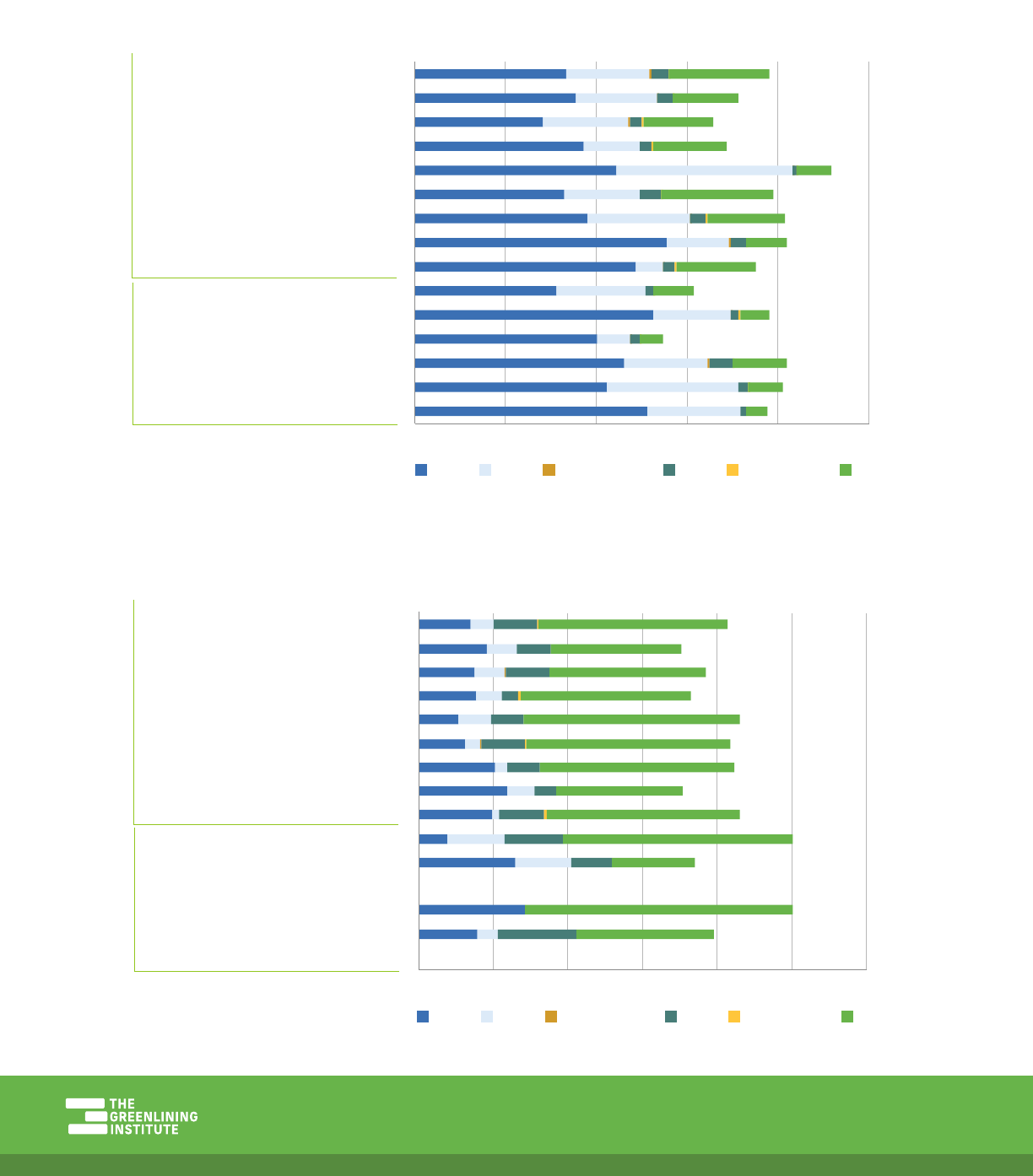
44Home Lending to Communities of Color in California | MARCH 2023
Table 29: Home Purchase Loans by Race
UNITED WHOLESALE MORTGAGE
ROCKET MORTGAGE
LOANDEPOT.COM
FINANCE OF AMERICA MORTGAGE
AMWEST FUNDING
BROKER SOLUTIONS
HOME POINT FINANCIAL
GUARANTEED RATE
HOMEBRIDGE FINANCIAL SERVICES
JPMORGAN CHASE BANK
WELLS FARGO BANK
FIRST REPUBLIC BANK
BANK OF AMERICA
U.S. BANK
CITIBANK
Nonbank
Bank
0% 2% 4% 6% 8% 10%
White Asian Native American Black Pacific Islander Latino
UNITED WHOLESALE MORTGAGE
ROCKET MORTGAGE
LOANDEPOT.COM
FINANCE OF AMERICA MORTGAGE
AMWEST FUNDING
BROKER SOLUTIONS
HOME POINT FINANCIAL
GUARANTEED RATE
HOMEBRIDGE FINANCIAL SERVICES
JPMORGAN CHASE BANK
WELLS FARGO BANK
FIRST REPUBLIC BANK
BANK OF AMERICA
U.S. BANK
CITIBANK
Nonbank
Bank
0% 2% 4% 6% 8% 10% 12%
White Asian Native American Black Pacific Islander Latino
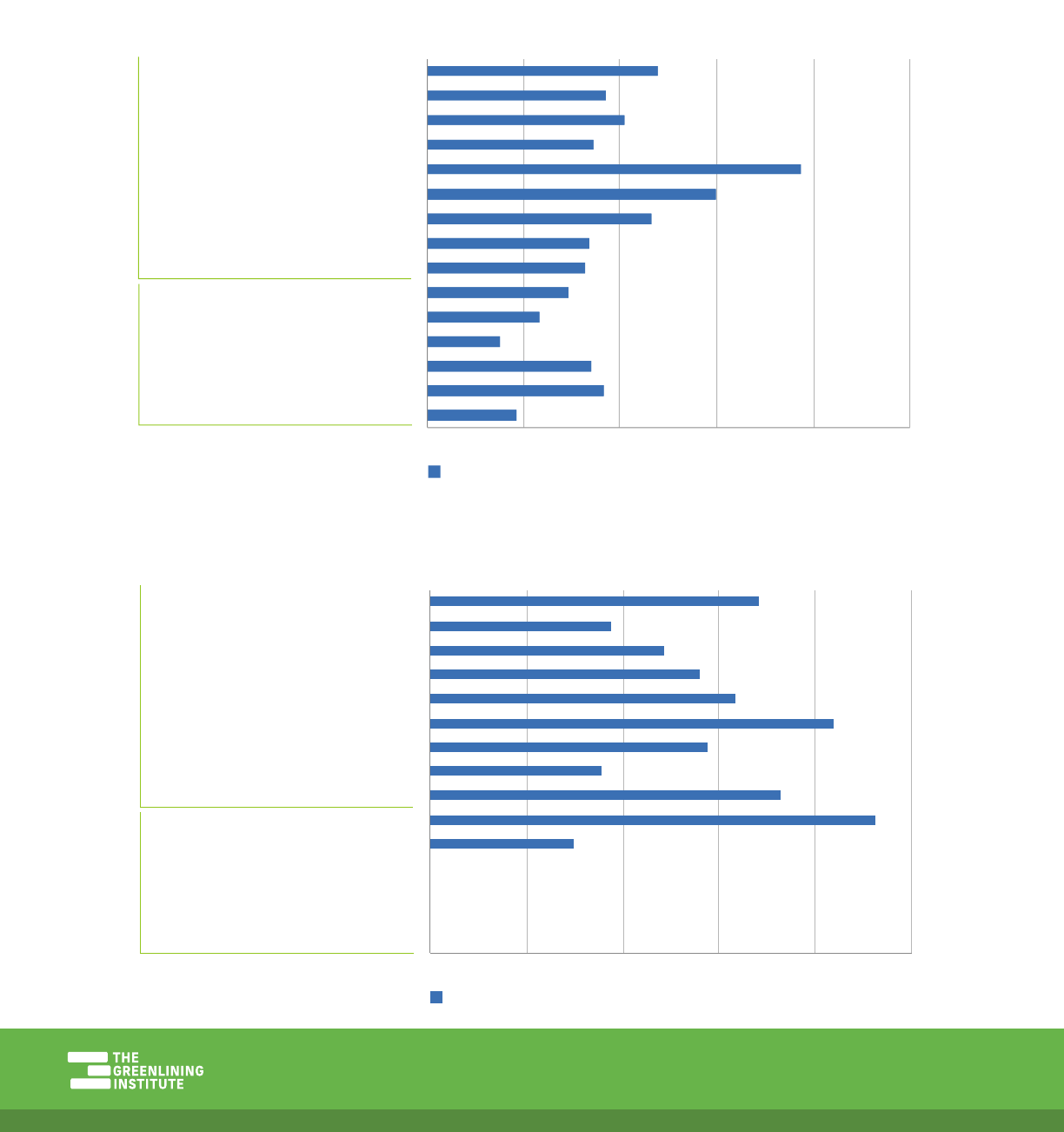
45Home Lending to Communities of Color in California | MARCH 2023
Table 30 illustrates the number of home purchase loan originations for women-identified people of
color (non-White) for each of the top 15 lenders in the Los Angeles MSA in 2021.
Table 30: Home Purchase Loans to Women of Color
0% 5% 10% 15% 20% 25%
Nonbank
Bank
UNITED WHOLESALE MORTGAGE
ROCKET MORTGAGE
LOANDEPOT.COM
FINANCE OF AMERICA MORTGAGE
AMWEST FUNDING
BROKER SOLUTIONS
HOME POINT FINANCIAL
GUARANTEED RATE
HOMEBRIDGE FINANCIAL SERVICES
JPMORGAN CHASE BANK
WELLS FARGO BANK
FIRST REPUBLIC BANK
BANK OF AMERICA
U.S. BANK
CITIBANK
WoC (non-White)
0% 5% 10% 15% 20% 25%
Nonbank
Bank
UNITED WHOLESALE MORTGAGE
ROCKET MORTGAGE
LOANDEPOT.COM
FINANCE OF AMERICA MORTGAGE
AMWEST FUNDING
BROKER SOLUTIONS
HOME POINT FINANCIAL
GUARANTEED RATE
HOMEBRIDGE FINANCIAL SERVICES
JPMORGAN CHASE BANK
WELLS FARGO BANK
FIRST REPUBLIC BANK
BANK OF AMERICA
U.S. BANK
CITIBANK
WoC (non-White)
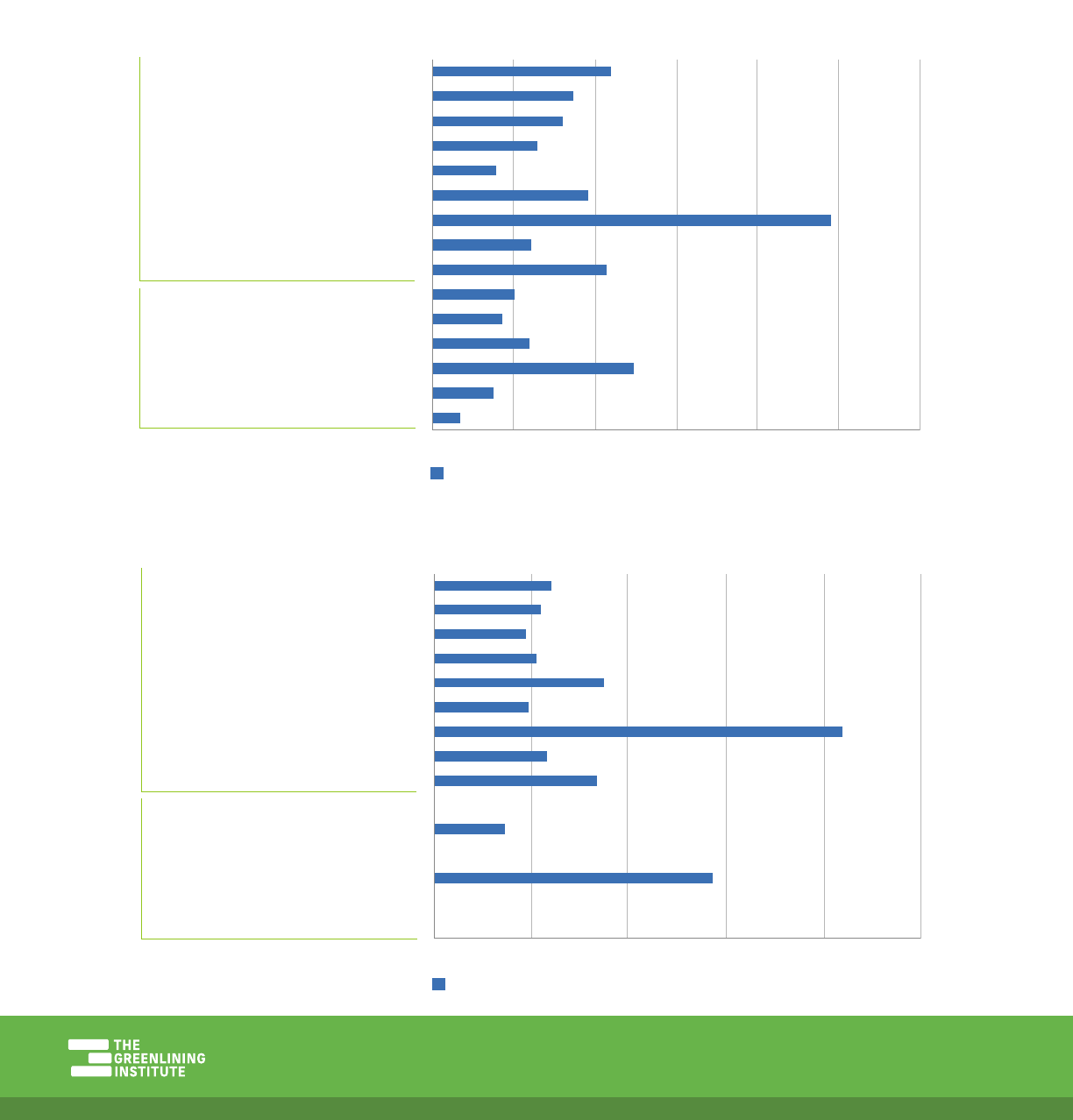
46Home Lending to Communities of Color in California | MARCH 2023
Table 31 below illustrates the number of home purchase loan originations to low-income borrowers,
defined as borrowers who report an income below 80% of the region’s Area Median Income, for each of
the top 15 lenders in the Los Angeles MSA in 2021.
Table 31: Home Purchase Loans to Low-Income Borrowers
0% 2% 4% 6% 8% 10% 12%
Nonbank
Bank
UNITED WHOLESALE MORTGAGE
ROCKET MORTGAGE
LOANDEPOT.COM
FINANCE OF AMERICA MORTGAGE
AMWEST FUNDING
BROKER SOLUTIONS
HOME POINT FINANCIAL
GUARANTEED RATE
HOMEBRIDGE FINANCIAL SERVICES
JPMORGAN CHASE BANK
WELLS FARGO BANK
FIRST REPUBLIC BANK
BANK OF AMERICA
U.S. BANK
CITIBANK
Borrowers < 80% of AMI
Nonbank
Bank
UNITED WHOLESALE MORTGAGE
ROCKET MORTGAGE
LOANDEPOT.COM
FINANCE OF AMERICA MORTGAGE
AMWEST FUNDING
BROKER SOLUTIONS
HOME POINT FINANCIAL
GUARANTEED RATE
HOMEBRIDGE FINANCIAL SERVICES
JPMORGAN CHASE BANK
WELLS FARGO BANK
FIRST REPUBLIC BANK
BANK OF AMERICA
U.S. BANK
CITIBANK
0%
5%
10% 15% 20% 25%
Borrowers < 80% of AMI
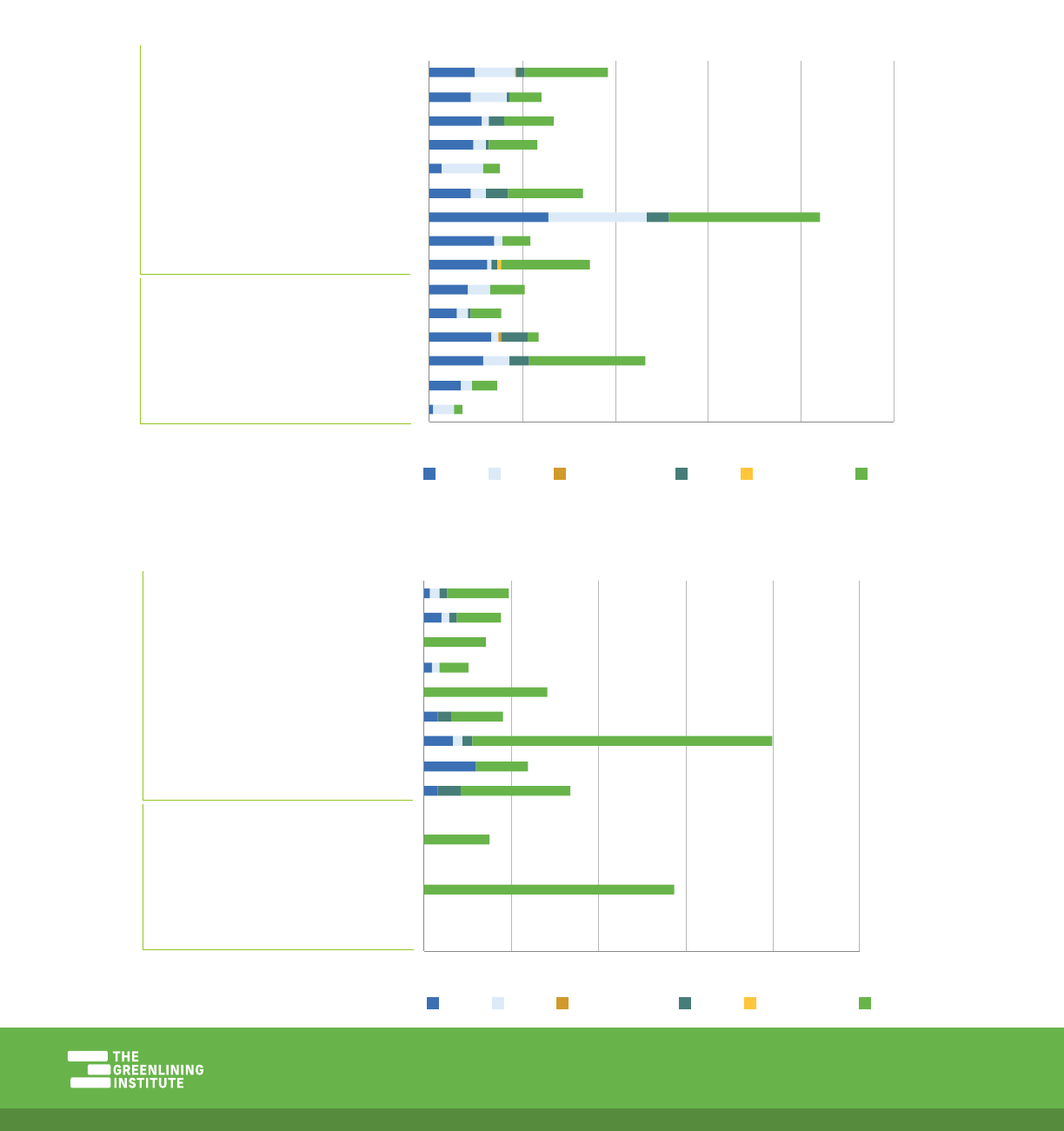
47Home Lending to Communities of Color in California | MARCH 2023
Table 32 below illustrates the number of home purchase loan originations to low-income borrowers by
race for each of the top 15 lenders in the Los Angeles MSA in 2021. Similar to Fresno, Latino households
make up the highest percentage of low-income borrowers across both conventional and government-
subsidized loans.
Table 32 Home Purchase Loans to Low-Income Borrowers by Race
White Asian Native American Black Pacific Islander Latino
0% 2% 4% 6% 8% 10%
UNITED WHOLESALE MORTGAGE
ROCKET MORTGAGE
LOANDEPOT.COM
FINANCE OF AMERICA MORTGAGE
AMWEST FUNDING
BROKER SOLUTIONS
HOME POINT FINANCIAL
GUARANTEED RATE
HOMEBRIDGE FINANCIAL SERVICES
JPMORGAN CHASE BANK
WELLS FARGO BANK
FIRST REPUBLIC BANK
BANK OF AMERICA
U.S. BANK
CITIBANK
Nonbank
Bank
White Asian Native American Black Pacific Islander Latino
UNITED WHOLESALE MORTGAGE
ROCKET MORTGAGE
LOANDEPOT.COM
FINANCE OF AMERICA MORTGAGE
AMWEST FUNDING
BROKER SOLUTIONS
HOME POINT FINANCIAL
GUARANTEED RATE
HOMEBRIDGE FINANCIAL SERVICES
JPMORGAN CHASE BANK
WELLS FARGO BANK
FIRST REPUBLIC BANK
BANK OF AMERICA
U.S. BANK
CITIBANK
Nonbank
Bank
0% 5% 10% 15% 20% 25%
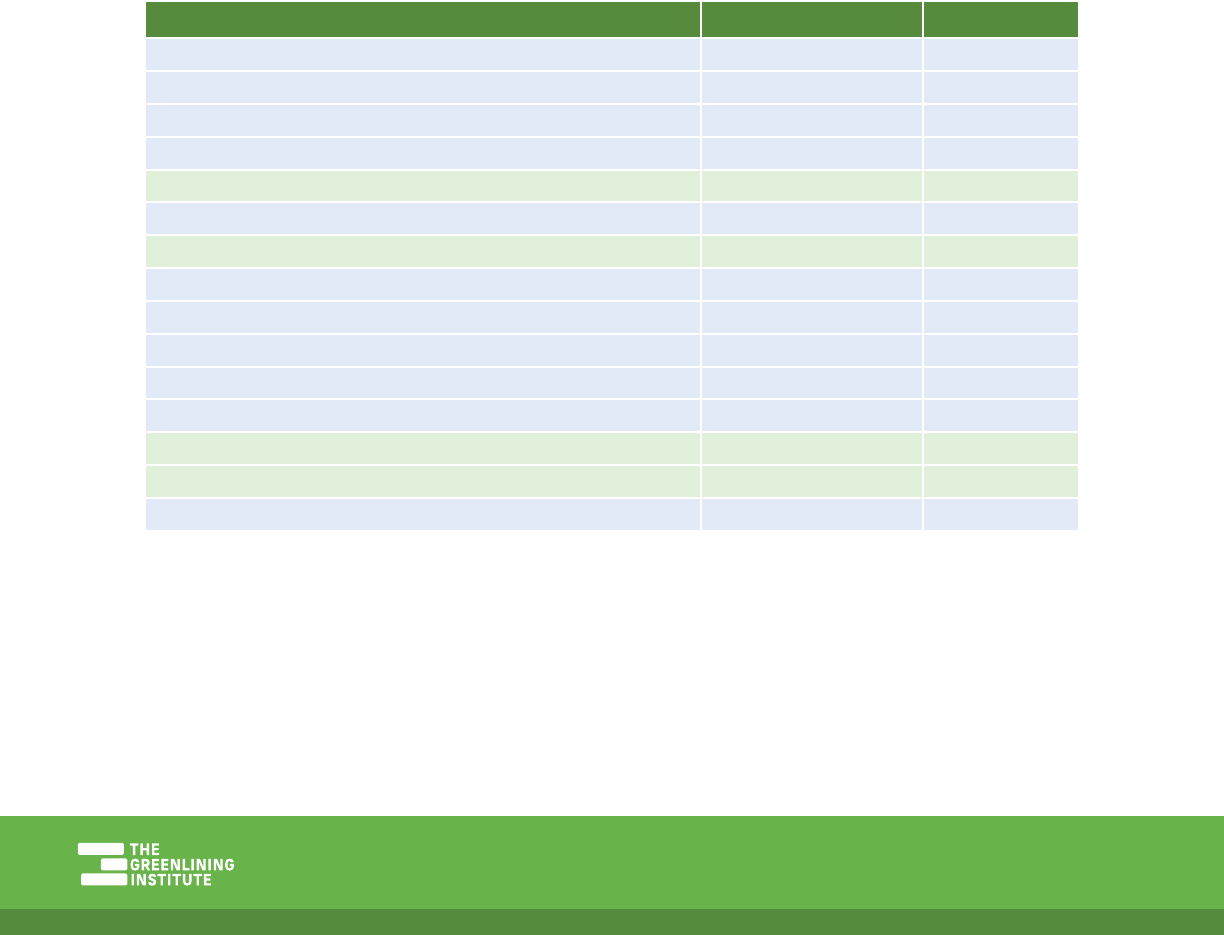
48Home Lending to Communities of Color in California | MARCH 2023
San Diego-Chula Vista-
Carlsbad MSA
Total Population: 3,286,069, 8.37% of California’s population
San Diego-Chula Vista-Carlsbad Demographics
Overview of Lending in San Diego-Chula Vista-Carlsbad
MSA
Lender Type of Lender % of Market
United Wholesale Mortgage Non-Bank 15.05%
Rocket Mortgage Non-Bank 5.98%
Crosscountry Mortgage Non-Bank 3.78%
Loandepot.com Non-Bank 3.15%
Wells Fargo Bank Bank 3.12%
Fairway Independent Mortgage Non-Bank 2.64%
JPMorgan Chase Bank Bank 2.59%
Caliber Home Loans Non-Bank 2.54%
Home Point Financial Non-Bank 2.41%
Guaranteed Rate Non-Bank 2.14%
Finance of America Mortgage Non-Bank 2.08%
American Pacific Mortgage Non-Bank 2.01%
Bank of America Bank 1.79%
U.S. Bank Bank 1.72%
Movement Mortgage Non-Bank 1.64%
*Nonbank lenders are highlighted.
In the San Diego region, Latino households receive far fewer loans relative to their share of the
population than other racial groups in the region. The Latino community in San Diego is the second
largest ethnic group and makes up 35% of the population, but only 16% of home purchase loans,
consistent with last year’s figures.
++N
00++N
04++N
01++N
++N
++N
06++N
11.8%
Asian
0.2%
Native
American
4.4%
Black
0.4%
Pacific
Islander
34.8%
Latino
42.6%
White
5.7%
Other
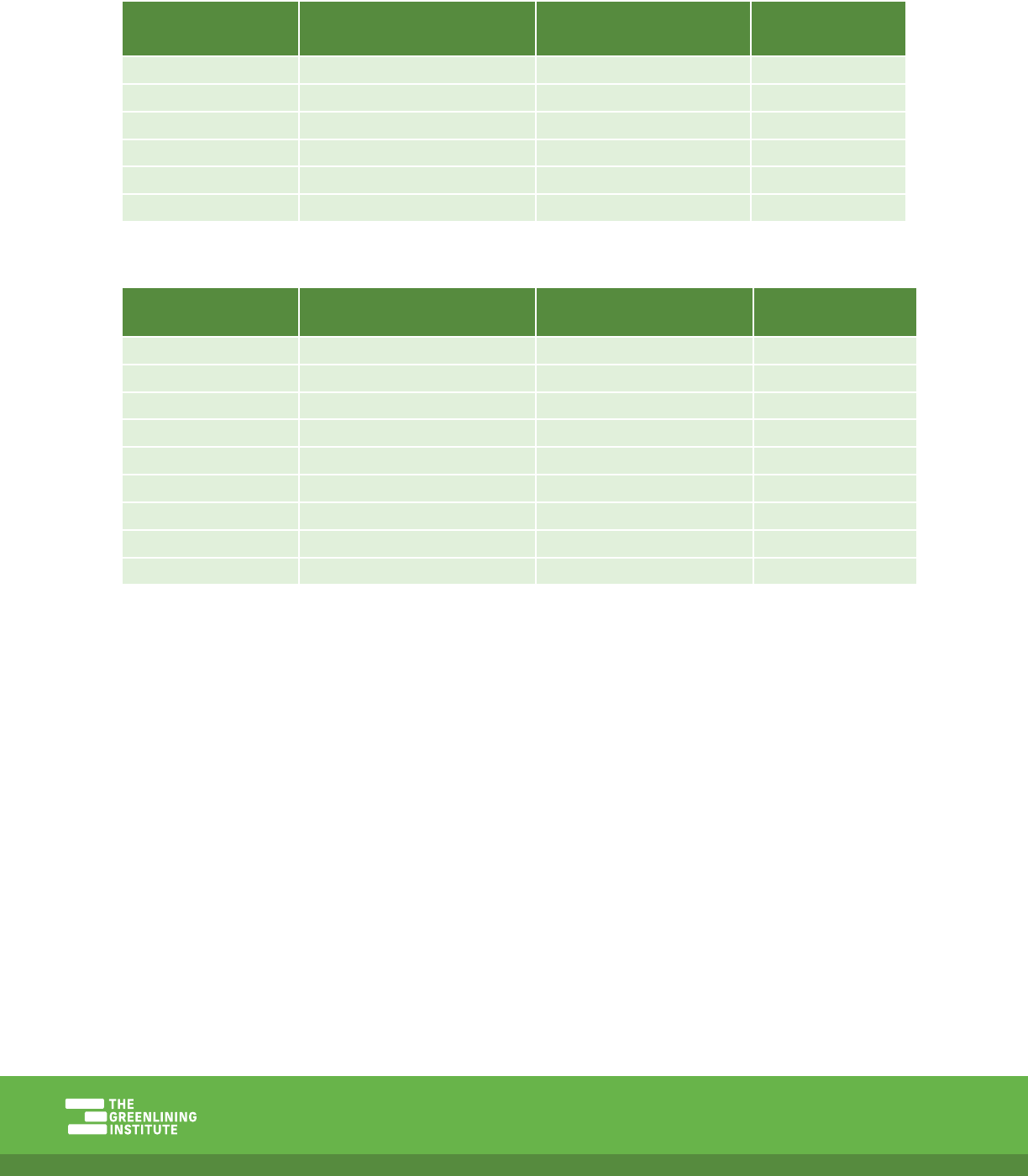
49Home Lending to Communities of Color in California | MARCH 2023
Table 33: Home Purchase Loans by Race for All Lenders
Race Number of Loan Originations
Percent of Loan
Originations
Percent of
Population
White 18,061 44.38% 42.60%
Asian 5,378 13.22% 11.80%
Native American 87 0.21% 0.20%
Black 1,049 2.58% 4.40%
Pacific Islander 103 0.25% 0.40%
Latino 6,492 15.95% 34.80%
Table 34: Home Purchase Loans to Asian Borrowers for All Lenders
Race Number of Loan Originations
Percent of Loan
Originations
Percent of Total
Loan Originations
Asian 1,120 20.83% 2.75%
Asian Indian 941 17.50% 2.31%
Chinese 947 17.61% 2.33%
Filipino 963 17.91% 2.37%
Japanese 98 1.82% 0.24%
Korean 329 6.12% 0.81%
Vietnamese 463 8.61% 1.14%
Asian Other 337 6.27% 0.83%
Multi-Asian 180 3.35% 0.44%
Top 15 Lenders in San Diego-Chula Vista-Carlsbad MSA
The top 15 lenders in the San Diego region account for 53% of the market. The top lender, United
Wholesale Mortgage, accounts for over 15% of all loan originations.
Table 35 below illustrates the number of home purchase loan originations by race for each of the top
15 lenders in the San Diego MSA in 2021.
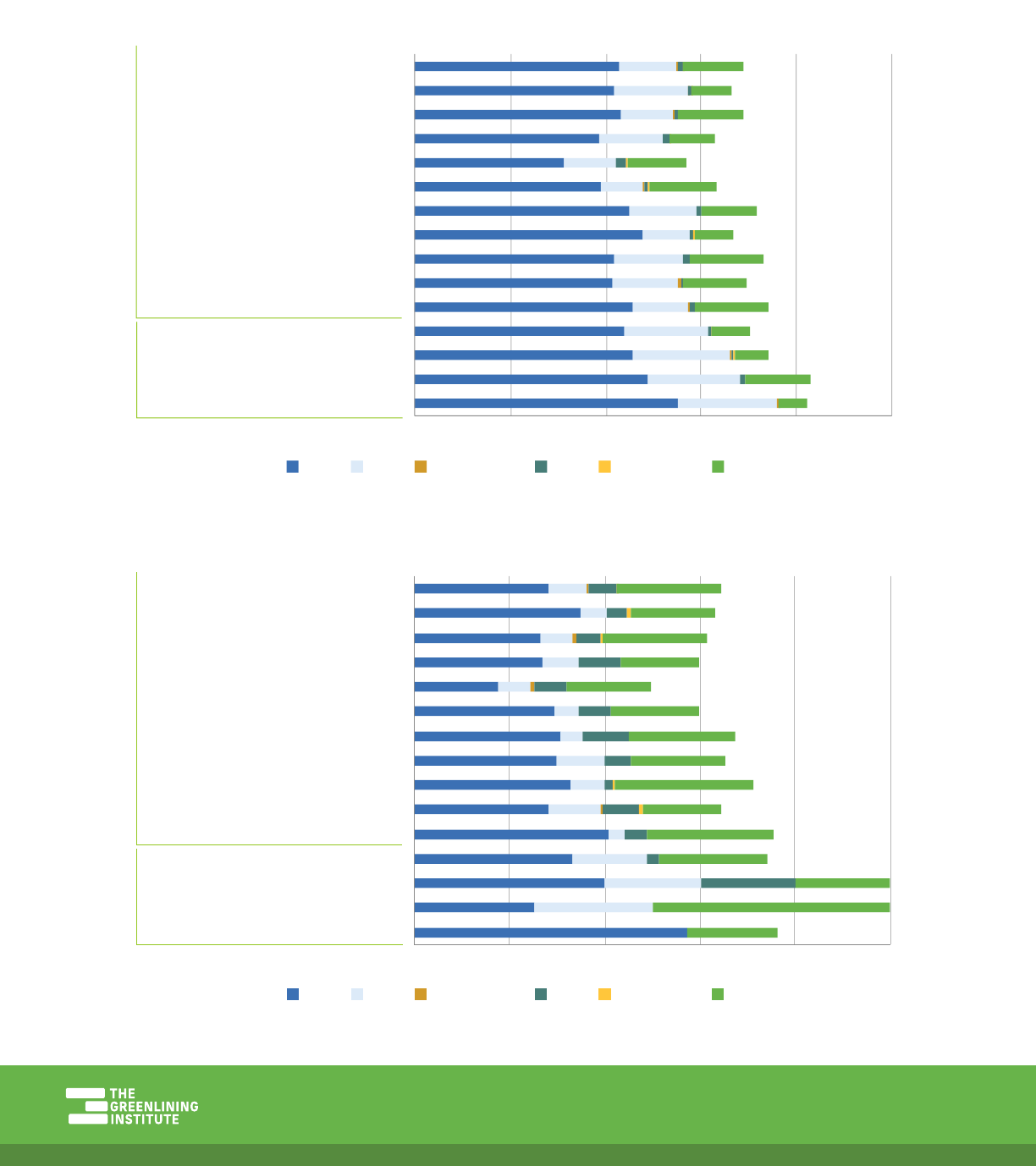
50Home Lending to Communities of Color in California | MARCH 2023
Table 35: Home Purchase Loans by Race
White Asian Native American Black Pacific Islander Latino
UNITED WHOLESALE MORTGAGE
ROCKET MORTGAGE
CROSSCOUNTRY MORTGAGE
LOANDEPOT.COM
FAIRWAY INDEPENDENT MORTGAGE
CALIBER HOME LOANS
HOME POINT FINANCIAL
GUARANTEED RATE
FINANCE OF AMERICA MORTGAGE
AMERICAN PACIFIC MORTGAGE
MOVEMENT MORTGAGE
WELLS FARGO BANK
JPMORGAN CHASE BANK
BANK OF AMERICA
U.S. BANK
Nonbank
Bank
0% 20% 40% 60% 80% 100%
White Asian Native American Black Pacific Islander Latino
UNITED WHOLESALE MORTGAGE
ROCKET MORTGAGE
CROSSCOUNTRY MORTGAGE
LOANDEPOT.COM
FAIRWAY INDEPENDENT MORTGAGE
CALIBER HOME LOANS
HOME POINT FINANCIAL
GUARANTEED RATE
FINANCE OF AMERICA MORTGAGE
AMERICAN PACIFIC MORTGAGE
MOVEMENT MORTGAGE
WELLS FARGO BANK
JPMORGAN CHASE BANK
BANK OF AMERICA
U.S. BANK
Nonbank
Bank
0% 20% 40% 60% 80% 100%
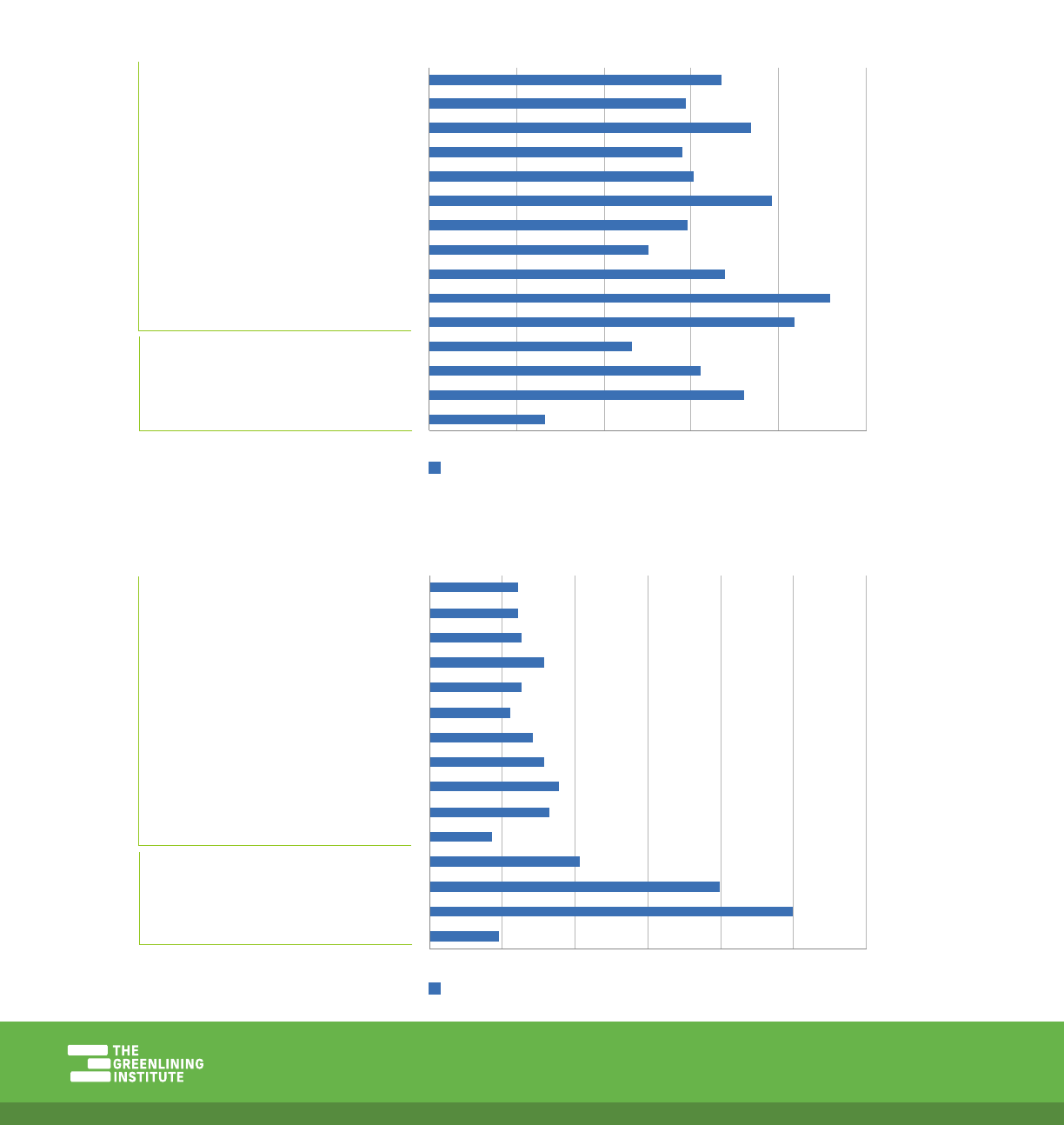
51Home Lending to Communities of Color in California | MARCH 2023
Table 36 illustrates the number of home purchase loan originations for women-identified people of
color (non-White) for each of the top 15 lenders in the San Diego MSA in 2021.
Table 36: Home Purchase Loans to Women of Color
0% 2% 4% 6% 8% 10%
Nonbank
Bank
UNITED WHOLESALE MORTGAGE
ROCKET MORTGAGE
CROSSCOUNTRY MORTGAGE
LOANDEPOT.COM
FAIRWAY INDEPENDENT MORTGAGE
CALIBER HOME LOANS
HOME POINT FINANCIAL
GUARANTEED RATE
FINANCE OF AMERICA MORTGAGE
AMERICAN PACIFIC MORTGAGE
MOVEMENT MORTGAGE
WELLS FARGO BANK
JPMORGAN CHASE BANK
BANK OF AMERICA
U.S. BANK
WoC (non-White)
0% 5% 10% 15% 20% 25% 30%
Nonbank
Bank
UNITED WHOLESALE MORTGAGE
ROCKET MORTGAGE
CROSSCOUNTRY MORTGAGE
LOANDEPOT.COM
FAIRWAY INDEPENDENT MORTGAGE
CALIBER HOME LOANS
HOME POINT FINANCIAL
GUARANTEED RATE
FINANCE OF AMERICA MORTGAGE
AMERICAN PACIFIC MORTGAGE
MOVEMENT MORTGAGE
WELLS FARGO BANK
JPMORGAN CHASE BANK
BANK OF AMERICA
U.S. BANK
WoC (non-White)
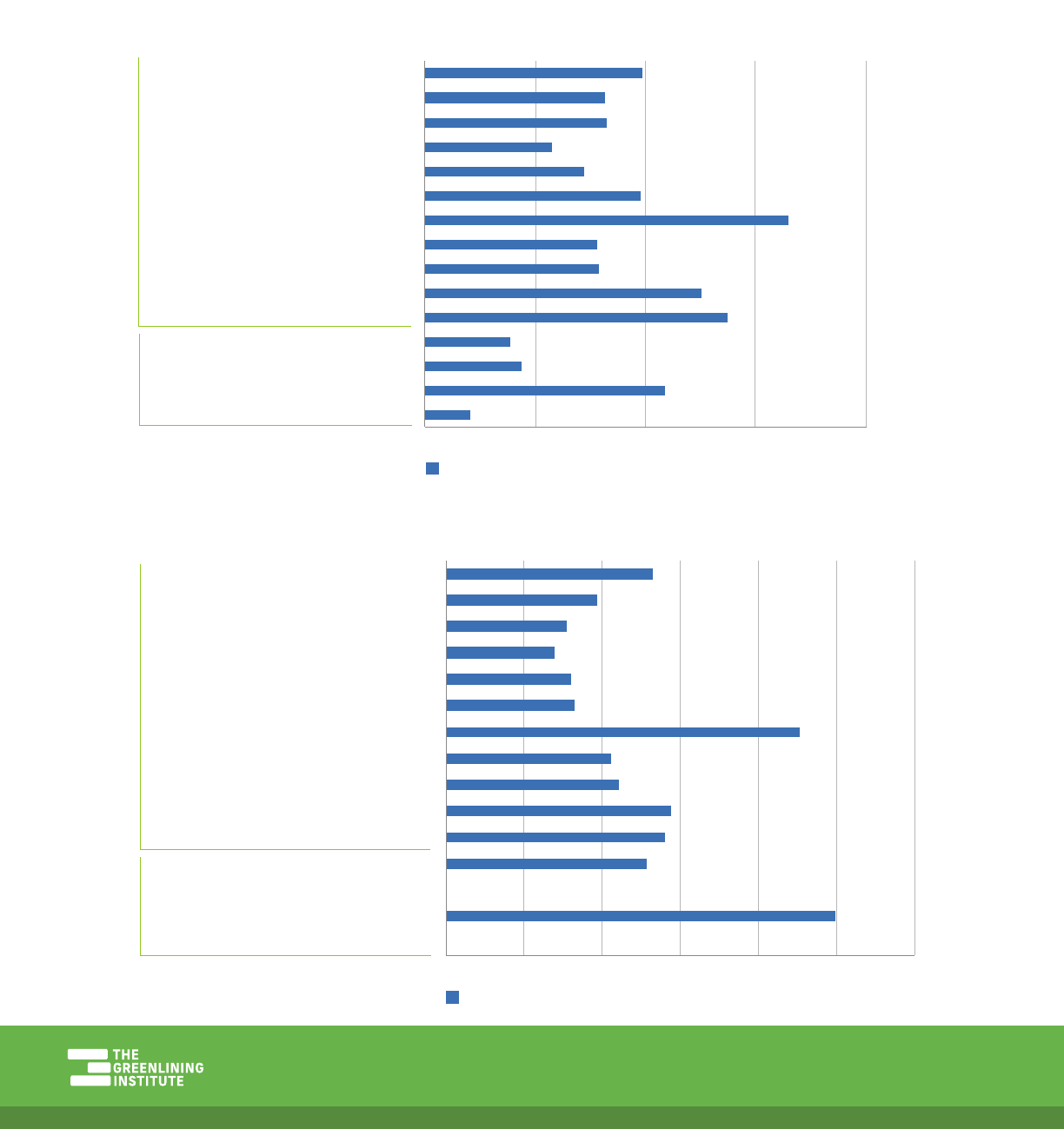
52Home Lending to Communities of Color in California | MARCH 2023
Table 37 below illustrates the number of home purchase loan originations to low-income borrowers,
defined as borrowers who report an income below 80% of the region’s Area Median Income, for each of
the top 15 lenders in the San Diego MSA in 2021.
Table 37: Home Purchase Loans to Low-Income Borrowers
Nonbank
Bank
Borrowers < 80% of AMI
0% 5% 10% 15% 20%
UNITED WHOLESALE MORTGAGE
ROCKET MORTGAGE
CROSSCOUNTRY MORTGAGE
LOANDEPOT.COM
FAIRWAY INDEPENDENT MORTGAGE
CALIBER HOME LOANS
HOME POINT FINANCIAL
GUARANTEED RATE
FINANCE OF AMERICA MORTGAGE
AMERICAN PACIFIC MORTGAGE
MOVEMENT MORTGAGE
WELLS FARGO BANK
JPMORGAN CHASE BANK
BANK OF AMERICA
U.S. BANK
Borrowers < 80% of AMI
0% 5% 15% 20% 25% 30% 35%
Nonbank
Bank
UNITED WHOLESALE MORTGAGE
ROCKET MORTGAGE
CROSSCOUNTRY MORTGAGE
LOANDEPOT.COM
FAIRWAY INDEPENDENT MORTGAGE
CALIBER HOME LOANS
HOME POINT FINANCIAL
GUARANTEED RATE
FINANCE OF AMERICA MORTGAGE
AMERICAN PACIFIC MORTGAGE
MOVEMENT MORTGAGE
WELLS FARGO BANK
JPMORGAN CHASE BANK
BANK OF AMERICA
U.S. BANK
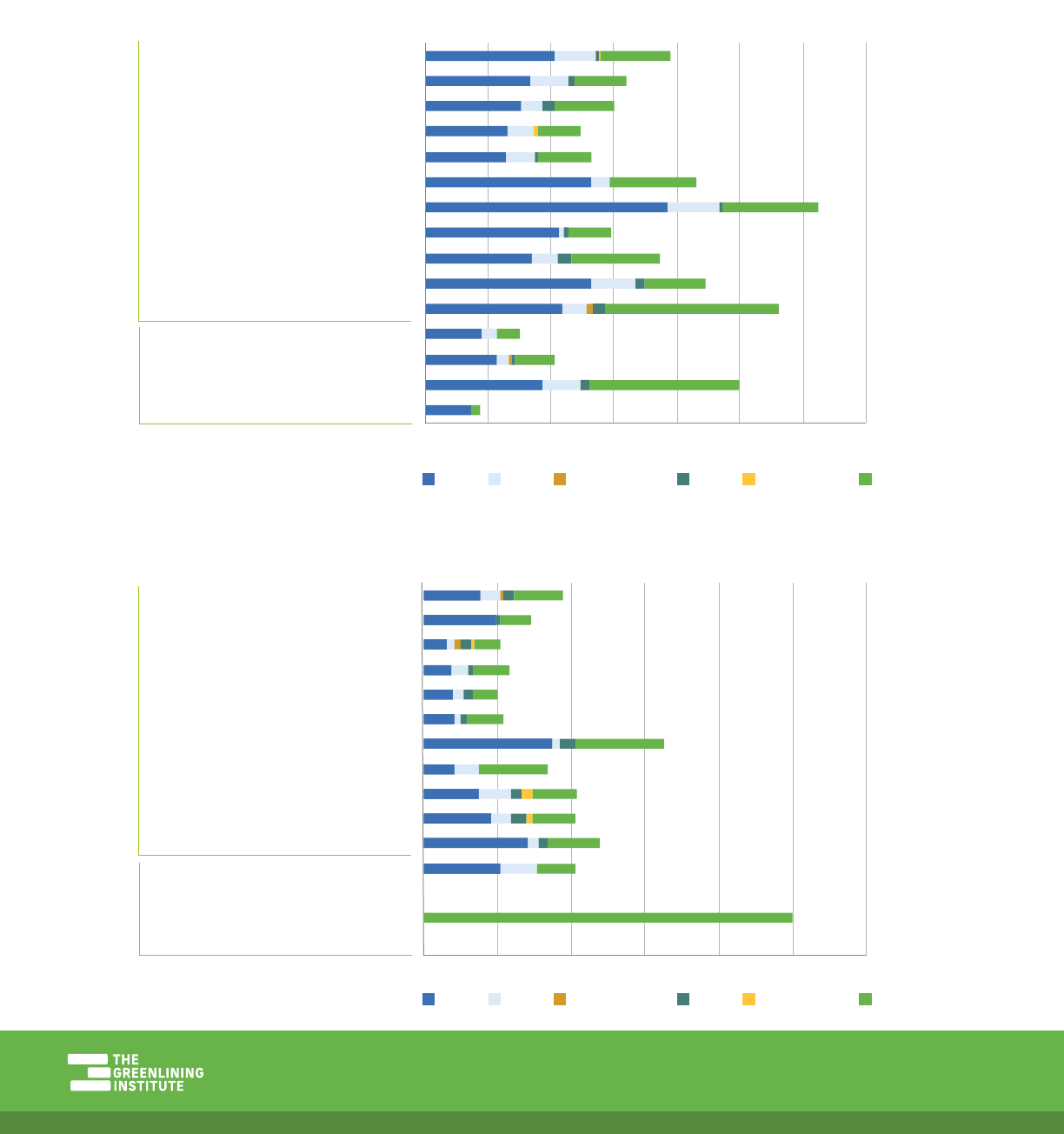
53Home Lending to Communities of Color in California | MARCH 2023
Table 38 below illustrates the number of home purchase loan originations to low-income borrowers
by race for each of the top 15 lenders in the San Diego MSA in 2021. White borrowers represent the
highest share of low-income borrowers.
Table 38: Home Purchase Loans by Low-Income Borrowers by Race
UNITED WHOLESALE MORTGAGE
ROCKET MORTGAGE
CROSSCOUNTRY MORTGAGE
LOANDEPOT.COM
FAIRWAY INDEPENDENT MORTGAGE
CALIBER HOME LOANS
HOME POINT FINANCIAL
GUARANTEED RATE
FINANCE OF AMERICA MORTGAGE
AMERICAN PACIFIC MORTGAGE
MOVEMENT MORTGAGE
WELLS FARGO BANK
JPMORGAN CHASE BANK
BANK OF AMERICA
U.S. BANK
White Asian Native American Black Pacific Islander Latino
Nonbank
Bank
0% 2% 4% 6% 8% 10% 12% 14%
UNITED WHOLESALE MORTGAGE
ROCKET MORTGAGE
CROSSCOUNTRY MORTGAGE
LOANDEPOT.COM
FAIRWAY INDEPENDENT MORTGAGE
CALIBER HOME LOANS
HOME POINT FINANCIAL
GUARANTEED RATE
FINANCE OF AMERICA MORTGAGE
AMERICAN PACIFIC MORTGAGE
MOVEMENT MORTGAGE
WELLS FARGO BANK
JPMORGAN CHASE BANK
BANK OF AMERICA
U.S. BANK
White Asian Native American Black Pacific Islander Latino
30%25%20%15%
10%5%0%
Nonbank
Bank
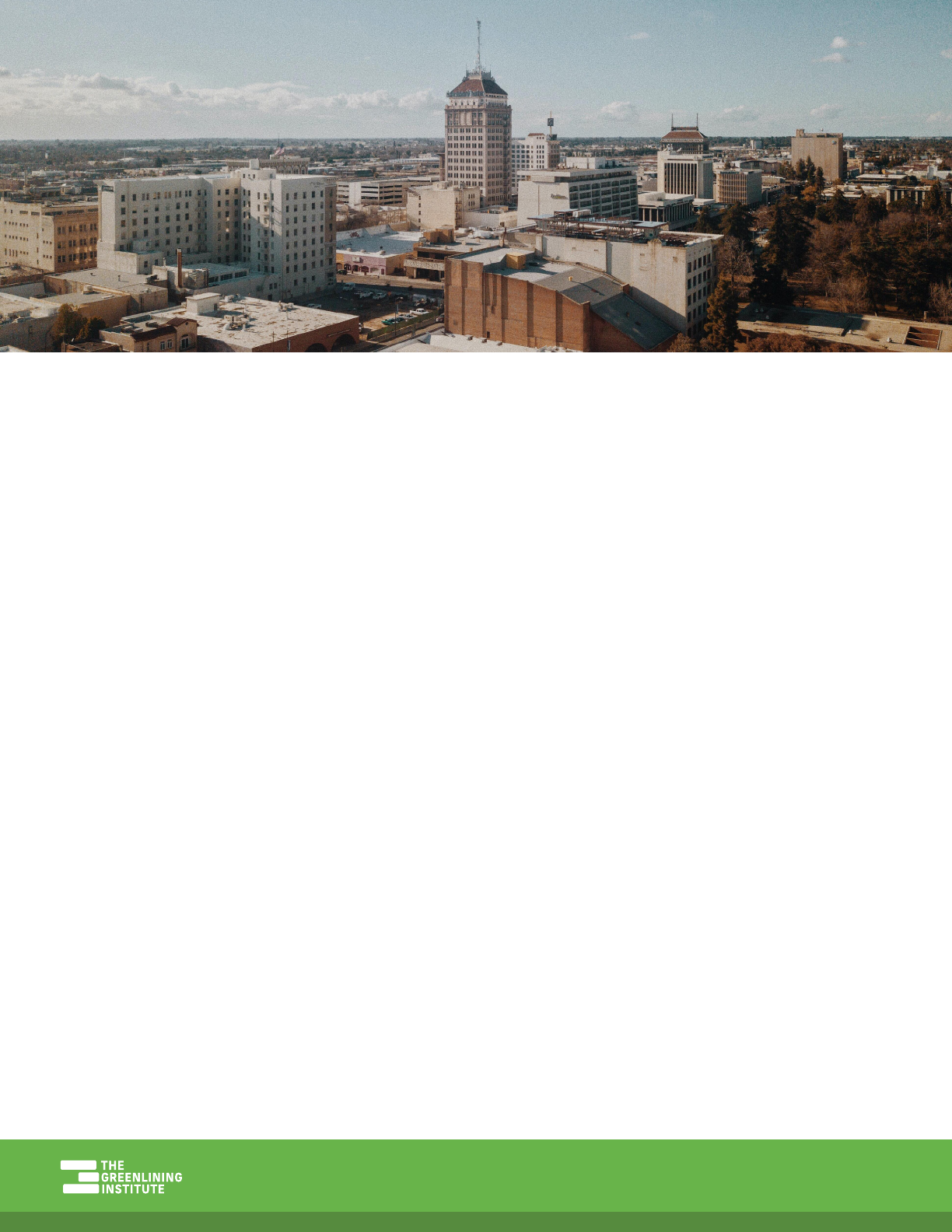
54Home Lending to Communities of Color in California | MARCH 2023
Policy Recommendations
Homeownership forms the bedrock of wealth building. Home lending to communities of color must
increase to establish financial stability for future generations. This will require a comprehensive eort
by nonbank lenders, traditional banks, financial regulators and state and federal policymakers to
ensure that a continuous practice of racial equity and transparency is applied to the deployment of
financial products, services and investments.
As our research shows, across California’s regions people of color are less likely to successfully access
home loans despite making up a majority of the state. This is of particular concern to Black, Latino
and immigrant communities. Even among low-income communities, white households are more likely
than people of color to successfully take out a home purchase loan. Further, women of color face the
highest gap between the size of their population and their ability to access home mortgages, which
means this population should receive even more targeted attention and resources.
Lastly, the mortgage market is evolving and it’s just as likely that today’s borrower will receive a loan
from an online, nonbank lender as from a traditional bank. Nonbank lenders can provide important
competition to traditional banks and drive down costs for consumers while serving customers who
currently fall through the cracks, but inadequate regulation of these lenders remains a concern. It will
be incumbent upon these nonbank lenders, which are not regulated by the Community Reinvestment
Act, to proactively support California’s communities of color and demonstrate their commitment to
closing the racial wealth gap through equitable, safe and aordable products.
Photo credit: Grant Porter via Unsplash
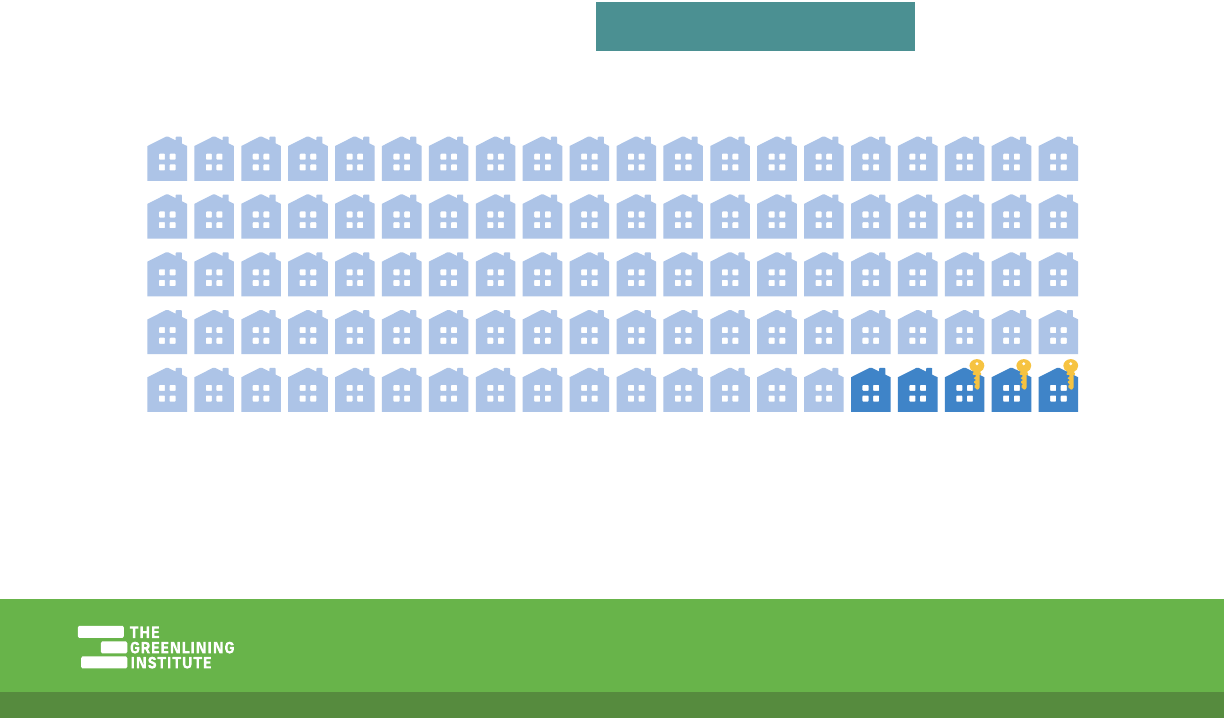
55Home Lending to Communities of Color in California | MARCH 2023
In light of our research, Greenlining recommends the following steps be taken:
For Legislators and Financial Regulators:
1. Create a California Community Reinvestment Act. Unlike traditional banks, nonbank lenders
are not covered by the federal Community Reinvestment Act, despite the similarity in their loan
products and services. As such, nonbank lenders should have the same mandate to serve low- to
moderate-income communities as traditional banks, and this mandate can come from the state. A
state-level California CRA could:
• Incentivize relationships between nonbank lenders and nonprofit organizations that serve LMI
communities and communities of color.
• Rebuild and significantly increase investments in low- to moderate income communities that
do not have access to physical banks in their communities.
• Require lenders to oer the best possible mortgage products to clients.
• Ensure corporate accountability for financial institutions.
• Test for fair lending to all racial and ethnic groups, in comparison to peer lenders.
Four states — New York, Connecticut, Illinois, and Massachusetts—have already implemented a
CRA to meet the needs of their community.
Black households access THREE PERCENT of home
loans, while making up over 5% of the population.
Figure 3: Home Purchase Loans by Race and Gender

56Home Lending to Communities of Color in California | MARCH 2023
2. Regulate credit unions, mortgage lenders and insurance providers and require them
to invest in low- to moderate income communities. The California CRA should also be a
mechanism for expanding beyond the limitations of the federal CRA—requiring traditional banks
without a physical presence in low- to moderate income communities to still invest in these areas.
A California CRA would benefit by adopting features similar to the law in Massachusetts, creating
a racial equity lens in examining lending practices to ensure that communities of color are treated
equally with white community members.
3. Provide more targeted support on federal and state levels. At the federal level, the Home
Mortgage Disclosure Act should be made stronger, more accessible, with easier-to-access data
that is disaggregated by dierent racial and ethnic communities. At the state level, California
regulators should help to lead the discussion around the evolving, technology-oriented mortgage
market with the goal of incentivizing innovation and lower costs while protecting consumers and
underserved communities.
4. Mitigate the disproportionate impacts of home lending barriers for low-income people of
color as it relates to government-subsidized versus conventional loans. Low-income people
of color are more likely to be illegally steered toward government-subsidized loans even if they
qualify for a conventional loan. This may limit their choice of properties they can purchase and
constrain their loan payment options. Regulators must understand that this is a form of ongoing
redlining and mitigate its impact. One option, as reported by the Urban Institute, is to establish
a federal liquidity facility for mortgage servicing advances, particularly in the face of COVID-19
ripple eects on credit tightening and forbearance.
30
The federal government could also take steps
to make government-subsidized loans more competitive in the housing market, aligning FHA/VA
rules more closely with those of Fannie Mae and Freddie Mac.
31
For Lenders:
1. Tailor more loan products and outreach to low and moderate income families. These targeted
investments in communities are not only the right thing to do, they will lead to increased business
for lenders and improve a lender’s bottom line. Financial institutions should increase mortgage
originations to communities of color through alternative products to government-subsidized
loans.
2. Increase funding to nonprofits led by people of color to support homeownership counseling.
It is important that first-time homeowners, especially those from communities which are oen
targeted by predatory lending, have as much information and training as possible to help them
make important financial decisions during the homebuying process.
3. Increase branch presence in rural communities as well as support for broadband
deployment. Rural communities, especially communities of color, are oen le out of most
traditional banks’ footprint. Increased attention must be paid to both bank branches as well as
philanthropic support for broadband deployment in underserved communities, which becomes
absolutely vital as more and more banking services shi online.

57Home Lending to Communities of Color in California | MARCH 2023
4. Increase cultural competency in both products and marketing. Lenders should invest heavily
in ethnic media for their marketing eorts, which will help ensure they reach consumers not well
served by mainstream media, as well as help to support businesses owned by people of color.
Further, lenders should prioritize delivering their products and services in the languages spoken by
California’s diverse communities and ensure that all communities, regardless of English proficiency,
are protected against predatory practices and treated fairly.
5. Create stronger, win-win community partnerships and agreements. Lenders, regardless of
whether they are traditional banks, fintech firms or nonbank mortgage institutions, should meet
with California community groups annually to hear from those most impacted by their lending
practices. This year and in the coming years we will see more mergers and acquisitions that place
a systemic risk on our financial system. The only way to ensure a continued commitment to
communities is for lenders, especially those not obligated to create CRA plans, to make clear and
specific commitments to communities through Community Benefits Agreements that underscore
their responsibility to their consumers.
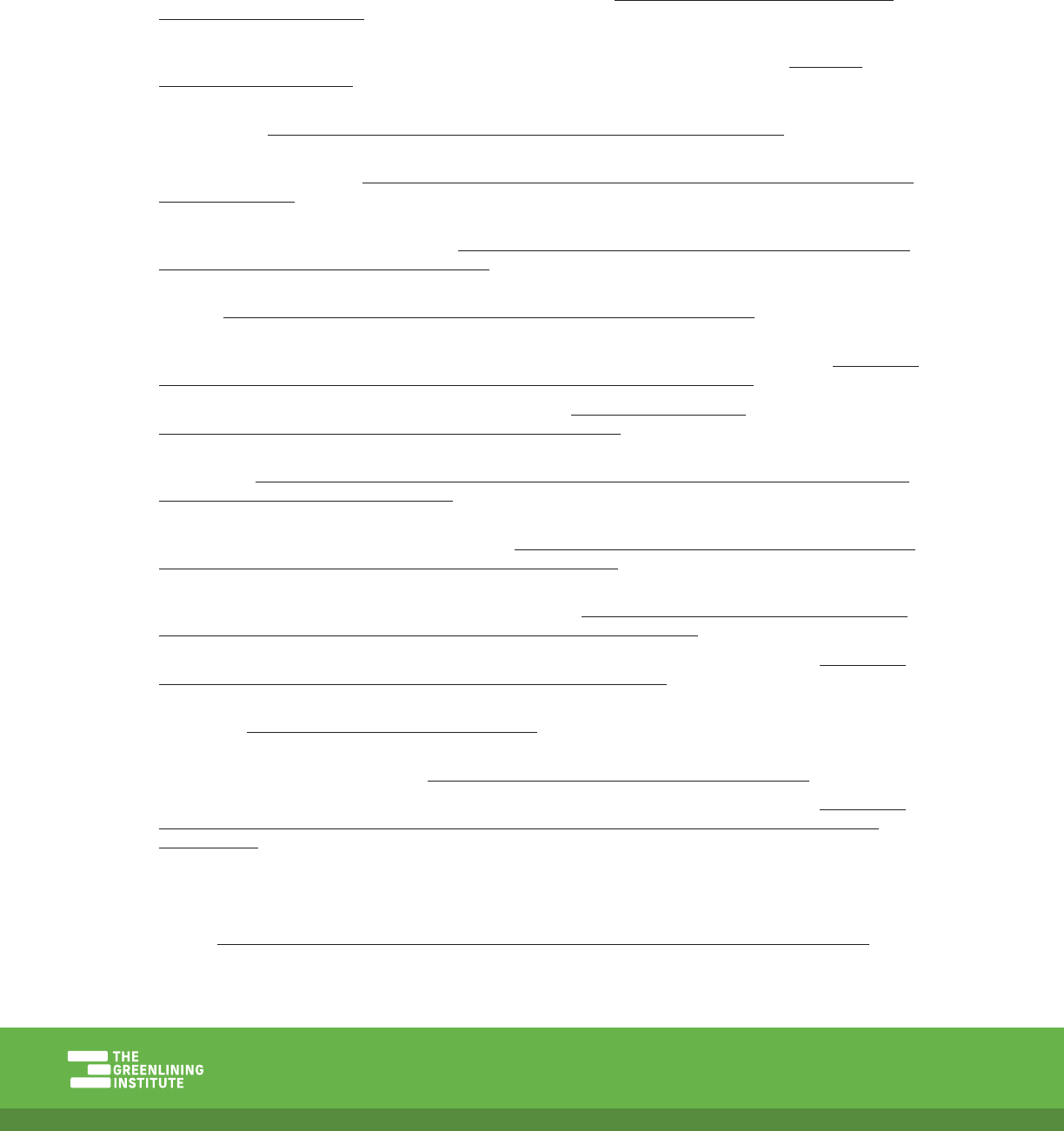
58Home Lending to Communities of Color in California | MARCH 2023
References
1 Agarwal, S., et al. (2021). Renancing Inequality During the COVID-19 Pandemic (Working Paper 2021-08). Federal Deposit
Insurance Corporation, Center for Financial Research Working Papers. https://www.fdic.gov/analysis/cfr/working-
papers/2021/cfr-wp2021-08.pdf
2 Aladangady, Aditya, Elliot Anenberg, and Daniel Garcia (2022). “House Price Growth and Inflation During COVID-19,”
FEDS Notes. Washington: Board of Governors of the Federal Reserve System, November 17, 2022, https://doi.
org/10.17016/2380-7172.3228.
3 Alameldin, Muhammad, and Rawan Elhalaby. “A Fair Financial System: Regulating Fintech and Nonbank Lenders,”
August 18, 2021. https://greenlining.org/publications/2021/regulating-fintech-nonbank-lenders/.
4 Andrews, Edmund L. “A COVID Reckoning: American Households Have Big Bills Coming Due.” Stanford Graduate School
of Business, February 22, 2021. https://www.gsb.stanford.edu/insights/covid-reckoning-american-households-have-
big-bills-coming-due.
5 Choi, Jung Hyun, and Amalie Zinn. “New Data Show Black and Latino Homeownership Rates Increased during the
Pandemic.” Urban Institute, October 07, 2022. https://www.urban.org/urban-wire/new-data-show-black-and-latino-
homeownership-rates-increased-during-pandemic.
6 Cohen, Patricia. “Beyond Pandemic’s Upheaval, a Racial Wealth Gap Endures.” The New York Times, April 9, 2021, sec.
Business. https://www.nytimes.com/2021/04/09/business/economy/racial-wealth-gap.html.
7 Dettling, Lisa, and Lauren Lambie-Hanson. “Why Is the Default Rate So Low? How Economic Conditions and Public
Policies Have Shaped Mortgage and Auto Delinquencies During the COVID-19 Pandemic,” March 4, 2021. https://www.
federalreserve.gov/econres/notes/feds-notes/why-is-the-default-rate-so-low-20210304.htm.
8 “FRED Graph | FRED | St. Louis Fed.” Accessed October 30, 2021. https://fred.stlouisfed.org/
graph/?id=RSAHORUSQ156S,HOLHORUSQ156N,BOAAAHORUSQ156N,#.
9 Glover, J. (2021, February 12). Black California couple lowballed by $500K in home appraisal, believe race was a factor.
ABC7 Chicago. https://abc7chicago.com/black-homeowner-problems-sf-bay-area-housing-discrimination-minority-
homeownership-anti-black-policy/10331076/
10 Goodman, Laurie, and Karan Kaul. “The FHA’s New Loss Mitigation Waterfall Will Oer Much-Needed Relief to Borrowers
Exiting Forbearance.” Urban Institute, August 25, 2021. https://www.urban.org/urban-wire/fhas-new-loss-mitigation-
waterfall-will-oer-much-needed-relief-borrowers-exiting-forbearance.
11 Goodman, Laurie, and Janneke Ratclie. “The Tight Housing Market Boxes Out Government-Insured Borrowers,
Widening Homeownership Gaps.” Urban Institute, June 16, 2021. https://www.urban.org/urban-wire/tight-housing-
market-boxes-out-government-insured-borrowers-widening-homeownership-gaps.
12 Hale, Daniel. “A Comparison between Conventional and Government Issued Loans.” al, March 6, 2019. https://www.
al.com/mortgagesandloans/2017/06/a_comparison_between_conventio.html.
13 Hancock Alfaro, Ange-Marie. “Report: California’s Women of Color Face Extra Burdens from Housing Crisis | California
YIMBY,” 2019. https://cayimby.org/women-of-color-report/.
14 Jayashankar, Aparna, and Anthony Murphy. “High inflation disproportionately hurts low-income households.” Federal
Reserve Bank of Dallas, January 10, 2023.https://www.dallasfed.org/research/economics/2023/0110.
15 “Kaul and Tozer - The Need for a Federal Liquidity Facility for Gove.Pdf.” Accessed November 14, 2021. https://www.
urban.org/sites/default/files/publication/102580/the-need-for-a-federal-liquidity-facility-for-government-loan-
servicing_1.pdf.
16 Kaul, Karan, and Ted Tozer. “The Need for a Federal Liquidity Facility for Government Loan Servicing.” The Urban
Institute, July 2020, 10.
17 McCarey, Orla. “Nonbank Lenders Are Dominating the Mortgage Market.” Wall Street Journal, June 22, 2021, sec.
Markets. https://www.wsj.com/articles/nonbank-lenders-are-dominating-the-mortgage-market-11624367460.
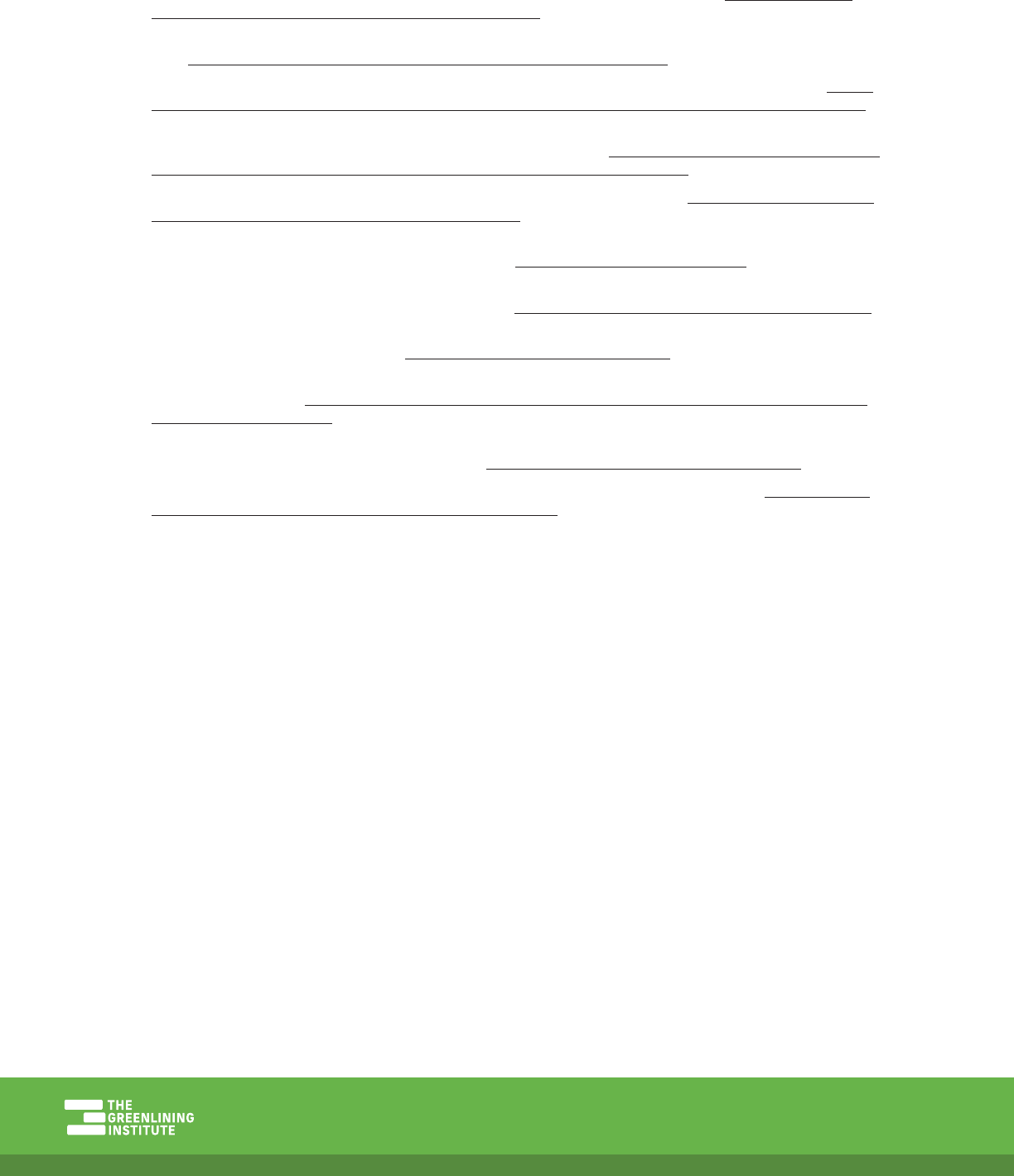
59Home Lending to Communities of Color in California | MARCH 2023
18 NCRC v. RMC Appraisal Services. NCRC. (2022, November 4). Retrieved January 20, 2023, from https://ncrc.org/wp-
content/uploads/2022/11/NCRC-v.-RMC-Appraisal-Services.pdf
19 Neal, Michael, and Laurie Goodman. “The Pandemic Is Shrinking the Mortgage Credit Box.” Urban Institute, April 17,
2021. https://www.urban.org/urban-wire/pandemic-shrinking-mortgage-credit-box.
20 “Report Finds FHA & VA Lending Disproportionately Prevalent in Neighborhoods of Color | Crc,” July 19, 2012. https://
calreinvest.org/press-release/report-finds-fha-va-lending-disproportionately-prevalent-in-neighborhoods-of-color/.
21 Reynolds, Liam, Vanessa Perry, and Jung Hyun Choi. “Closing the Homeownership Gap Will Require Rooting Systemic
Racism Out of Mortgage Underwriting.” Urban Institute, October 13, 2021. https://www.urban.org/urban-wire/closing-
homeownership-gap-will-require-rooting-systemic-racism-out-mortgage-underwriting.
22 American Banker. “Signs Point to More Bank-Nonbank M&A in 2021,” January 27, 2021. https://www.americanbanker.
com/news/signs-point-to-more-bank-nonbank-m-a-in-2021.
23 Submitter, BCFP Data Point. “An Updated Review of the New and Revised Data Points in HMDA: Further Observations
Using the 2019 HMDA Data.” SSRN Electronic Journal, 2020. https://doi.org/10.2139/ssrn.3786976.
24 U.S. Census Bureau. “30-Year Fixed Rate Mortgage Average in the United States.” FRED, Federal Reserve Bank of St. Louis.
FRED, Federal Reserve Bank of St. Louis, January 12, 2023. https://https://fred.stlouisfed.org/series/MORTGAGE30US.
25 U.S. Census Bureau. “Homeownership Rate for California.” FRED, Federal Reserve Bank of St. Louis. FRED, Federal
Reserve Bank of St. Louis, March 9, 2021. https://fred.stlouisfed.org/series/CAHOWN.
26 Wamsley, Laurel. “Black and Latino Families Continue to Bear Pandemic’s Great Economic Toll in U.S.” NPR, October 25,
2021, sec. Public Health. https://www.npr.org/sections/health-shots/2021/10/25/1048202711/covid-economic-pain-
black-latino-native-american.
27 Williamson, J. & Palim, M. (2022). Appraising the Appraisal (A closer look at divergent appraisal values for Black and
white borrowers refinancing their home). Fannie Mae. https://www.fanniemae.com/media/42541/display.
28 Yun, Lawrence, Jessica Lautz, and Meredith Dunn. “Loan Type Survey.” www.nar.realtor, April 2021. https://www.nar.
realtor/research-and-statistics/research-reports/loan-type-survey.

60Home Lending to Communities of Color in California | MARCH 2023
Endnotes
1 https://greenlining.org/work/economic-equity/housing-and-homeownership/
2 Data collection became a challenge for the U.S. Census Bureau amidst the pandemic leading to more fluctuations
in statistics gathered by the Current Population Survey/Housing Vacancies and Homeownership Survey (CPS/HVS).
Despite the lack of accurate information regarding homeownership rates in 2020 that resulted from smaller sample
sizes, the Census Bureau released data from the 2021 American Community Survey (ACS) that informed our analysis.
Choi, Jung Hyun, and Amalie Zinn. “New Data Show Black and Latino Homeownership Rates Increased during the
Pandemic.” Urban Institute, October 07, 2022. https://www.urban.org/urban-wire/new-data-show-black-and-latino-
homeownership-rates-increased-during-pandemic.
3 U.S. Census Bureau. “30-Year Fixed Rate Mortgage Average in the United States.” FRED, Federal Reserve Bank of St. Louis.
FRED, Federal Reserve Bank of St. Louis, January 12, 2023. https://https://fred.stlouisfed.org/series/MORTGAGE30US.
4 Aladangady, Aditya, Elliot Anenberg, and Daniel Garcia (2022). “House Price Growth and Inflation During COVID-19,”
FEDS Notes. Washington: Board of Governors of the Federal Reserve System, November 17, 2022, https://doi.
org/10.17016/2380-7172.3228.
5 Jayashankar, Aparna, and Anthony Murphy. “High inflation disproportionately hurts low-income households.” Federal
Reserve Bank of Dallas, January 10, 2023.https://www.dallasfed.org/research/economics/2023/0110.
6 Williamson, J. & Palim, M. (2022). Appraising the Appraisal (A closer look at divergent appraisal values for Black and
white borrowers refinancing their home). Fannie Mae. https://www.fanniemae.com/media/42541/display.
7 Glover, J. (2021, February 12). Black California couple lowballed by $500K in home appraisal, believe race was a factor.
ABC7 Chicago. https://abc7chicago.com/black-homeowner-problems-sf-bay-area-housing-discrimination-minority-
homeownership-anti-black-policy/10331076/
8 In 2022 the National Community Reinvestment Coalition (NCRC) filed a complaint with the Department of Housing and
Urban Development (HUD) citing discriminatory appraisals in violation of the Fair Housing Act.
NCRC v. RMC Appraisal Services. NCRC. (2022, November 4). Retrieved January 20, 2023, from https://ncrc.org/wp-
content/uploads/2022/11/NCRC-v.-RMC-Appraisal-Services.pdf
9 Agarwal, S., et al. (2021). Refinancing Inequality During the COVID-19 Pandemic (Working Paper 2021-08). Federal Deposit
Insurance Corporation, Center for Financial Research Working Papers. https://www.fdic.gov/analysis/cfr/working-
papers/2021/cfr-wp2021-08.pdf
10 Laurel Wamsley, “Black and Latino Families Continue to Bear Pandemic’s Great Economic Toll in U.S.,” NPR, October 25,
2021, sec. Public Health, https://www.npr.org/sections/health-shots/2021/10/25/1048202711/covid-economic-pain-
black-latino-native-american.
11 “FRED Graph | FRED | St. Louis Fed,” accessed October 30, 2021, https://fred.stlouisfed.org/
graph/?id=RSAHORUSQ156S,HOLHORUSQ156N,BOAAAHORUSQ156N,#.
12 Urban Institute, https://www.urban.org/urban-wire/breaking-down-black-white-homeownership-gap
13 Taylor, Keeanga-Yamahtta, Race for Profit: How Banks and the Real Estate Industry Undermined Black Homeownership
14 Laurie Goodman and Janneke Ratclie, “The Tight Housing Market Boxes Out Government-Insured Borrowers, Widening
Homeownership Gaps,” Urban Institute, June 16, 2021, https://www.urban.org/urban-wire/tight-housing-market-boxes-
out-government-insured-borrowers-widening-homeownership-gaps.
15 Daniel Hale, “A Comparison between Conventional and Government Issued Loans,” al, March 6, 2019, https://www.
al.com/mortgagesandloans/2017/06/a_comparison_between_conventio.html.
16 Lawrence Yun, Jessica Lautz, and Meredith Dunn, “Loan Type Survey,” www.nar.realtor, April 2021, https://www.nar.
realtor/research-and-statistics/research-reports/loan-type-survey.
17 “Report Finds FHA & VA Lending Disproportionately Prevalent in Neighborhoods of Color | Crc,” July 19, 2012, https://
calreinvest.org/press-release/report-finds-fha-va-lending-disproportionately-prevalent-in-neighborhoods-of-color/.
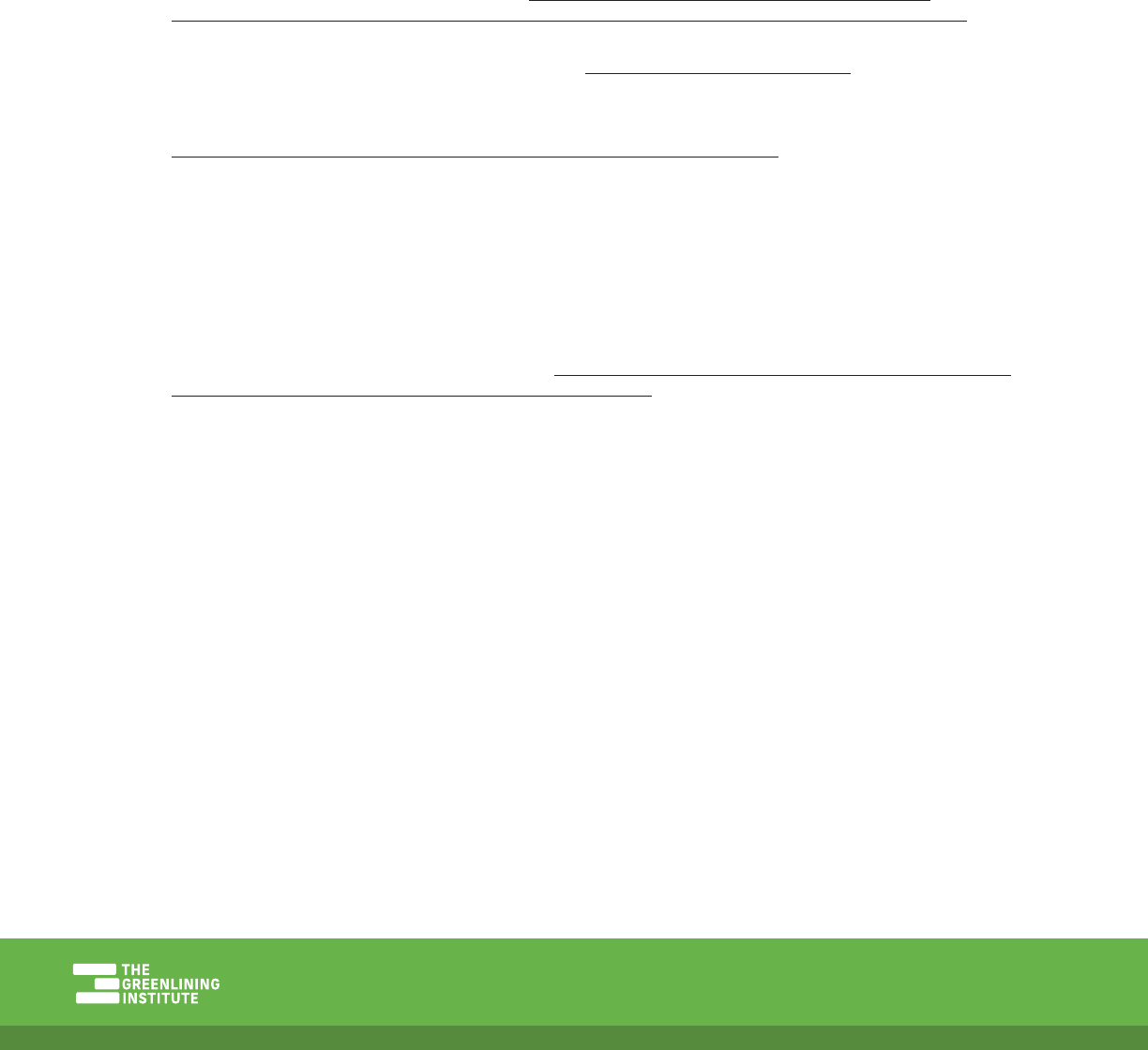
61Home Lending to Communities of Color in California | MARCH 2023
18 Martinez, Emmanuel, and Lauren Kirchner. “The Secret Bias Hidden in Mortgage-Approval Algorithms – the Markup.”
The Markup, 25 Aug. 2021, https://themarkup.org/denied/2021/08/25/the-secret-bias-hidden-in-mortgage-approval-
algorithms.
19 FSC Majority Sta, “The Future of Banking: How Consolidation, Nonbank Competition, and Technology are Reshaping
the Banking System,” US House of Representatives, Committee on Financial Services, September 24, 2021, https://
financialservices.house.gov/uploadedfiles/hhrg-117-ba15-20210929-sd001.pdf
20 Orla McCarey, “Nonbank Lenders Are Dominating the Mortgage Market,” Wall Street Journal, June 22, 2021, sec.
Markets, https://www.wsj.com/articles/nonbank-lenders-are-dominating-the-mortgage-market-11624367460.
21 “Signs Point to More Bank-Nonbank M&A in 2021,” American Banker, January 27, 2021, https://www.americanbanker.
com/news/signs-point-to-more-bank-nonbank-m-a-in-2021.
22 FinTech lending refers to loans delivered through online and digital platforms.
23 Board of Governors of the Federal Reserve System, https://www.federalreserve.gov/econresdata/notes/feds-
notes/2015/eects-of-the-ability-to-repay-and-qualified-mortgage-rules-on-the-mortgage-market-20151229.html
24 BCFP Data Point Submitter, “An Updated Review of the New and Revised Data Points in HMDA: Further Observations
Using the 2019 HMDA Data,” SSRN Electronic Journal, 2020, https://doi.org/10.2139/ssrn.3786976.
25 For the state and regional demographics, Other represents either individuals that identify as two or more races or that
identify as a race that was not collected by the 2021 American Community Survey.
26 https://knowledge.luskin.ucla.edu/wp-content/uploads/2021/03/NAPACD-REPORT.pdf
27 Compliance Technologies, Lending Patterns Soware
28 Includes all Asian groups tracked by the American Community Survey that were not explicitly listed in the table.
29 Ange-Marie Hancock Alfaro, “Report: California’s Women of Color Face Extra Burdens from Housing Crisis | California
YIMBY,” 2019, https://cayimby.org/women-of-color-report/.
30 Karan Kaul and Ted Tozer, “The Need for a Federal Liquidity Facility for Government Loan Servicing,” The Urban Institute,
July 2020,
31 Laurie Goodman and Janneke Ratclie, “The Tight Housing Market Boxes Out Government-Insured Borrowers, Widening
Homeownership Gaps,” Urban Institute, June 16, 2021, https://www.urban.org/urban-wire/tight-housing-market-boxes-
out-government-insured-borrowers-widening-homeownership-gaps.

info@greenlining.org
410-533-1203 (c)
360 14th Street, 2nd Floor, Oakland, CA 94612
greenlining.org
